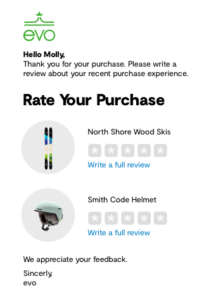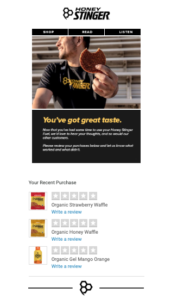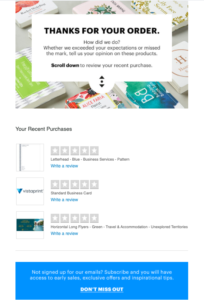If there’s one thing we’re the experts on, it’s Ratings and Reviews. Which is why we’ve literally written the (digital) book on it.
We have created this Guide to enable you to optimize your Ratings and Reviews strategy for 2023. It’s rammed full of practical steps you can apply today, all through the lens of what we know – through our own extensive data – consumers are looking for right now.
Contents
Ratings & Reviews in 2023
How important are Ratings and Reviews?
Ratings and reviews allow customers to share their experience with a product or service, and give it an overall star rating.
Shoppers rely on this content to make more informed purchase decisions. In 2021, ratings and reviews were defined by consumers as the top factor impacting purchase decisions over the past year, surpassing price, free shipping, brand, and recommendations from family and friends.
Now, consumers tend to change their opinions due to a myriad of factors – the economy, their individual purchasing preferences at any given time or even the day they’re asked. So this is unlikely to conclusively remain the case for ever more.
But – as a reviews vendor – this was the first time we had observed such a trend and it’s testament to growing reliance on reviews to generate purchasing decisions.
Ratings & Reviews Have Always Been Important. They’ve Become Even More Important.
This trend of the growing importance of Ratings and Reviews is highlighted in various different research projects we have completed in recent times.
Consumers rely on them to such an extent that the percentage who consult product reviews when shopping online is 99.9% (yes, you read that right). 98% now think of them as essential when considering products online, up from 86% eight years ago.
Now, there is often a difference between what people say and what they do. But the conversion metrics back this up too.
Reviews in an Economic Downturn
At the start of 2023, the economy is a hot topic due to hyper-inflation, mass job layoffs and significant uncertainty. Naturally at times like these, budgets become heavily scrutinized.
So the inevitable question for brands and retailers is: where should we invest at times like these?
Not surprisingly, price shot up to the number one determinant of purchase decisions for 2023 (the above responses are based on preferences during the 2022 Holiday season). However, when it comes to other marketing and brand initiatives, ratings and reviews stand head and shoulders as the most valued by shoppers.
Reviews Through the Customer Journey
Digital Impact of Reviews
As demonstrated above, ratings and reviews clearly have significant on-page conversion impact – that is the decision made by a shopper while on a product page on whether to purchase an item. But they also have a notable impact on driving visits to these pages in the first place.
Regardless of the exact route taken during the customer journey, reviews lead to significantly more traffic.
In-Store Impact of Reviews
There has been much discussion about how customer journeys are no longer linear, involving multiple touchpoints across different channels.
In many cases, in-store shoppers are doing plenty of research before making an in-store purchase.
In fact, 99% research products online before setting foot in a store. In addition, a large portion of consumers – 92% – pull out their phones to do research while shopping in a physical store location. Though shoppers of all generations do this, younger consumers tend to do it more frequently.
So it is perhaps no surprise that 84% look for positive ratings and reviews when considering in-store purchases.
What does a good ratings and reviews footprint look like in 2023
Review Volume
We get asked a lot: how many reviews do I need to be successful? The answer is: it depends. Ultimately, this will be dictated by the channel you are looking to stand out on and what you are trying to achieve.
However, the general rule is the more, the better.
Review Volume Impact on Traffic
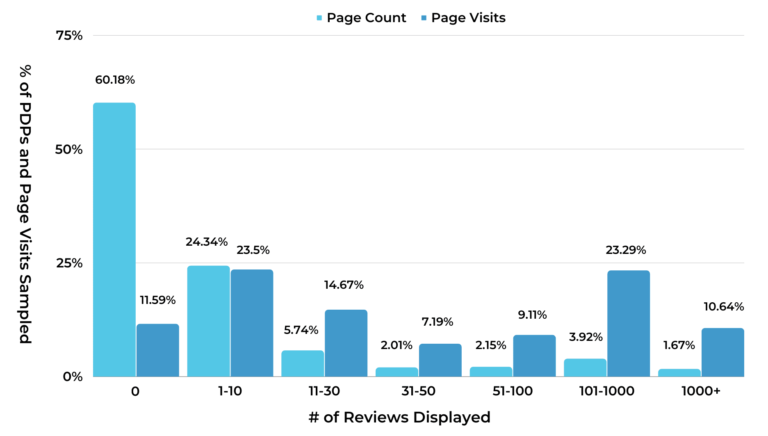
As demonstrated above, product pages with zero reviews account for 60.18% of all product pages on the internet but only 11.59% of all page views. Conversely, those with more than 1,000 reviews account for 1.67% of all product pages but 10.64% of all page views.
Review Volume Impact on Conversion
And we see the same “more is merrier” philosophy when it comes to on-page conversion.
Not every business will have the resources to collect 5000+ reviews. But there are significant lifts in each of the ranges so focusing on review collection should always be a priority.
Average Star Rating
Aside from the review count on a product, the average star rating is another key element consumers look for.
Star Rating Impact on Traffic
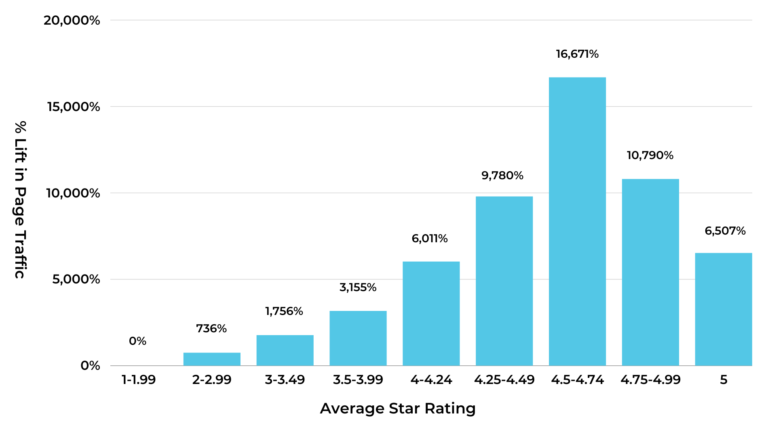
Average Star Rating Impact on Conversion
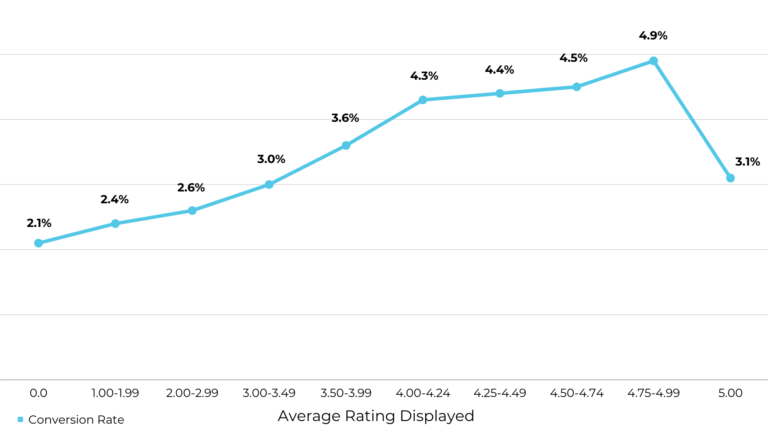
The sweet spot for conversion and traffic is an average rating of 4.5 – 4.99. Interestingly, pages in the 4.5 – 4.74 range attract more page views than those in the 4.75 – 4.99 range but the trend is reversed for on-page conversion.
The takeaway here for ecommerce practitioners wondering what targets they should set themselves: anything above 4 stars is good, 4.25 stars better, 4.5 stars better still and 4.75 stars the “North Star” goal.
All the while, you need to underpin any targets you do set yourself with the context of the specifics of your own business (e.g. vertical you operate in and competitors you’re up against, pricepoint of your product, etc). Ultimately, consumer expectations – which are a big part of how shoppers approach submitting ratings and reviews – are dictated by a number of factors that are likely unique to your business.
These results make one thing completely clear: consumers pay attention to the average rating. That might sound obvious in and of itself but remember star ratings are rounded to the nearest half star – in other words, both a 4.75 average rating and a 5.0 average rating will appear as a 5 star on a product page. There is a significant difference between the conversion rates in both of these bands. This means that shoppers clearly look beyond the star visual when deciding whether to purchase a product.
One finding – again – is clear and unmistakable. Consumers don’t trust 5-star average ratings. This supports much of our research: we have found a sizable proportion of consumers are suspicious of perfect 5-star ratings, including 46% of shoppers overall and 53% of Gen Z shoppers.
Review Recency
Recency is a MAJOR consideration for consumers.
Nearly all – 97% – of consumers consider review recency to be at least somewhat important when weighing a purchase decision:
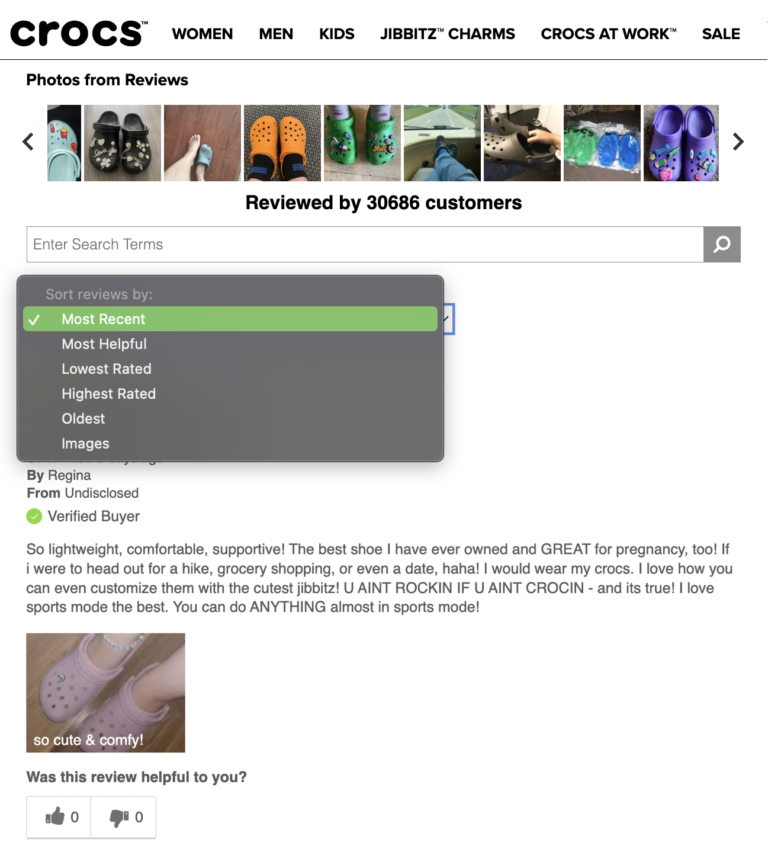
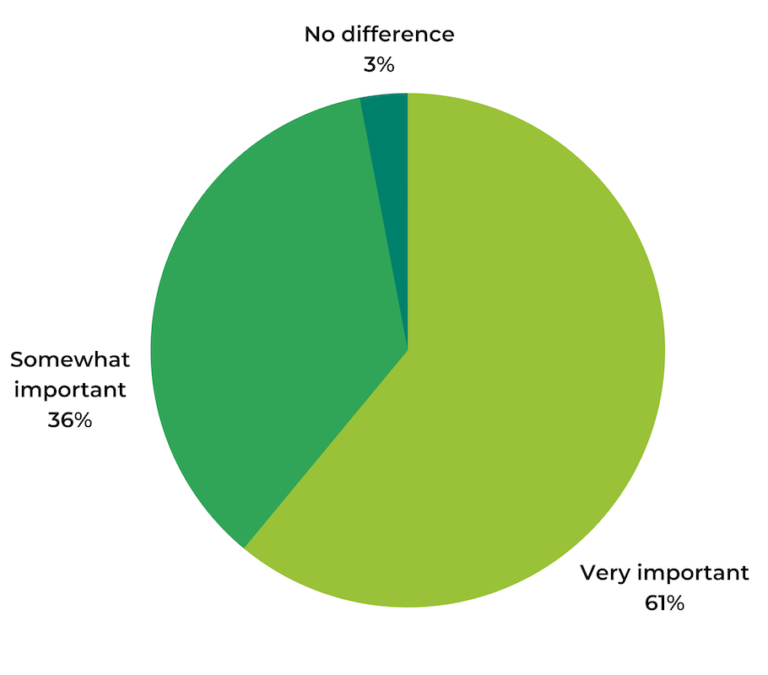
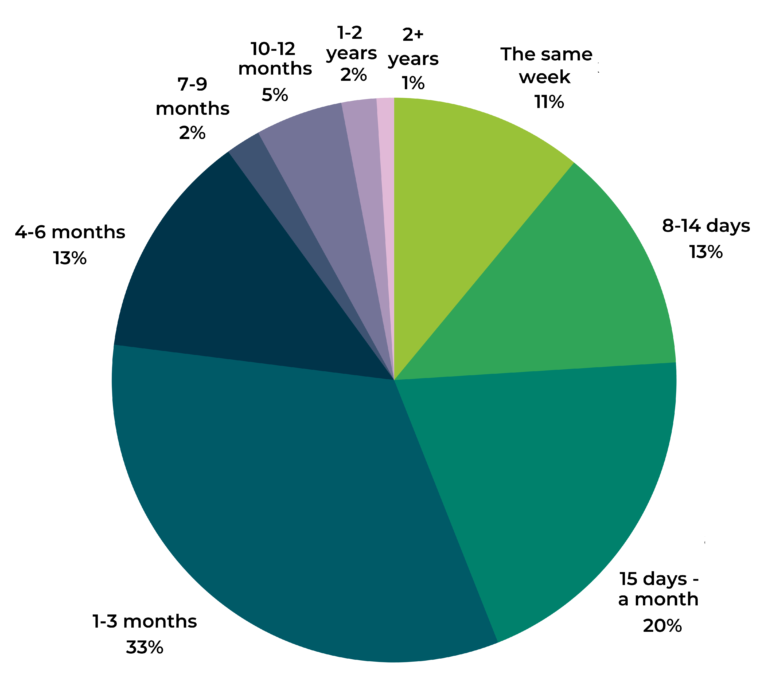
When it comes to the recency of reviews, consumers have high expectations. Brands and retailers must make it a priority to consistently generate a steady stream of reviews so shoppers can always find the fresh content they’ve come to expect.
Consumers value review quality
Review quality – the depth of specific information and context included within a review – is a key consideration for many consumers.
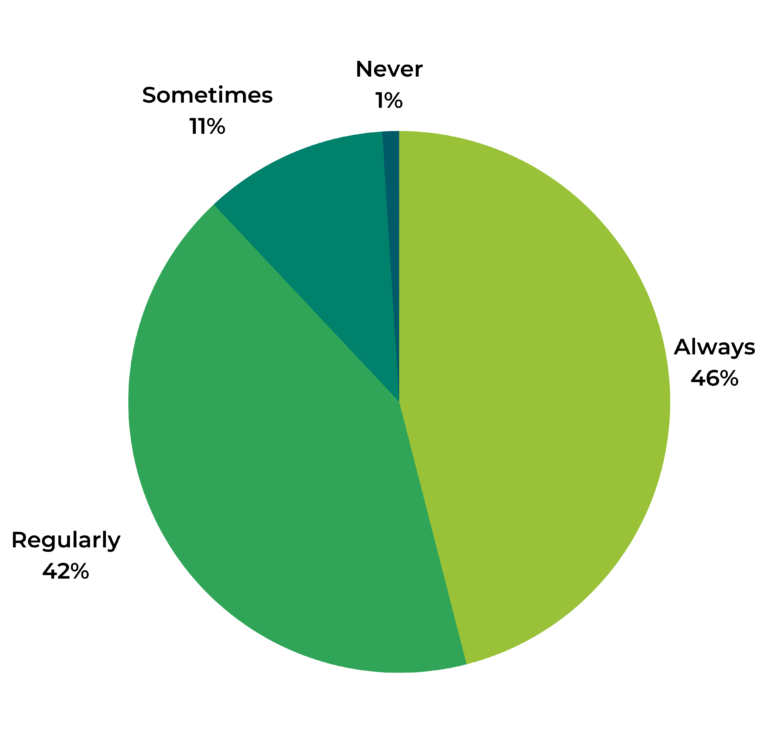
This begs the question: why? And what information are they looking for? The answer to this is: a lot of different things.
When it comes to the information consumers actually value in the review itself, again there are many.
The key takeaway from this is that you should seek to collect – as much as possible – quality reviews in addition to volume.
Imagery and Video
Shoppers want user-generated image & video more than ever
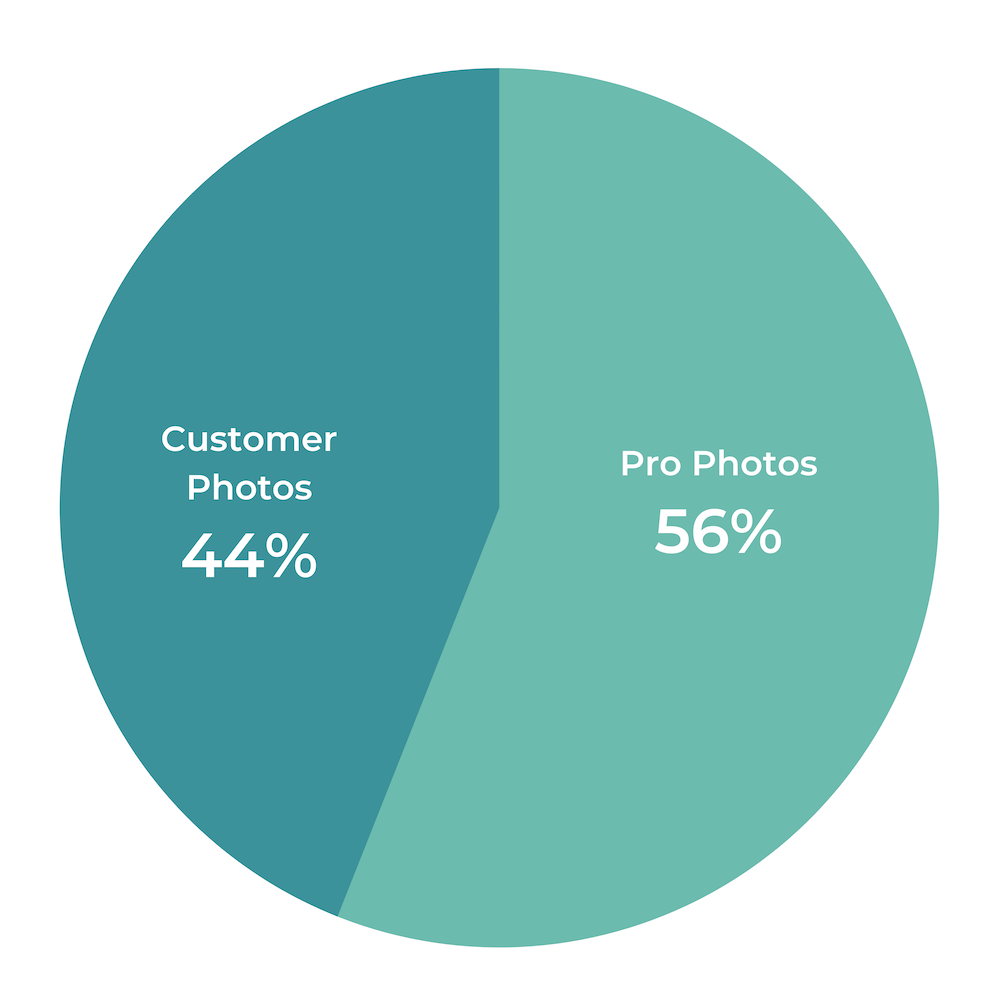
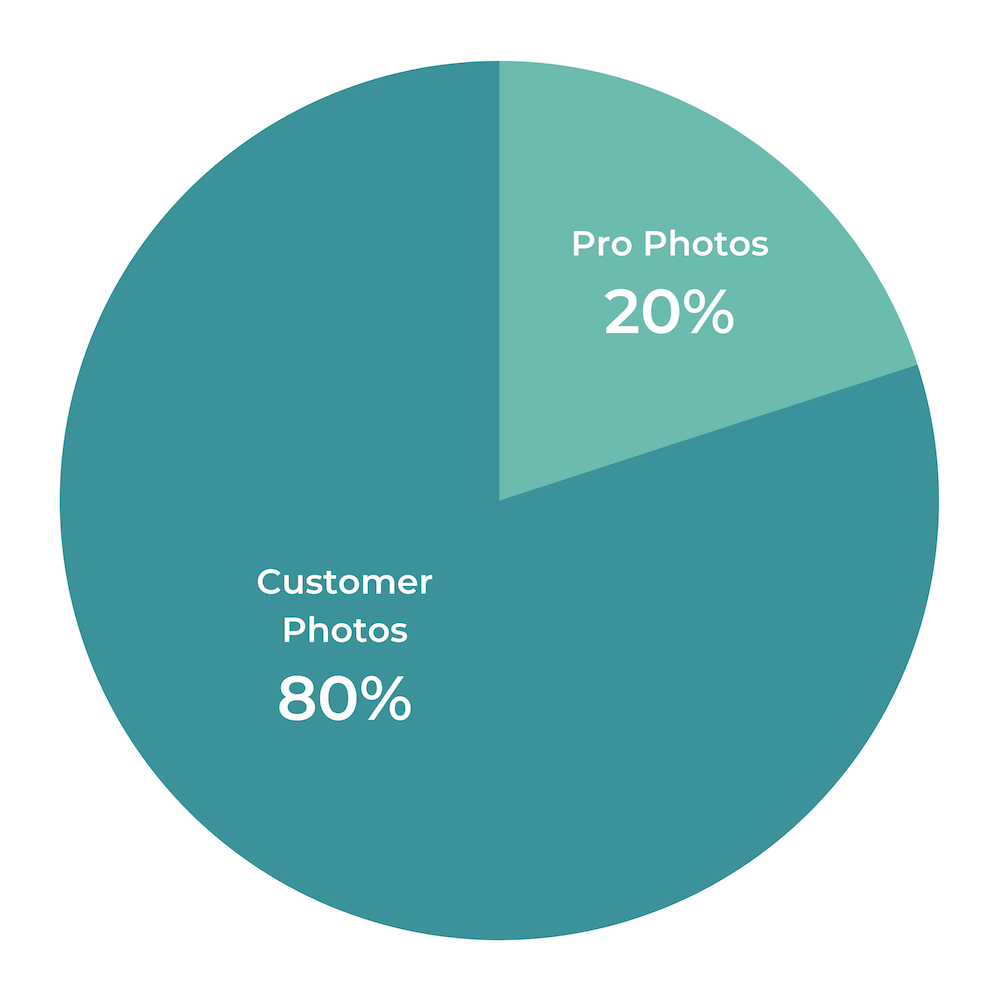
Online shoppers depend on visual content – including photos and videos – when making purchase decisions. But not just any visual content will satisfy their needs. A staggering 99% of consumers look for visuals submitted by other consumers prior to making a purchase.
Imagery and video provide exceptional real-life examples of the product in actual everyday use. How does it hold up under the typical strain customers put it under? Does it look, feel and smell as described? Is performance in line with, worse or better than expected?
Visual media enables each of these questions to be answered with precision and in great detail. In doing so, it generates exceptional authenticity and trust. So aim as much as possible to incorporate visual media into your UGC strategy.
What Information Should the Ideal Customer Review Incorporate?
When thinking about how to generate review content that will convert the best, always remember the purpose of displaying user-generated content is to build buyer confidence.
Reviews are a great vehicle for building confidence with customers by delivering an authentic depiction of your products.
Building a “perfect review” and considering all the elements entailed is therefore grounded in this overall concept. How do you hone and elevate the trustworthy voice of your customers?
From our experience, a perfect review typically incorporates the elements highlighted below.
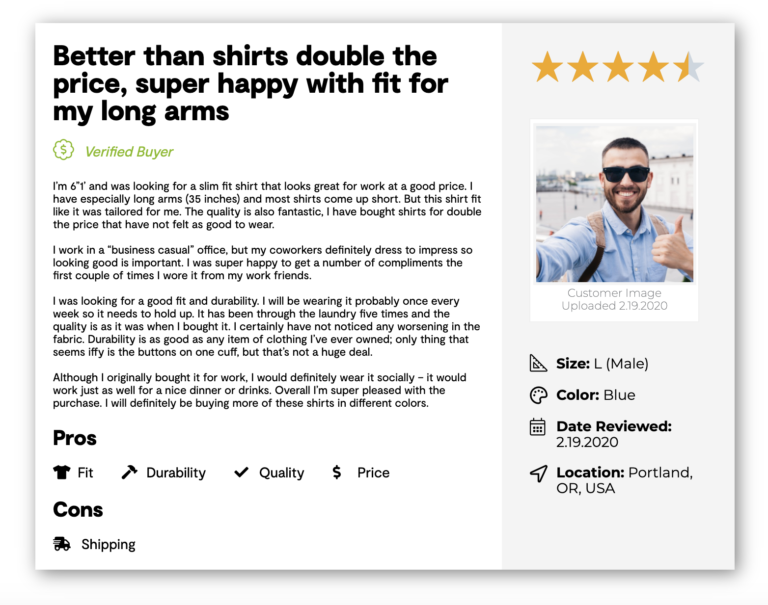
Five star reviews are ideal but consumers value authenticity above all.
Real-life accounts of use cases add value and color that is critical to the buying decision.
Reviews longer than 500 characters are proven to generate a greater number of conversions.
Authentic imagery and video “out in the wild” adds unrivaled credibility.
Specific demographic detail to make content relatable and relevant.
Review Collection
Making the ask
The first step to maximizing review collection is asking.
You may get lucky and capture some content without, but most people need at least a gentle nudge. Others may need considerably more.
The more creative you can get, the more successful you are likely to be. But here are some of our top tips.
Email request
A post-purchase email asking for a review is a staple for most brands.
And with good reason: it’s the most important review collection technique. From our experience, it generates up to 80% of ALL ratings and reviews content dependent on the brand.
Although this should go without saying, they must be personalized based on the specific purchase.
They should also be simple and to the point. No fluff. Be very clear about the purpose of the communication and in your call to action.
Here are some good examples.
All three of these follow-up review request emails are on brand, simple and to-the-point – critical factors in generating the desired outcome.
- Compelling subject line with less than 55 characters
- Personalized
- Mobile-friendly
- Short and sweet
- 16–18 point font
- Single column layout
- Clear call to action
- Image and link to product
- No other marketing or sales call to action
Enable review submission from within email
There are typically two options when it comes to actual collection of the review content:
- Dynamically from within the email itself
- In a form on your website
Here’s an example of an “In-Email” review submission capability from Naturepedic.
This obviously means fewer clicks and a more seamless review submission process. However, content generated this way is typically less detailed and shorter.
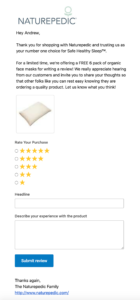
Review Collection Form
Let’s assume you are not enabling reviewers to provide content in the email itself. In which case, you’ll be directing shoppers to a form on your site to provide a review. Again, you’ll need to be very clear in your ask. Provide obvious direction to deliver the content you need where you need it.
Although there is clear variation across different categories, basket size data highlights how each individual online purchase averages 2.73 items.
So – when it comes to review collection – you should also enable consumers to write reviews on multiple products without leaving or refreshing the page. This encourages far higher collection rates.
As in this example: load up all of those products in your review form so customers can provide content without leaving the window or refreshing the page.

Collect Ratings & Reviews via Text Message
Increasingly, brands are also collecting ratings and reviews via text message. Why? It’s deemed by many to be quicker and easier. This methodology particularly resonates with younger generations who are not as wedded to email.
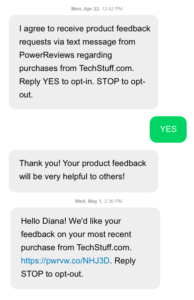
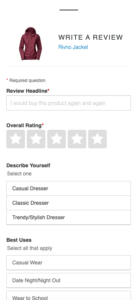
Maximize Review Volume and Recency
We already talked about the importance of review coverage across all your products. And – beyond that – how generating a high volume of reviews can have a big impact on conversion. We also explored the importance of ensuring shoppers can always find recent reviews for your products.
Here are some ways you can generate a steady stream of reviews so consumers can always find a high volume of fresh content for the products they’re considering
Time the ask appropriately
You can’t ask for a review as soon as the item has been purchased. Customers need time to 1) receive the product and 2) try it out.
The ideal timing is also dependent on the type of product the consumer purchased. We therefore typically provide the following guidelines for timing review request emails:
Seasonal Products: 7 Days
There’s a pretty short window when folks will purchase seasonal goods, such as school supplies or holiday decorations. Since we know that reviews drive sales, you’ll want to get reviews for seasonal products as quickly as possible so you don’t miss the season. Send post purchase emails for seasonal goods within seven days.
Perishable Goods: 14 Days
Perishable goods—such as cut flowers and fresh fruit and vegetables —have a short shelf life. Send post purchase emails for these products within 14 days. If you wait any longer, the product will be out of sight and out of mind.
Soft Goods: 14 Days
Soft goods are items that are immediately consumed or have a lifespan of three years or less, such as clothing and cosmetics. As with hard goods, you’ll want to give your customer the opportunity to try out the product before writing a review. But don’t wait too long, because the lifespan of soft goods is much shorter than hard goods and the purchase won’t be top of mind for long.
Hard Goods: 21 Days
Hard goods are durable items that don’t wear out quickly, such as refrigerators, washing machines, and computers. It’s a best practice to wait 21 days before sending a post purchase email for these types of products.
After three weeks, the customer will have enough time to get a good feel for the product so they can write a well informed, thorough review.
Ask more than once
Although we’d all love to only make the ask once to get the desired results, that’s also not realistic. Our research found that about a third (32%) of shoppers need to be asked twice or more before they’ll submit a review.
As a best practice, send TWO email requests. As previously mentioned, studies show that up to 80% of reviews originate from post purchase emails. If you don’t send more than one email, you risk wasting the best opportunity to boost review volume and recency.
Prioritize products that need it
Review coverage – the concept of generating review content across your entire product catalog – is a big concern for pretty much every brand and retailer.
Where possible, look to prioritize collection for products with few (or no) reviews. Remember: the higher the review volume, the larger the impact on conversion!
In this example, the products are ordered accordingly. Best-in-class technology will do this automatically.
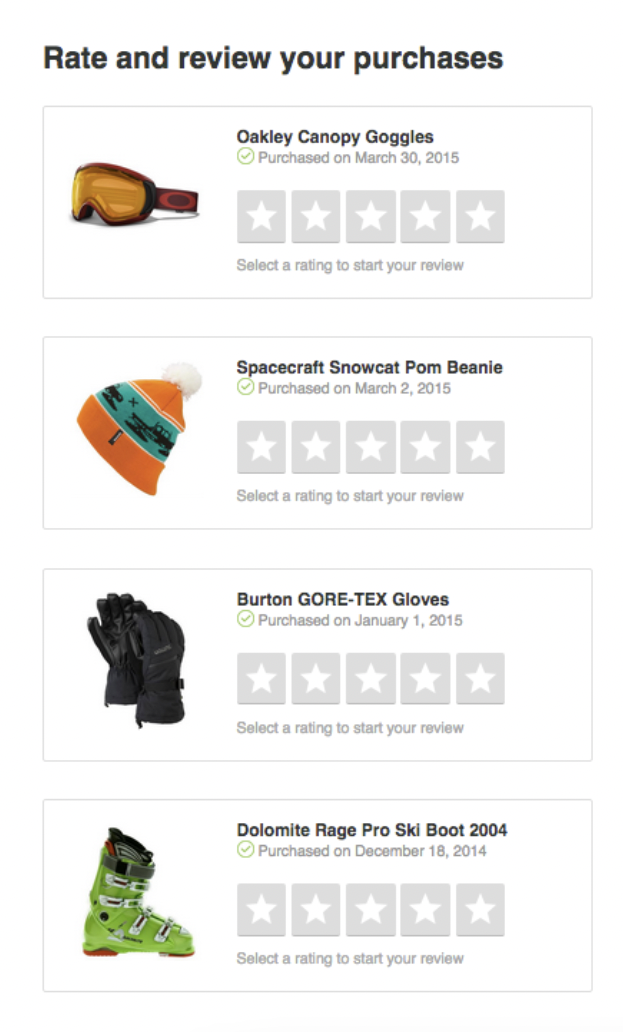
Incorporate sweepstake incentives
A sweepstakes is an incentive to be placed in a raffle-style drawing for a cash prize or similar in exchange for providing a review.
Although not appropriate for all brands, they can work great in the right circumstances.
Here are a couple of examples of how you would incorporate this incentive in one of your review submission request emails.
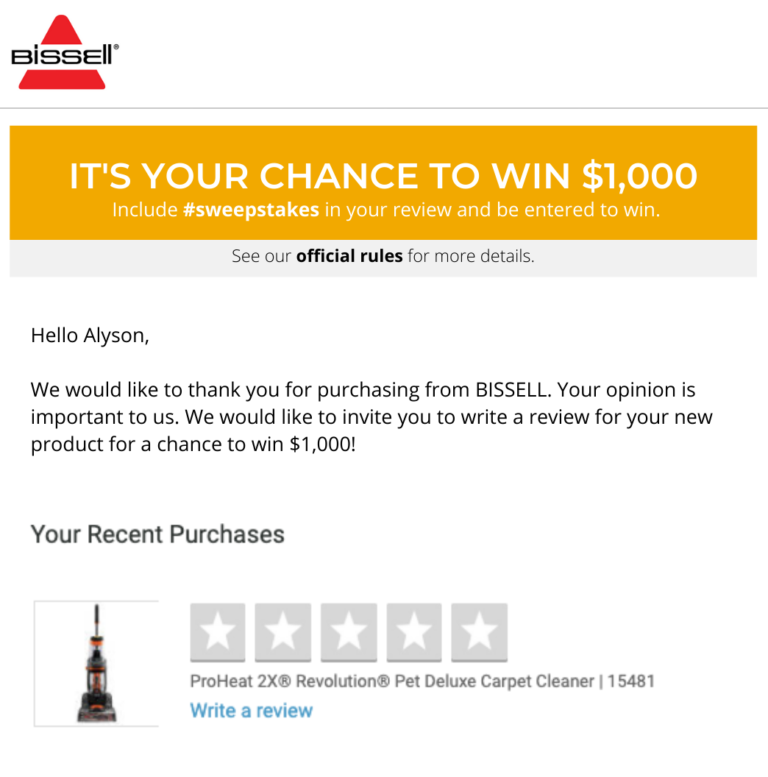
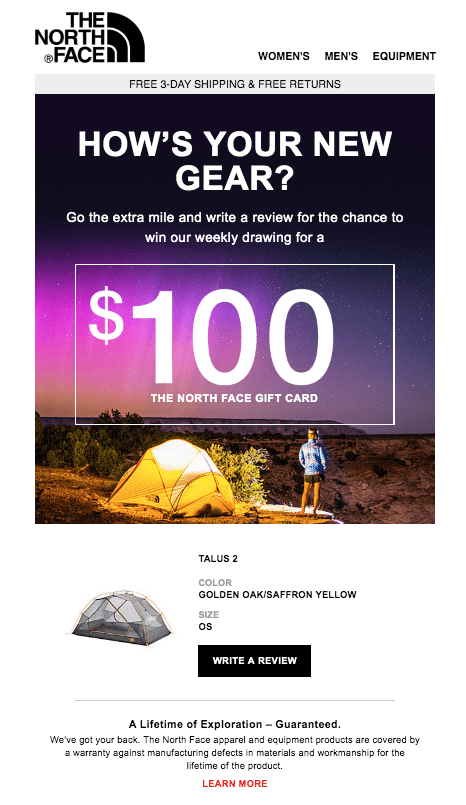
Incorporate in your loyalty program
You may not want to provide cash incentives. If so, consider integrating into your loyalty program. It’s an effective way to generate more content, as our research found that 59% of consumers would be motivated to write a review if they received loyalty points with the store or brand in exchange for their feedback.
Many brands offer up loyalty points in exchange for review content.
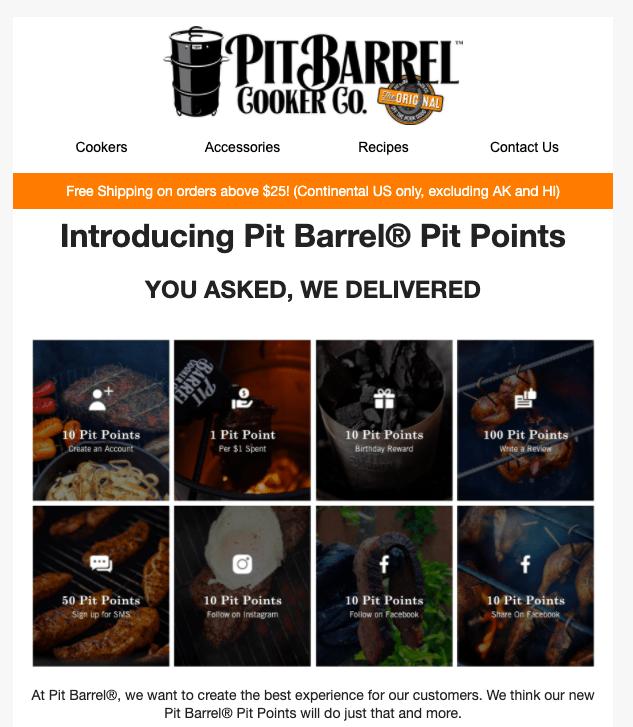
This can be super powerful in creating engagement with your brand, generating more loyal customers and generally making them feel part of a bigger community.
What they did
- Added a second follow up email post-purchase
- Enabled ability to provide multiple products in the same form
- Added a sweepstakes entry
The results they saw
- Initial jump from 1,000 to 10,000 reviews in a month
- Continue to generate 8,000 reviews monthly
- These new techniques led to increased review completion by 300% and review volume by 147%.
Ask for review content in other communication channels
Dedicated follow-up emails are the most direct and effective review collection method.
But you routinely communicate with customers across a whole host of methods and channels. Brands are increasingly leveraging these to collect review content.
Run a product sampling campaign
Product sampling campaigns – sending a product to a group of people who agree to write a review or create a social post in exchange – are a really effective method for generating reviews from a very targeted persona.
Our research found that 86% of consumers indicate they’d be motivated to write a review if they received a free product sample. And to back up that research, we’ve found that our own product sampling campaigns yield a 86% response rate. In other words, 86% of shoppers who receive a free sample go on to write a product review.
Brands and retailers find they are particularly effective in specific scenarios:
- Product launches
- Filling existing glaring gaps
- To keep review content fresh (remember: recency matters!)
- Generating content quickly to in advance of selling a seasonal product
Product sampling is a complex process made up of a number of critical elements. You need to be clear on your goals from the outset and this will determine the scale of the project.
Targeting the right audience, fulfilling the campaign and then ensuring your samplers provide the review content you’re seeking is also obviously super important.
Our product sampling guide provides a detailed step-by-step breakdown.
Problem
Bissell wanted to launch its latest product line complete with pre-existing customer endorsement and validation.
Solution
Bissell believes its vacuums are the best in the industry at tackling pet hair, so they embarked on a sampling campaign to target pet owners frustrated by other vacuums.
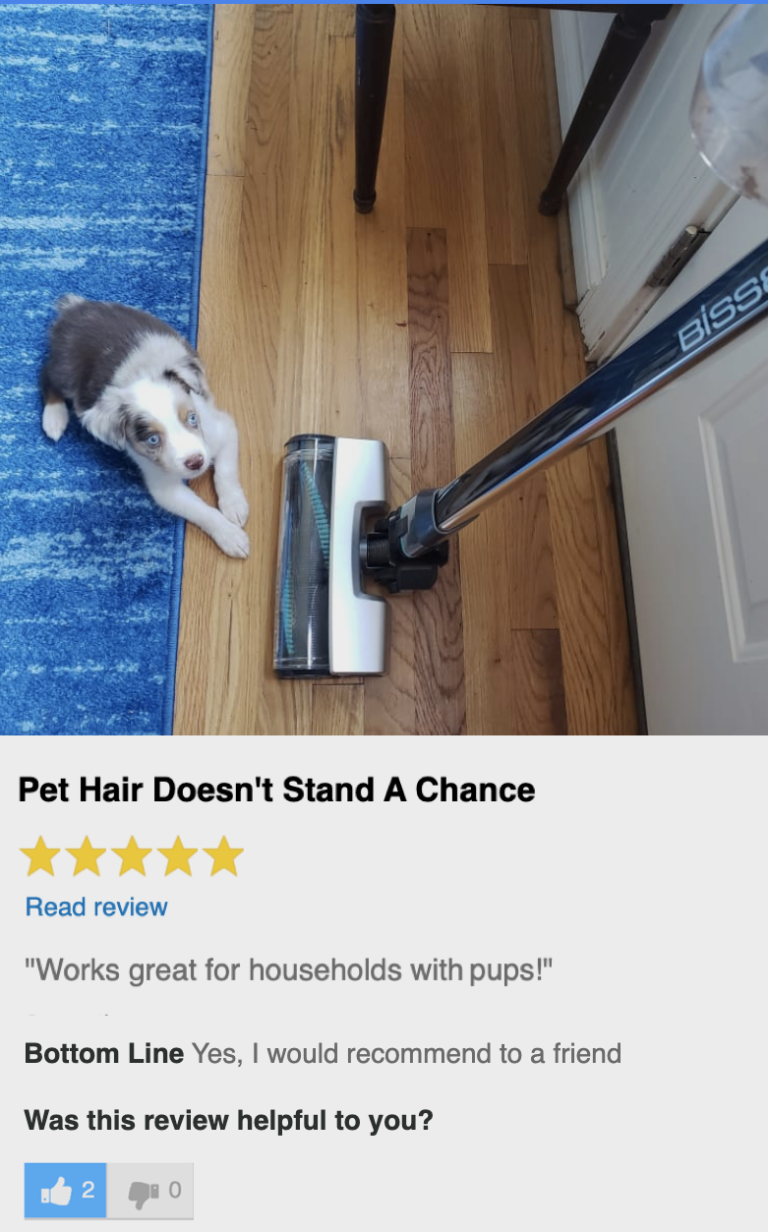
Result
This resulted in a review coverage of 90% across its product catalog and the collection of over 2,000 customer-generated images. As you can see from this image, many of these included dogs – a vivid illustration of the value proposition the company sought to communicate.
Tap into a powerful database of online and in-store purchases
While ecommerce continues to grow, the majority of purchases are still made in a brick-and-mortar store. So if you’re not soliciting reviews from both in-store and online shoppers, you’re missing out on a big opportunity to generate a ton of content.
One way to do this is to leverage a service like “Receipt. Review. Collect” from PowerReviews. This solution allows brands to tap into a consumer database of online and in-store purchases across more than 10 million members. Brands can then generate reviews from these verified purchasers. Tom’s of Maine used the program to grow review volume by 18,600% in 21 days (yes, you read that right).
Optimize review quality
What to Include in Your Review Collection Form
Optimizing your Review Collection form is key to increasing review quality. But what exactly should you include in yours?
There’s no easy answer. It really depends on your industry and what works for your brand.
The first step is to determine the types of information that will be useful to consumers considering your products. This is data you’ll want to incorporate into your review display, so you’ll want to include questions that address it in your Review Collection form. In addition, consider data you’ll leverage internally to improve products, experiences, or internal operations.
That said, there are common elements across the most effective Review Collection forms. In this guide, we’ll explore the elements you’ll want to consider when building (or optimizing) your Review Collection form, based on our experience helping more than 1,000 brands and retailers collect and display high quality reviews.
Remember: best practices (especially those for your industry) are a great place to start. Then, you can measure and optimize from there to get the best results.
The Basics
When it comes to Review Collection forms, there are five basic questions to include. Think of these questions as the foundation from which all Review Collection forms are built. They’re must-haves.
At the end of the day, it’s up to you to determine which of these fields are required and which (if any) are optional. However, it’s best practice to make all five fields required. This is especially true for brands that syndicate their review content to retailers. That’s because all five are required for syndication.
1. Rating

The star rating a shopper assigns to a product, on a scale of one to five.
Star ratings are really important to shoppers; 77% say they consider the average star rating when reading reviews. So it’s important to collect them in your Review Collection form
Typically, a product’s average star rating is displayed at the top of the product page – alongside the number of reviews for the given product. This review snippet helps the shopper determine whether to explore the product further or look for other options.
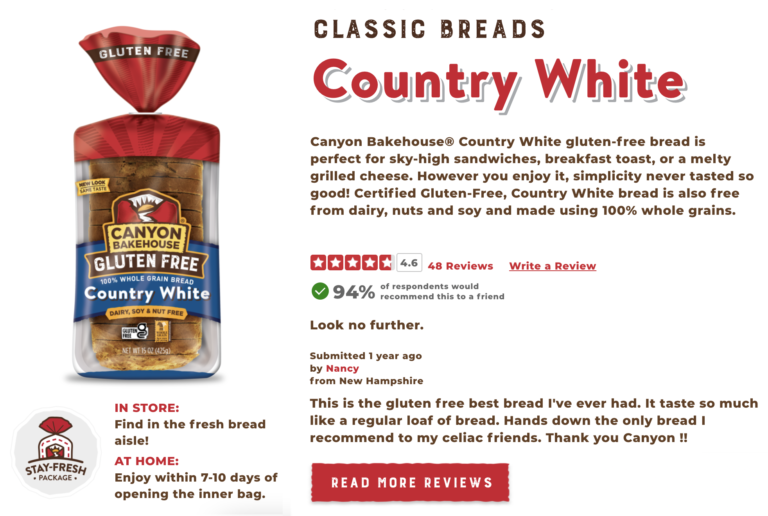
2. Headline
The headline of a review is kind of like the title of a book. It helps shoppers determine whether they want to read the review itself.
At PowerReviews, we require a specific headline when a shopper submits a review. Be sure this is a field you include in your Review Collection form.


Other vendors allow brands and retailers to instead publish the first few words and/or characters of the review in its place. We don’t recommend this because the headline acts as the customer’s opening thought/recommendation on which they can elaborate on as they write their review.
And then when the review is published, it’s also super informative in determining whether shoppers decide to read the review or not.
3. Comments
There’s no getting away from it: comments are the review. They provide the “why” behind the star rating. They offer reviewers the opportunity to share their specific sentiment(s) on the product under consideration.
Shoppers scrutinize this content to identify answers to questions on more intricate details that ultimately determine whether they buy or not. For brands and retailers, they also offer deep insight on customer sentiment specific to that product.
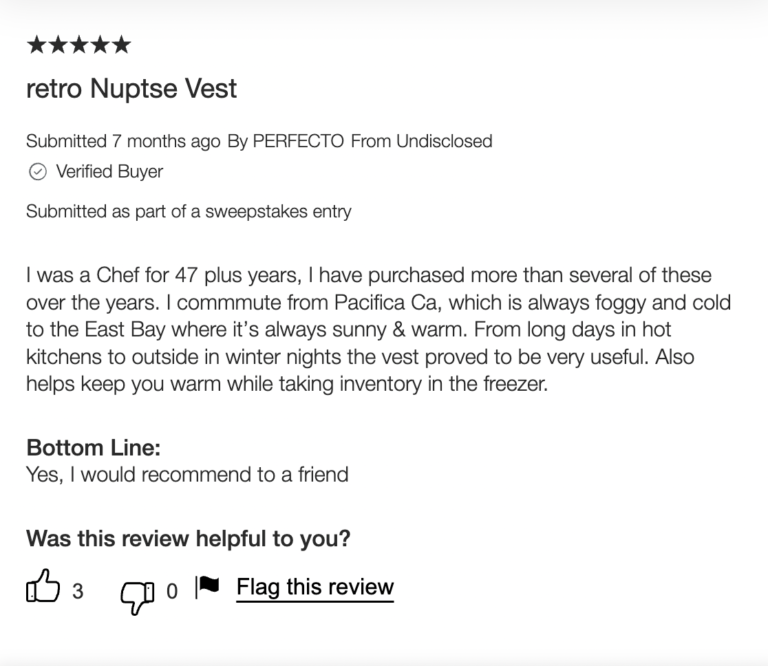
It’s important to collect this written commentary within your Review Collection form. In fact, we feel very strongly that this should be a required field on all Review Collection forms. Research tells us nearly all shoppers look beyond the basic summary information in a review to read the actual content at least sometimes.
That’s because comments provide context for star ratings – and can allow future shoppers to find reviews that speak to their specific needs, concerns, and use cases.
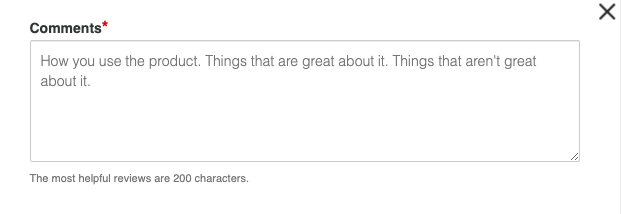
Later on, we’ll share some best practices for encouraging shoppers to provide longer, more detailed commentary in this field.
4. Nickname
A nickname is how a reviewer is identified and is typically displayed with the review to reinforce that it was written by a real person.
Because the bottom line is: Consumers value reviews because it’s content written by others like them, without any motive. Displaying the nickname adds a human element to the review.
As such, the nickname is a foundational field to include in your Review Collection form. Some brands request the first name and last initial – and others allow more freedom. It’s really up to you to determine what’s in line with your brand.

Worthy of note: PowerReviews enables you to change these headlines to be whatever you want. However, there is a balance to be struck: we are very careful to ensure the privacy of your customers and recommend not capturing a reviewer’s full name for this reason. With that being said, our sophisticated moderation techniques mean PII is extracted from a review before it’s published.
5. Location
Location is another important, basic element to include in your Review Collection form. Again, this information helps convey to future shoppers that this is a real review written by a real person.

In addition, geographical location can be helpful for shoppers looking for relevant content. This is especially true for certain product categories. For example, consider a Chicago-based consumer shopping for winter boots. They’re likely to value reviews written by other Midwesterners, as they experience a similar winter climate.
Review Meter
Remember when we said longer, more detailed reviews are more helpful to shoppers? Well, it’s a claim backed by data. A survey found that just about all (97%) of consumers seek out longer, more detailed reviews at least sometimes. And 68% say they do so always or on the regular.
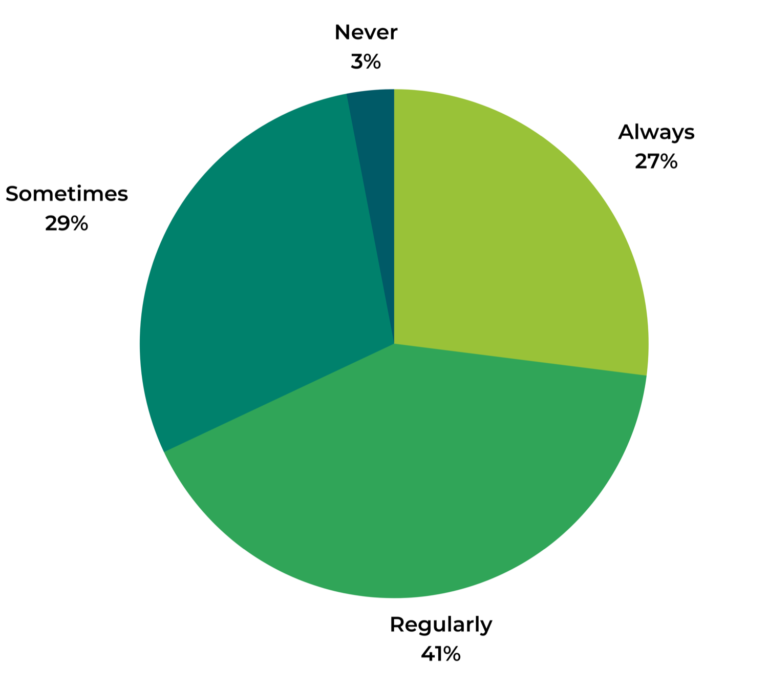
When reviewers provide a lot of keyword-rich details, future shoppers are more likely to find content that’s relevant to them. For example, a consumer with sensitive skin might seek out reviews for a cosmetic that specifically speaks to how it works for those with sensitive skin.
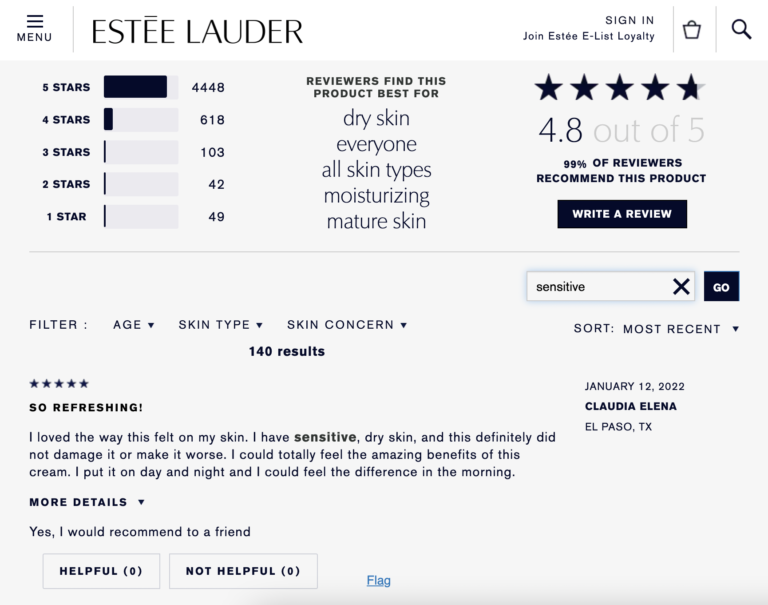
Including a review meter in your Review Collection form can help you generate more of those long, detailed reviews that fuel great purchase decisions.
Essentially, a review meter is an interactive character count that appears below the comments box in the Review Collection form. As the reviewer types, that little green bar grows. When the review reaches the ideal length (you choose what that is), the meter lights up to let the shopper know they’ve written a great review – and to keep going if they’d like. It’s super satisfying to the customer – and a powerful way to generate longer reviews.
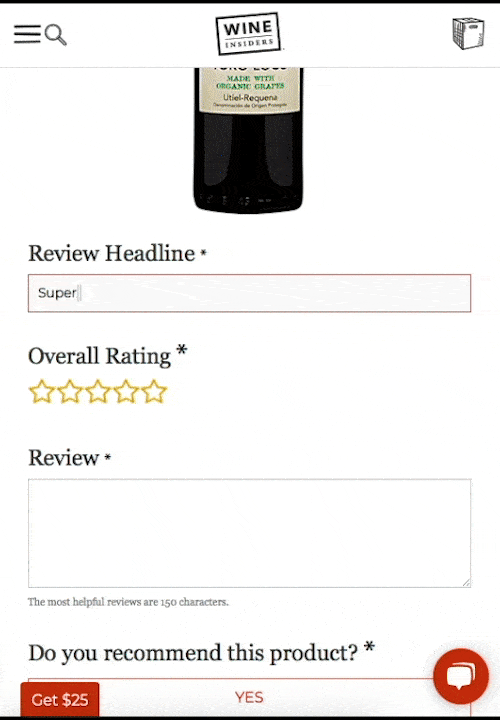
Helper Text
Writer’s block is a thing – for novelists and review writers alike. A consumer may be willing to write a review. But faced with that big blank comments box, they just don’t know what the heck to write.
The result? They abandon the process altogether. Or, they write a super short, less-than-helpful review.
One simple way to get the creative juices flowing (and get shoppers to write longer, more detailed reviews) is to include some helper text in the comments field. This text serves as writing prompts for the reviewer.
For example, the comments field of this Review Collection form for a skincare product asks the shopper to consider:
- How they use the product
- Things that are great about it
- Things that aren’t great about it
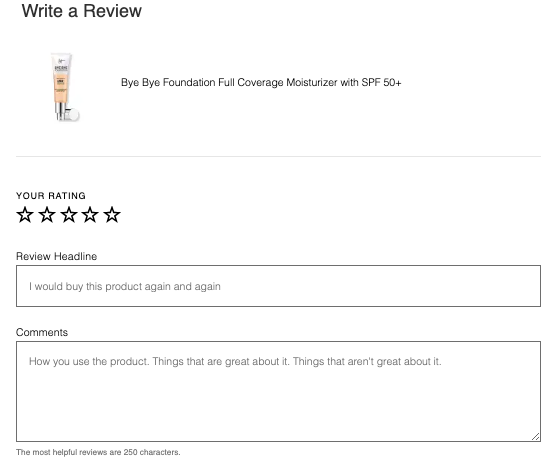
With PowerReviews, this can be completely customized. Maybe feedback from your customers highlights a desire for specific information about a specific feature of your product. With this text, you can capture more of this detail in your reviews.
Native Image and Video Collection
When consumers shop online (which they’re doing a lot lately), they don’t have the benefit of seeing and touching a product in person. Visual content, including photos and videos, helps bridge the gap.
Brand-provided photos and videos are helpful to shoppers. But increasingly, they want to see content from others like them. A survey found that 77% of consumers always or regularly seek out photos or videos from others who have purchased a given product.
As such, customer-centric brands make it a priority to prominently showcase user-generated visual content on their product pages. A common way to do this is to feature a visual gallery with shopper-submitted photos and videos.
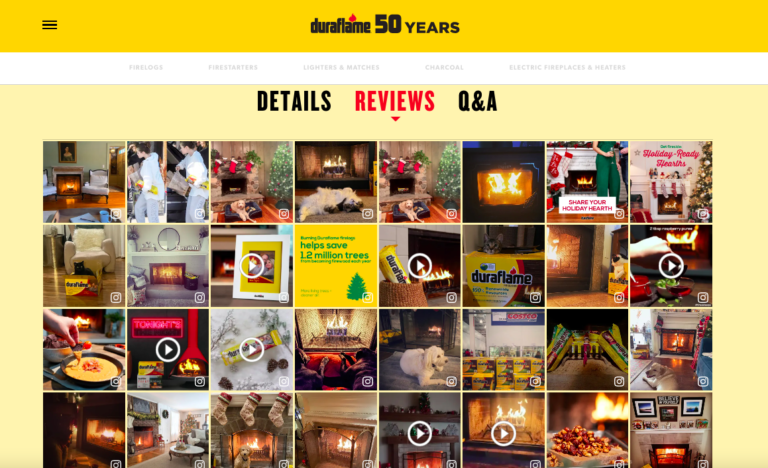
Brands who prioritize user-generated imagery reap some big benefits. Site visitors who interact with user-generated imagery on a product page convert at a rate that’s more than 106% higher than average!
But in order to display this content, you must first collect it. The best way to do this is through the Review Collection form.
If user-generated content is a priority for you (hint: it should be), then be sure to add a field to your Review Collection form that allows reviewers to easily submit it. Allow them to submit the media natively – or from their social media accounts.
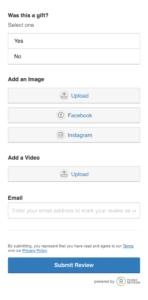
The Bottom Line
A review might be a few words long – or a few paragraphs. But at the end of the day, what the reader really wants to know is whether or not the reviewer recommends the product in question.
Many brands and retailers get this. It’s why they feature the percentage of reviewers that recommend a product at the top of their review display.
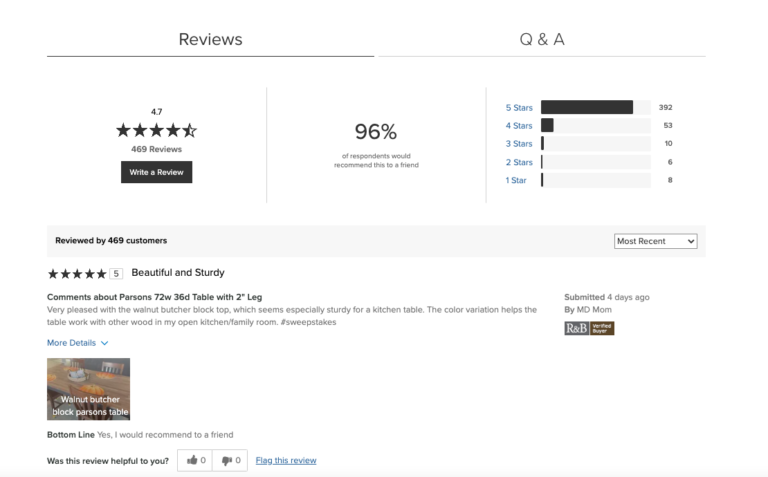
Where do brands and retailers get this aggregated data? You guessed it: their Review Collection form.
So, be sure to include a section in your Review Collection form that asks whether the reviewer would or would not recommend the product in question to a friend. Future shoppers are sure to factor in this information when deciding whether or not to explore the product.

Customized Questions
Up to this point, we’ve focused on key elements of Review Collection forms that are important across all product categories. For example, asking for a star rating or review comments is key – whether you’re selling jewelry or mattresses.
However, each industry and business is unique. That’s why it often makes sense to include additional questions on your Review Collection form.
How many questions should you add? The short answer is, it depends. Here at PowerReviews, we generally recommend adding between two and five additional questions. This allows you to gather the insights that matter to your business and customers, without overwhelming them (by the same token, the form can also be set not to include any additional questions if that is your preference).
So, what additional questions should you add to your Review Collection? Again, there’s no easy answer. You have to consider what data you (or your future customers) will actually use. Consider what data will fuel your review display, and what data you can leverage internally to inform product and customer experience optimizations.
In addition, your ratings and reviews provider should have expertise in your business and your industry. So be sure to ask for their guidance in terms of question quantity, as well as what questions to ask.
Remember: you never want to add questions simply for the sake of adding them. If a Review Collection form is too long (even if a lot of the fields are optional), you’re likely to see a high abandonment rate.
With all that said, here are a few types of questions you may want to consider adding to your Review Collection form.
1. Subratings
The star rating is a key component of a review. However, it requires customers to assign a single number to their overall experience with a product.
Sometimes, brands and retailers want to get more granular feedback about various elements of a given product, including quality, value, durability, and comfort. They do this by adding subratings fields to their Review Collection form.
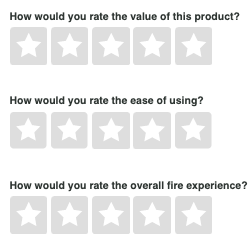
Displaying this feedback can help future shoppers better assess the product’s attributes. What’s more, this data provides businesses with insights about what shoppers like (and don’t like). Brands and retailers can use this data to fuel product improvements.
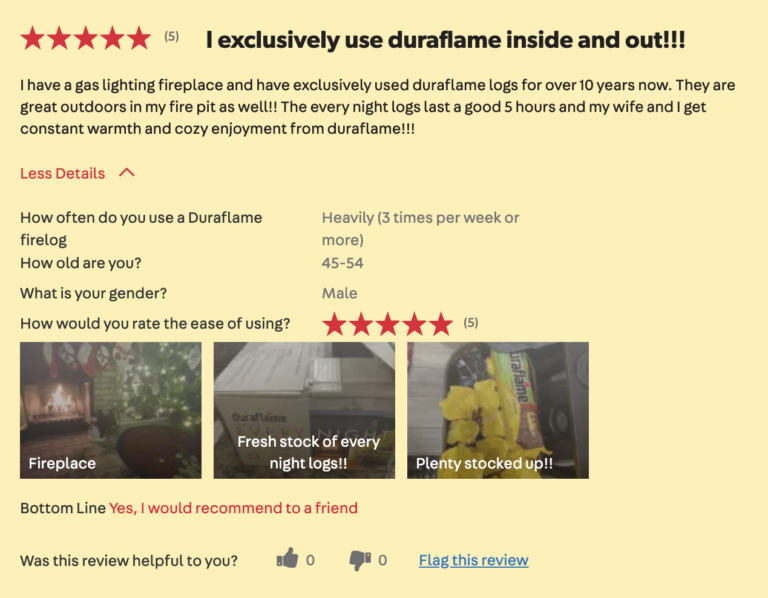
2. Size/Fit Questions
A survey found that 89% of apparel and footwear shoppers consider size and fit when considering an apparel or footwear purchase. But these factors are tough to assess when shopping online.
Of course, tools like size charts help. However, many apparel brands and retailers also provide aggregated, customer-provided size and fit feedback within the review display.
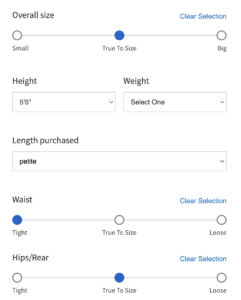
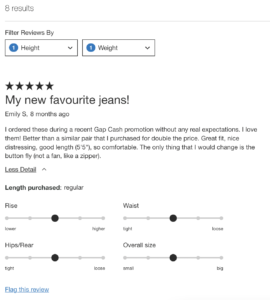
If you’re a brand or retailer that sells apparel and footwear, collecting size and fit information within the Review Collection form is a must. The size and fit information you’ll want to collect depends on the type of product. For example, an apparel brand may opt to collect overall fit and sleeve length feedback for tops and jackets, and waist fit for pants.
Displaying this information helps shoppers make better purchase decisions. What’s more, it can dramatically reduce returns, as size and fit issues are a top reason apparel is returned.
3. Service & Delivery Comments
Typically, product reviews focus on the product itself. However, some brands and retailers also want to collect feedback on other aspects of the customer experience – including service and delivery. This makes sense, as the experiences a customer has with a brand can be just as important as the product. As such, optimizing experiences can increase both conversion and retention.
Source: Salesforce State of the Connected Customer 5th Edition
If you’re looking to collect feedback on service and delivery, consider adding a service/delivery comments field to your Review Collection form. But remember: only collect this data if you plan to act on the insights it yields.

4. Tag-Based Questions
Some brands and retailers build interactive review snapshots that provide an overview of all reviews written for a particular product. For example, consumers landing on this product page can quickly determine the product’s pros, cons, and best uses – among other things. Shoppers can then click on any of these elements to hone in on reviews that speak to these specific factors. And research tells us that visitors who filter by these “tags” convert at a rate that’s more than 78% higher than average.
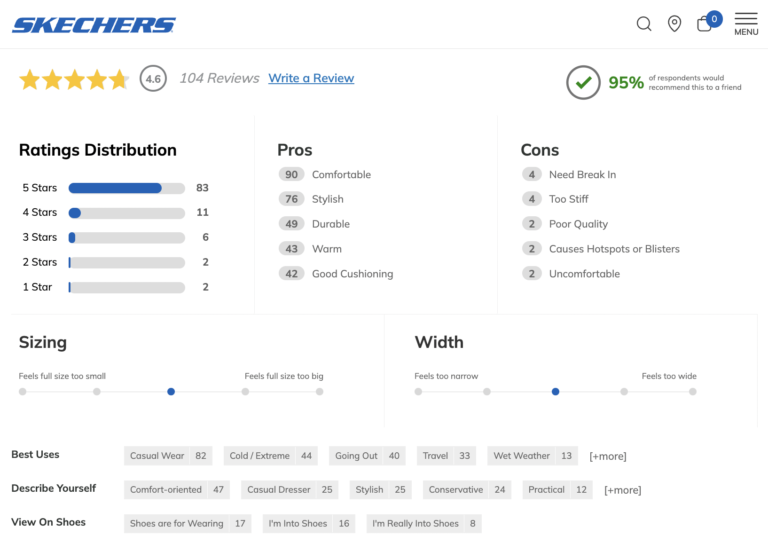
In order to display this aggregated information for your shoppers, you’ve got to collect it in your Review Collection form. Typically, reviewers are provided with a selection of answers for each question. For example, pre-populated pros for a pair of shoes might include attractive design, comfortable, stylish, breathe well, and durable. The reviewer can also add their own.
A further benefit of including pros and cons in this way is that they can help get a customer’s thoughts/juices flowing. As a best practice, these are typically served up before the review comment. This plants thoughts on the topics they may choose to cover subsequently. For example: if they regard “comfortable” as a pro, they might choose to elaborate on why in their review comment.
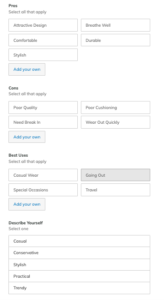
5. Merchant Specific Questions
There are certain tag-based questions – such as pros, cons, and best uses – that can be used in Review Collection forms across just about any product category. However, there may be other questions you may want to include in your Review Collection form that are specific to your brand.
For example, a skincare company might opt to include questions about the reviewer’s skin type and skin concerns. That way, the brand can add a feature to their display allowing shoppers to easily find content written by others with similar skin types and concerns.
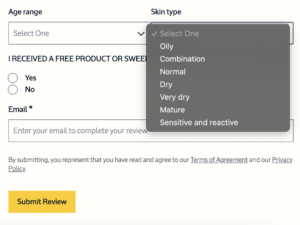
How do you figure out which merchant-specific questions to ask in your Review Collection form? Consider what information would be most helpful to shoppers trying to decide if your product is the right fit for them.
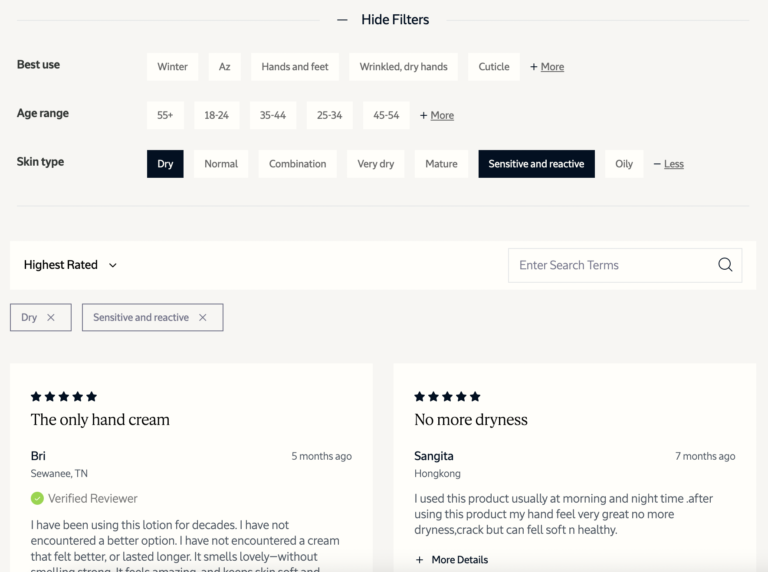
For shoppers, the ability to filter only on reviews that directly address a personally relevant problem or concern specific to them is very powerful.
As an example, think about skincare products: the capability to filter on reviews by users with oily skin is extremely helpful for shoppers with this skin type. In doing so, they are only served reviews who meet this specific criteria.
6. Email Opt In
There are some instances where it makes sense to collect data in your Review Collection form that won’t be included in your review display – but will be leveraged internally. For example, you may want to include a newsletter opt-in form to your Review Collection. It’s a great way to grow your email list, with little effort.

7. Ask Questions Specific to the Product
If you are a brand that sells different categories of products, you should definitely consider structuring your review collection form in line with this. In the below example, the brand has different forms for its skincare and hair care products. This makes total sense: buyers have completely different concerns when shopping for these items.
In these particular examples, the brand asks specific questions about hair and skin type. Incorporating this information in the review display is extremely informative in a highly personally relevant way for shoppers as they consider purchasing these products.
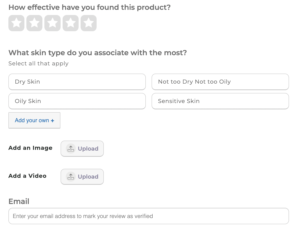
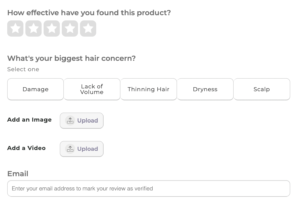
At PowerReviews, we make segmenting Review Collection forms by category like this straightforward.
Preserving Authenticity
The value of reviews is rooted in their authenticity. When consumers write reviews, they’re not doing so to sell products. They’re contributing content simply to share their genuine feedback – whether good, bad, or somewhere in between.
The Growing Concern of Fake Reviews
Yet, one simply needs to do a Google news search for “fake reviews” to see that the authenticity and trustworthiness of reviews is being called into question.
Fake reviews have become more common than you may like to think – especially on certain platforms. And some brands have even gone so far as to suppress negative reviews in an effort to improve consumer perception. Just earlier this year, the Federal Trade Commision (FTC) fined clothing retailer Fashion Nova $4.2m for doing just that.
In the short term, suppressing negative reviews and publishing fraudulent ones can be a quick way to improve a brand’s image – and grow sales. But in the end, these practices cause lasting damage.
Phony reviews mislead customers. This leads to poor purchase decisions – and unhappy customers.
What’s more, when a brand or retailer is found out (notice we said when, not if) for these unsavory practices, it can cause irreparable damage to their reputation. If consumers don’t feel they can trust a company, they’re unlikely to make a purchase.
Nearly all Consumers Have Stumbled Upon a Shady Review
How common are fake reviews? And what red flags do shoppers look for to determine if a review is phony?
Fake reviews have become all too common. Nine in 10 (90%) US consumers believe they’ve read a fake review in the past.
How US Shoppers Pinpoint Fraudulent Reviews
Most shoppers in the US believe they’ve seen fake reviews in the past. But what factors lead them to believe a review isn’t authentic?
The top factor is the wording of the review or how it’s written. This factor also tops the list among UK shoppers.
Other red flags include poor grammar, extremeness (either too positive or too negative), and a lack of specific detail.
So fake reviews are bad. But how can you safeguard against them: enter content moderation.
Content Moderation
So, what does best-in-class ratings and reviews moderation look like?
First of all, it needs to account for each and every piece of content submitted by your shoppers.
Every user-generated review, photo, video, question, or answer — should go through an extensive moderation process to confirm it’s authentic, appropriate, and fraud-free. Each piece of content should also not be altered in any way.
All content that is published should appear as it is originally written, including typos and grammatical errors. This ultimately is critical to authenticity and snuffling out fake reviews.
Step 1: Fraud Detection
Displaying fake reviews directly violates FTC guidelines. So it’s important to keep this content off your website.
To safeguard against this threat, industry-leading fraud technology can analyze the device fingerprint data used to submit a piece of UGC. This data identifies the device ID associated with a review, such as a smartphone or tablet and helps to identify suspicious device or IP information. By using this technology, you’re able to prevent all different types of fraudulent reviews, including spam, duplicate content, and promotional content.
For example, if it detects a large number of reviews coming from a single device, those reviews get flagged for potential fraud. Of course, there is a possibility it’s just a customer who’s particularly zealous about reviewing every single product they bought for Black Friday. Most times, however, this kind of activity indicates fraud. Either way, the tech applies a “fraud” tag to it, flagging it for review – potentially by human moderators (more on them in step 3).
Step 2: Automated Filtering
Beyond fraud, systems can also scan each piece of content through an automated filtering process to catch additional authenticity issues, from profanity to personally identifiable information. When a potential issue is detected, a tag is added to that content so that it can be later reviewed by a human.
Examples of the types of content tagged:
- Content about the wrong product or retailer
- Contradictory content, e.g. a rave review with a 1-star rating
- Duplicate content
- Foreign language
- Medical advice
- Personally identifiable information
- Profanity
- Violent content
- Website URLs
For some tags, such as profanity, the content can be automatically rejected for publication. For others, it can be passed to a human moderation team.
A best-in-class vendor will enable you to add additional words or phrases to the profanity filter. It will also make regular updates to these filters, based on emerging slang terms or political slogans, to ensure nothing profane gets published.
(PowerReviews applies observations tags, which we detail in our Moderation Policy)
Step 3: Human Moderation
For many businesses and Ratings and Reviews vendors, the moderation process stops at step two. But relying solely on technology can leave you vulnerable to some of the exact issues that violate the FTC guideline – like deceptive performance claims, medical advice, and other forms of misrepresentation.
Human moderation adds an additional layer of protection for this very reason. Technology can help prevent fraud and profanity, but humans are better equipped to review for nuance, innuendo, and context.
To meet the high standards for authenticity required to successfully snuff out fake reviews (and not to mention the FTC Guidelines), a moderation process powered by both human and artificial intelligence is ideal.
For example – at PowerReviews, our human moderators review every piece of UGC in our secure portal. All content flagged as an observation by our automatic filtering process will be highlighted, such as profane language or reviews that don’t discuss the products.
Upon reviewing all of the Observations, the moderator will determine whether the review should be published. If a review is rejected for publication, it will not be published and will subsequently not be syndicated (if a brand or retailer using our solution chooses to override this decision, the review will only publish to their site — not to any syndicated retailers).
Also of note: our moderators work on several teams. Some moderators work on all English content, while some review content that needs to follow a specific set of guidelines, such as herbal supplements or financial products (PowerReviews can also facilitate an exclusive moderator to review their content for additional concerns, such as medical advice).
Step 4: Badging and Displaying Content
Once a piece of content passes steps 1-3, it’s ready to be displayed on your website. Woohoo! But remember: it’s important to use accurate badging and disclosure codes that indicate the source of the content.
This added layer of transparency shows details such as:
- Where a review came from
- Whether or not it has been verified i.e. written by a person who actually purchased the product
- If it’s been syndicated from another site
- If it was collected via a sampling campaign or was shared as a contest entry
- If the review was submitted by a company employee
PowerReviews offers the following options which serve as a best practice example.
Verified buyers
A “Verified Buyer” badge should be assigned to reviews written by someone who has actually purchased the product they are reviewing, as identified through their purchase history. This builds consumer confidence, and it also ensures you don’t run afoul of Section 5 of the FTC Act, which prohibits “misrepresenting an endorser as an actual, current, or recent user” of a product.
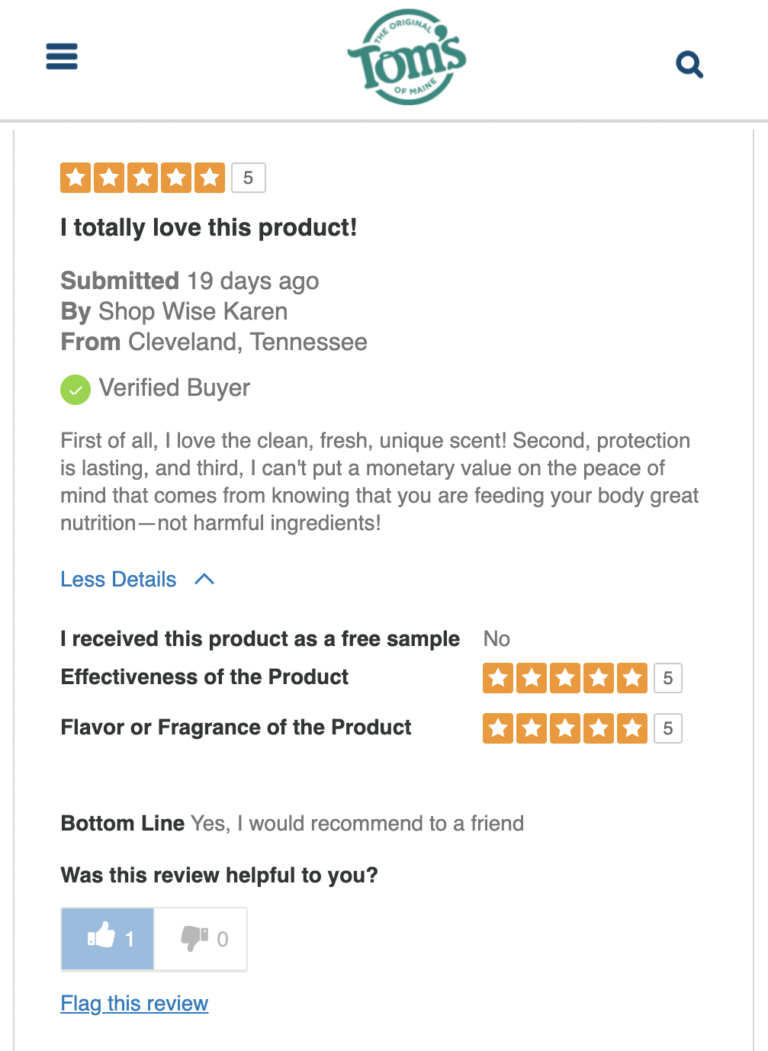
Sweepstakes & product sampling
The FTC also frowns upon failing to disclose whether an endorsement is paid. In the world of influencers, the proper way to do this is by clearly stating that a post or endorsement is sponsored, e.g. with a #sponsored or #ad hashtag at the top of a post.
A review might be considered a paid endorsement if the reviewer received the product for free, such as through a sweepstakes or product sampling campaign.
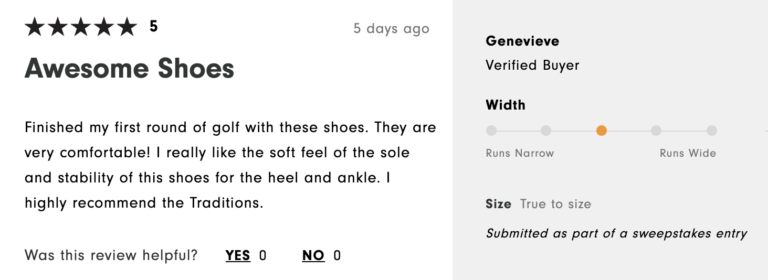
Syndicated reviews
The second example above is also an example of you should badge syndicated reviews. All review content that is syndicated beyond the client’s original website must be badged appropriately (at PowerReviews, we do this by including the name or logo of where the review was originally written – like this Too Faced review syndicated to Ulta).

Staff reviews
Finally, reviews that are written by someone who works for a brand or retailer must also be disclosed, as these people may naturally have a more biased opinion of a brand. For these reviews add a “Staff Reviewer” badge.
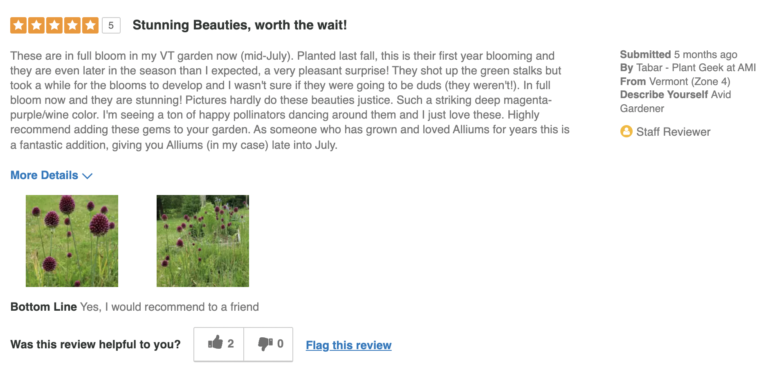
It’s important to share as much context as possible about your UGC, as this fosters trust with online shoppers. And in many cases, it’s also required by the FTC (Learn more about PowerReviews Badges).
Review Display on PDPs and Throughout Your Site
Let’s start with the most obvious place to showcase your review content: your product pages. But although it’s obvious, many brands and retailers get it wrong.
Of course, review displays aren’t one size fits all.
For example, a display for a pair of shoes should feature size and fit information to help future shoppers determine the correct size to purchase.
But those data points would be completely irrelevant for a product page selling eye makeup.
There are, however, best practices that apply across all categories.
Ultimately, your goal is to provide the information necessary to provide shoppers with the confidence to buy. This is the make-or-break point in the customer journey and the final step.
All your product development, customer acquisition and – not to mention – review collection efforts have led to this point. This is where you convert consumers, turning browsers to customers.
In this section, we focus on the information we know shoppers look for at this moment of truth.
Create Review Displays On Your PDPs That Convert
Let’s start with the most obvious place to showcase your review content: your product pages. But although it’s obvious, many brands and retailers get it wrong.
Of course, review displays aren’t one size fits all.
For example, a display for a pair of shoes should feature size and fit information to help future shoppers determine the correct size to purchase.
But those data points would be completely irrelevant for a product page selling eye makeup.
There are, however, best practices that apply across all categories.
Ultimately, your goal is to provide the information necessary to provide shoppers with the confidence to buy. This is the make-or-break point in the customer journey and the final step.
All your marketing efforts have led to this point. This is where you convert consumers, turning browsers to customers.
In this section, we focus on the information we know shoppers look for at this moment of truth.
The Ideal Review Display: At a Glance
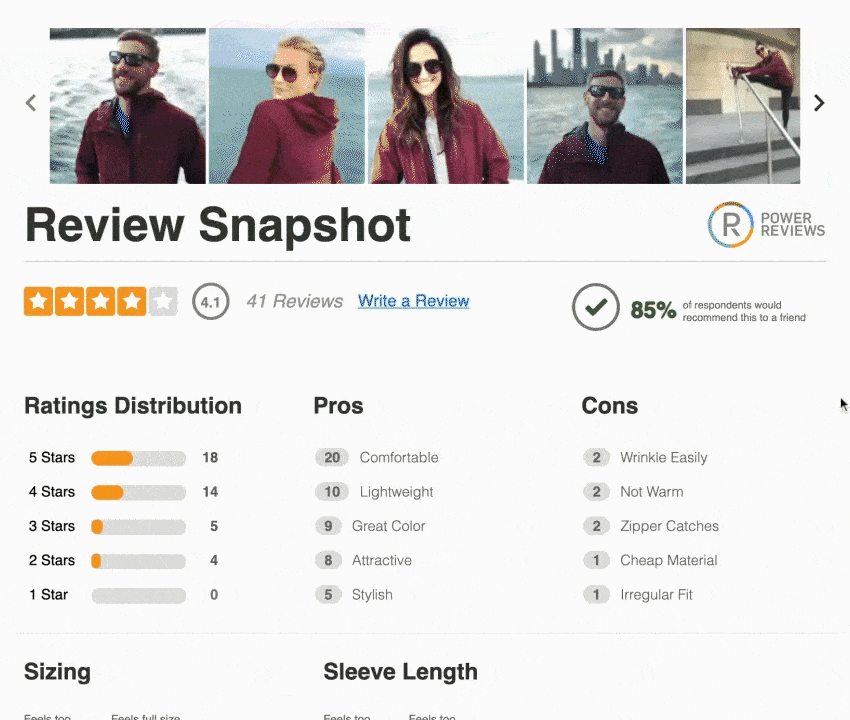
- Review Snippet: A simple visualization of a product’s review content — right at the top of the product page.
- Review Snapshot: A visual overview of the review content for a given product, including average star rating and rating distribution, and customized to your needs.
- Search and Filter: Helps shoppers find reviews relevant to their needs.
- Demographic Information: Shoppers can find relatable content from someone with similar characteristics and use cases.
- Helpful Votes: Enable shoppers to vote reviews as “helpful” and then aggregate this content as they assess a potential purchase.
- Verified Buyer Badge: Show shoppers a review was written by someone who actually purchased the product.
- Visual Content Display: Photos and videos from your shoppers — collected both natively and through social media.
Search and filter options
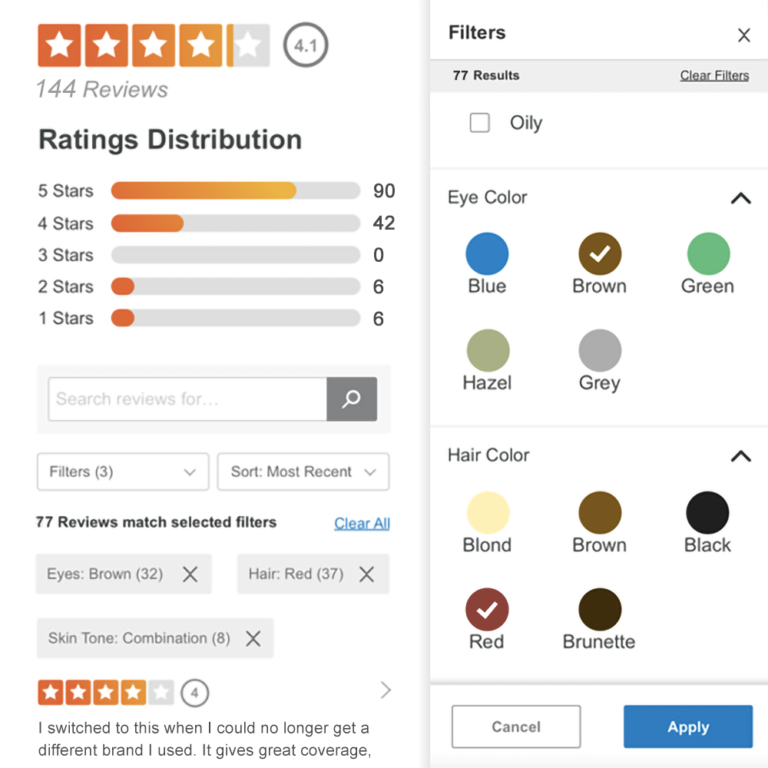
Once a shopper finds reviews relevant to their use case, they’re more likely to make a purchase. In fact, there’s a 202.9% conversion lift among visitors who use the search feature (over general visitors to the same page).
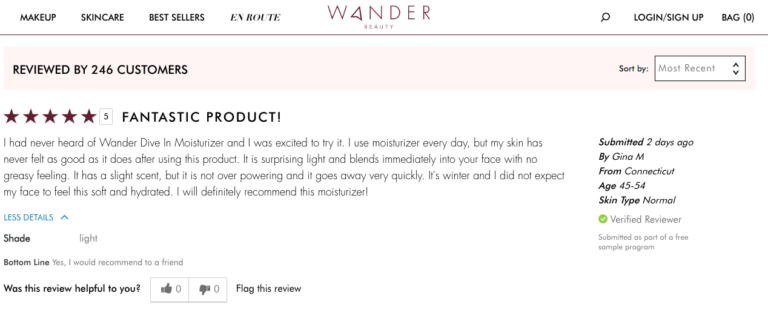
Compare and contrast
Helps consumers understand the key features existing customers like and dislike about the product. A review “faceoff” shows the most liked positive review alongside the most liked negative one. It’s a great way for shoppers to quickly understand the positives and the negatives of the product that have been most helpful for other shoppers to learn about.

Our research shows there’s a 138.2% conversion lift for those who expand the positive review in the faceoff over general visitors to the same Product Detail Page.
And interestingly, there’s a 120.6% conversion increase among shoppers who click to expand the negative review. This once again proves the value of negative reviews in empowering shoppers to make informed purchase decisions.
Enable shoppers to identify “helpful” reviews
When a shopper reads a review, they can indicate that the content was helpful (or not) by clicking on the thumbs up or thumbs down icons.
As our research highlights, the conversion rate increases by 314.7% among visitors who click the “helpful” icon. And interestingly, there’s a 182.4% conversion lift among those who click the “unhelpful icon”.
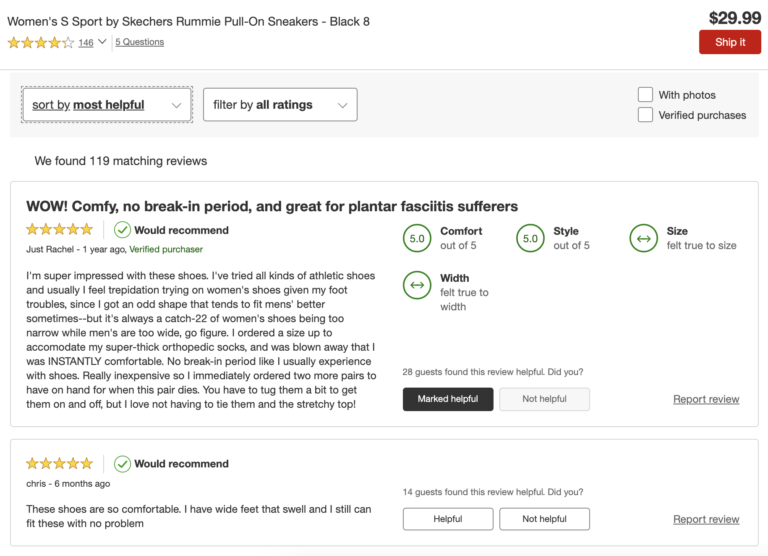
Further Enhance Your Image Gallery with Review Content
Your PDP image galleries offer a great opportunity to further highlight great review content in a hugely visually compelling way.
Check out this example within an image carousel.
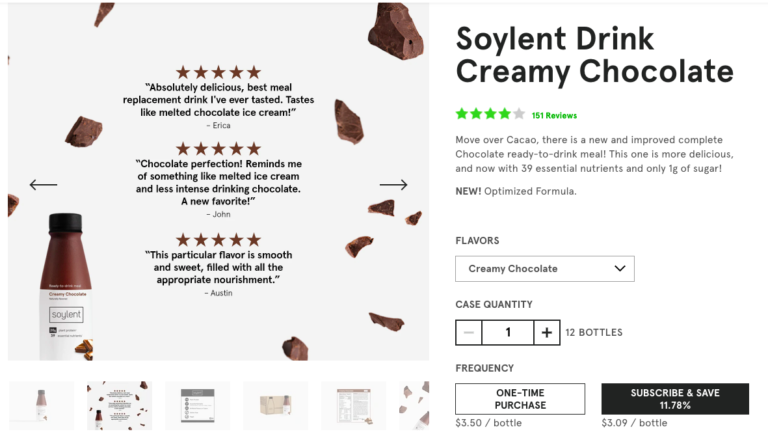
Displaying Reviews Throughout Your Website
There are plenty of ways to leverage review content throughout your website to entice visitors to click through to your product pages.
Transform your Homepage by leveraging Review Content
Of course, your homepage is the springboard for the rest of the customer journey. So it represents a fantastic opportunity to guide consumers down the path to purchase.
Featuring review content on your homepage does just that. Why? It helps shoppers more easily (and quickly) find the products that meet their needs.
Attention spans are notoriously short nowadays so you have little time to influence behavior as you’d like. As we’ve seen, ratings and reviews are among the most potent weapons in your arsenal. So incorporate it in your first “touch” with customers.
Be sure to display the average star rating and review volume for each of the products featured in your best sellers carousel. Or, consider adding a top rating products carousel to your homepage.
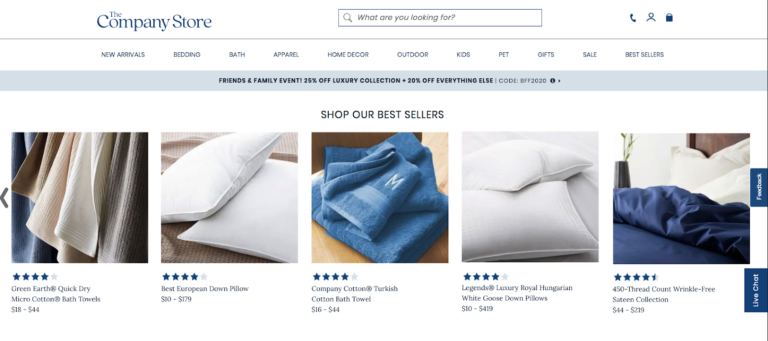
If you’re featuring a specific product on your homepage, include user-generated photos, as well as the text of a glowing review, to entice visitors to click to learn more.
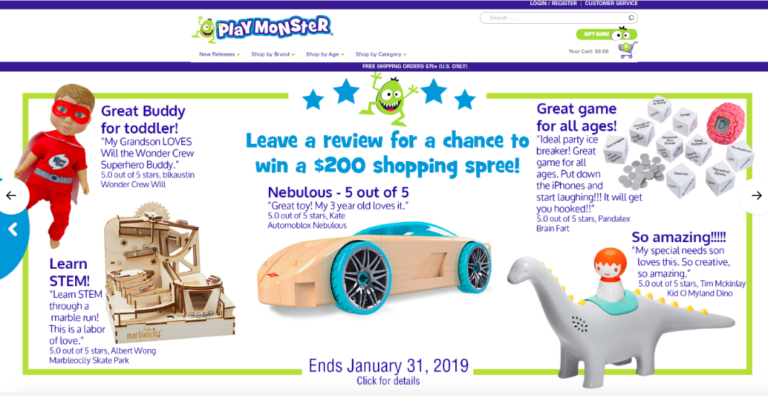
Spruce up your Category Pages
Today, when shoppers hit a product category page, they likely have the option to filter the results by a number of different categories, such as price and new arrivals. Make sure your shoppers can sort by “top rated,” too.
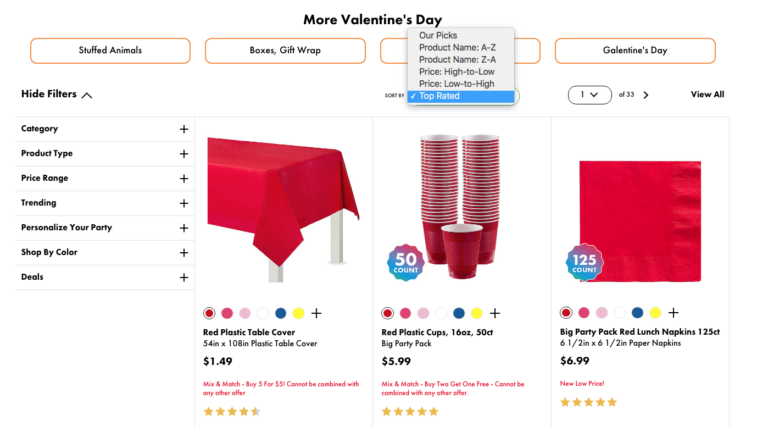
Also include the average star rating and the number of reviews for each product in a category to make browsing easier for shoppers.
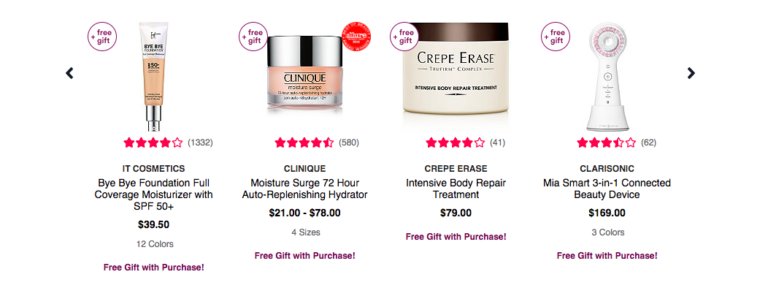
Want to include even more social proof on your category pages? When a shopper hovers over a product, display a preview of a written review to entice them to click through.
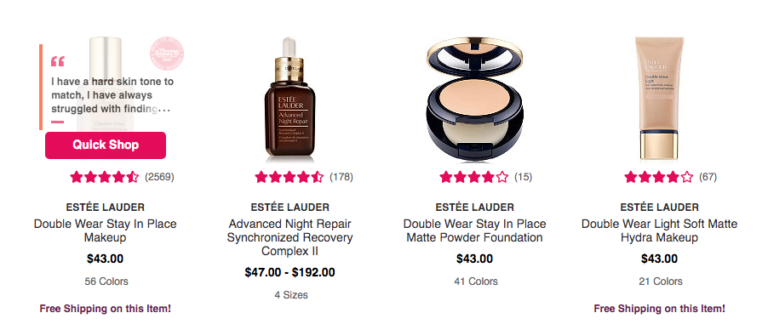
Feature Customer Photos and Videos Throughout Your Website
Your professionally shot photos and videos are certainly important. But shoppers actually prefer to see photos and videos of your products being used by real people like them (as we already mentioned, we look at this in a lot more detail in chapter 9).
In fact, according to our own research, 80% of consumers say customer-generated visual content is more valuable than glossy photos produced by a brand or retailer.
Consider adding a visual content gallery to your website that showcases images and videos of your products that you’ve collected from social media.

Enhancing your Marketing Initiatives with Ratings & Reviews
Getting a negative review can feel like a punch to the gut. After all, your brand is laser-focused on developing products and experiences that your customers love.
So it’s never fun to hear negative feedback about something you’ve worked hard to create.
But negative reviews are inevitable. Even the most well-loved businesses get them from time to time.
That’s because it’s simply impossible to create a product that meets the needs of every single customer who comes your way.
Of course, negative reviews are never the end goal. But there’s a positive side to negative reviews. Yes, you read that right. In fact, one and two star reviews can actually be good for your business.
In Digital Marketing
If you’re like any other brand, you are constantly questioning how to improve the performance of your digital campaigns to drive more shoppers to your website.
Ratings and reviews are a fantastic resource to leverage to drive these enhancements.
Build Email Campaigns that Showcase Ratings & Reviews
With most inboxes now overflowing with promotional emails, you need to stand out.
Consider incorporating star ratings and review text. Or perhaps create completely new campaigns that feature your top-rated products.
For example, if summer is approaching, you might build a campaign featuring top-rated swimwear. Be sure to display star ratings or review excerpts in the email — as well as on the campaign landing pages.
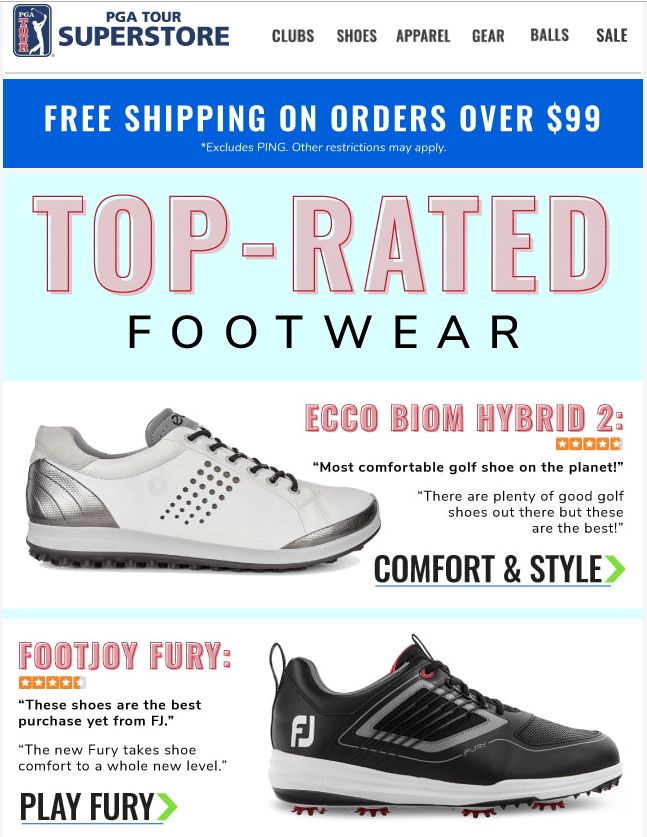
Also think about featuring star ratings in your cart abandonment emails. In many cases, that social proof may be enough to draw shoppers back to your website to complete their purchases.
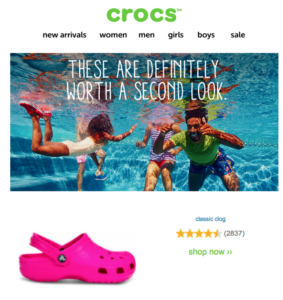
Feature Shopper Content on Social Media
Consumers use social media to connect with family and friends. But they also use these channels to discover products and engage with brands.
Feature star ratings, review quotes and customer-submitted photos on your paid and organic posts to drive traffic to your site and generate sales.
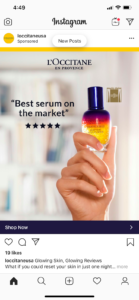
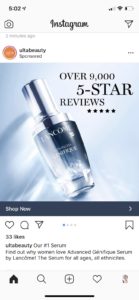

In Traditional Marketing
Traditional marketing is still critical for most brands. Incorporating ratings and reviews content can make this activity even more effective.
Add Review Content to Print Ads
If your brand runs printed ads in magazines or newspapers, think of ways to enhance these ads with ratings and reviews content.

Add Star Ratings and Reviews to Print Catalogs
If you send out paper catalogs to customers, consider adding star ratings, text reviews or even shopper-submitted photos alongside your key products. Or, include an entire spread of your top-rated products.

Create More Credible TV Commercials with Review Content
If you’re looking for ways to make your TV commercials pop, ratings and reviews content can help.
Feature star ratings for your products (or even your company as a whole) in your television commercials.

Power Creativity with Review Content
Some of the most fun examples we’ve seen use review content as the basis of broader creative branding and imagery.

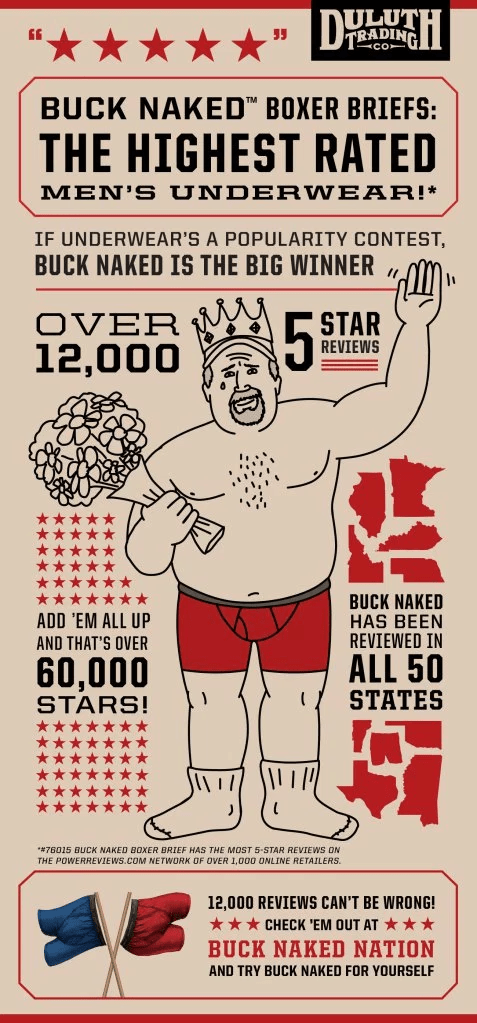
In Brick-and-Mortar Retail
We know consumers use ratings and reviews to make smart purchase decisions when shopping online. But they also depend on this content when shopping in a physical store. So look for opportunities to showcase this content in your brick-and-mortar stores.
Ensure Your Displays are Mobile-Friendly
Everyone has a smartphone now and typically treats it as an extension of their own bodies.
When shopping in a store, it’s now common practice for shoppers to pull out their phones to get more information about a product.
In fact, a PowerReviews study found that 57% of shoppers read reviews when shopping in brick-and-mortar stores to assess potential purchases. This number is even higher – 63% – among Millennial shoppers
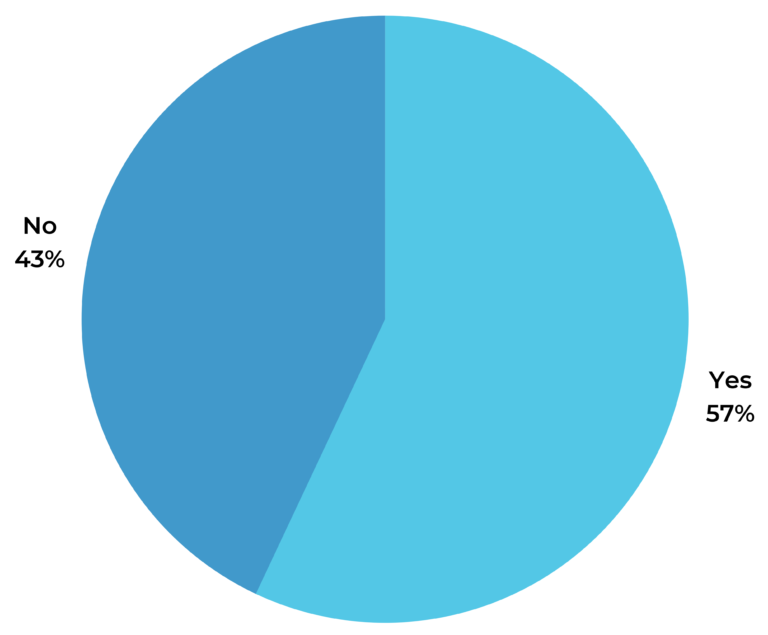
So ensuring your reviews look and read great on mobile is now critical.
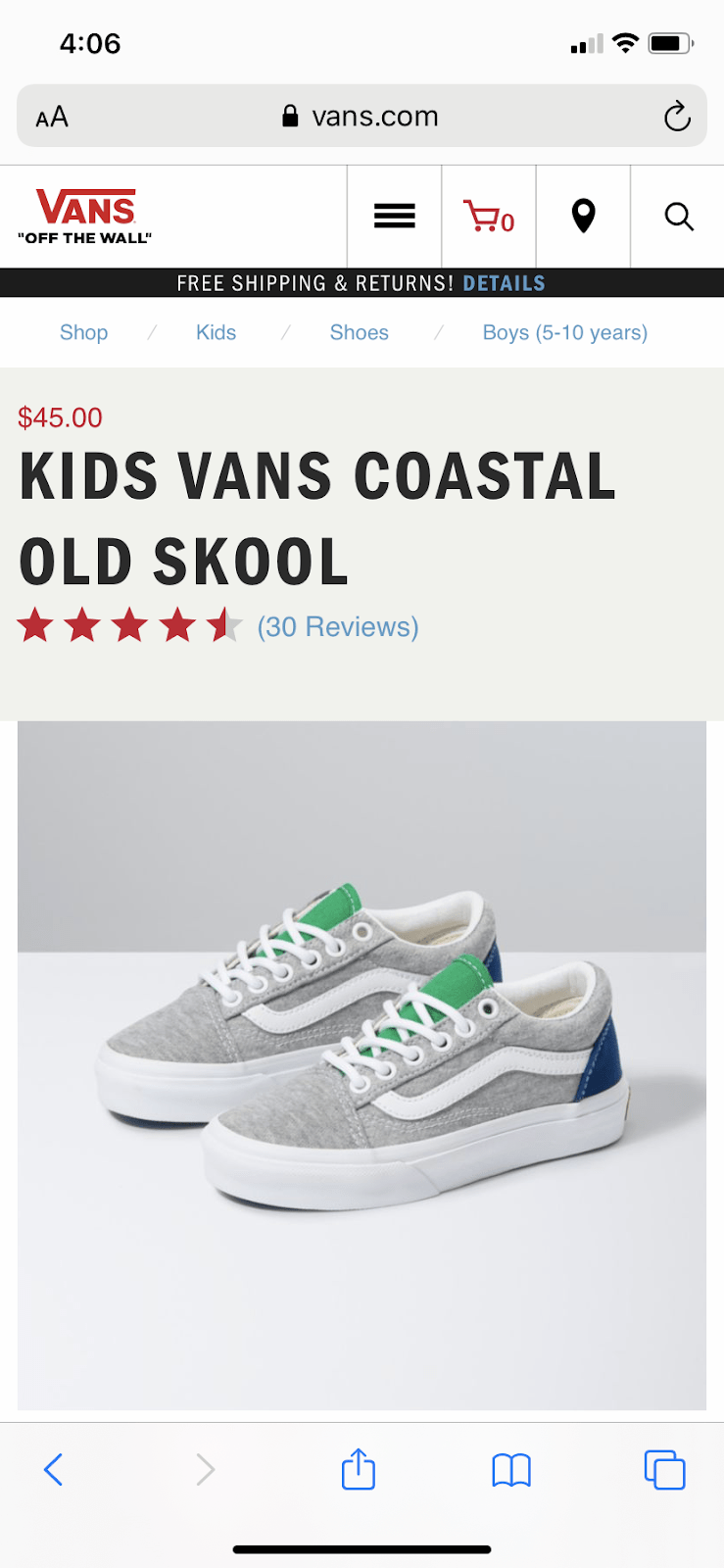
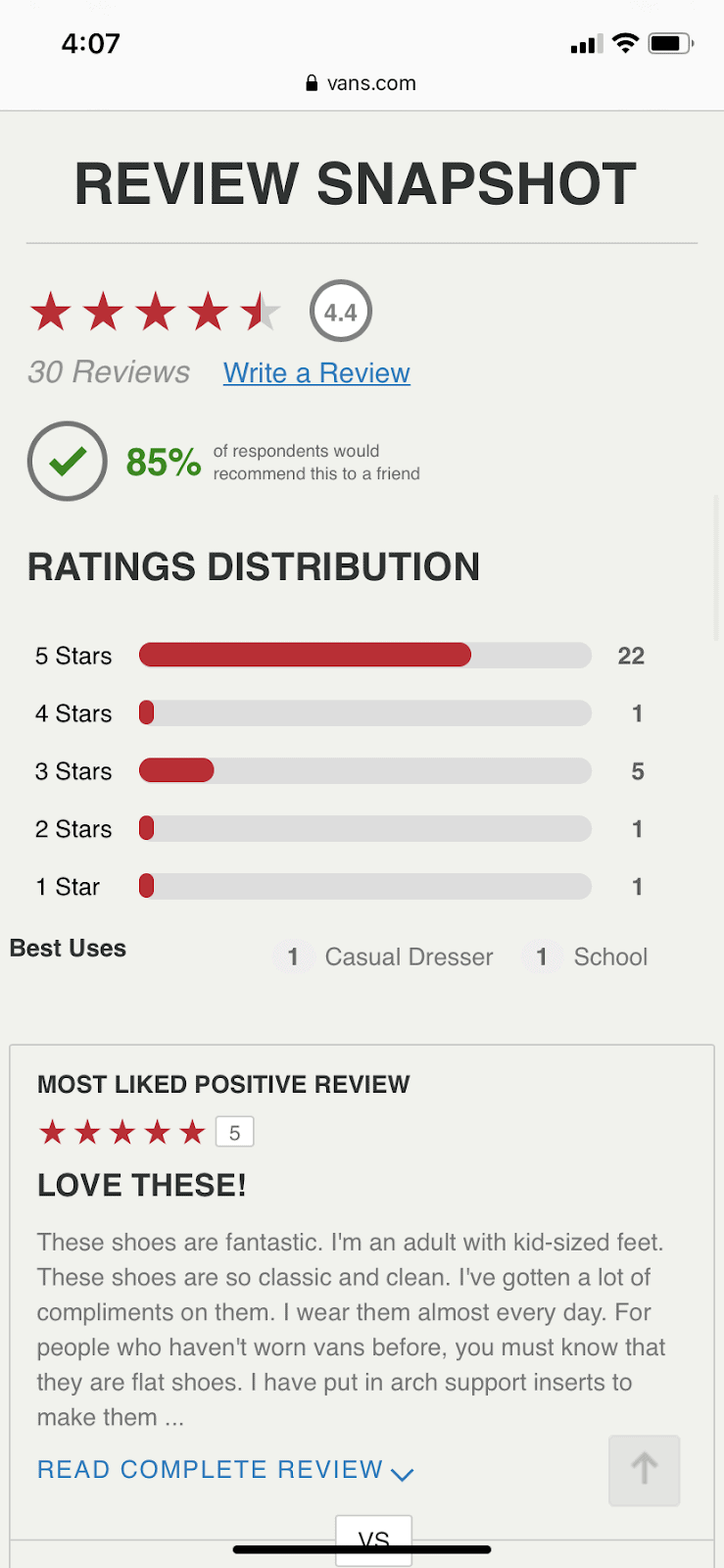
Enhance Store Signage with Review Content
Strategically placed review content can attract the attention of in-store shoppers — and give them the confidence they need to add an item to their cart.
Some stores are starting to use digital signage to showcase UGC. And featuring this content in your stores doesn’t have to be an expensive, high tech initiative.
For example, create a display of “top rated” products. Include a product’s average star rating or the text of a positive review to your pricing labels. Or create in-store signage for a product that showcases photos submitted by real shoppers.
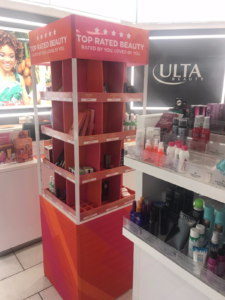
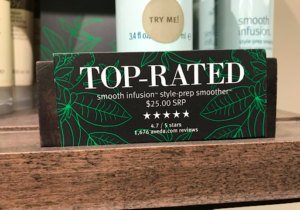
Feature Review Content on the Product Itself
Another way to give in-store shoppers the social proof they crave? Feature review content on the product itself.
This can be as simple as including the average star rating or the text from an especially glowing review on the packaging of a few of your key products.
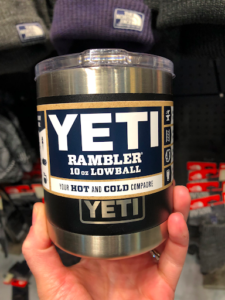
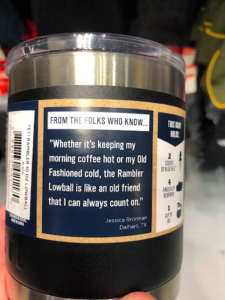
Dealing with Negative Reviews
Today, consumers have literally endless shopping options. Of course, there are dozens of things a consumer considers when determining which companies to do business with — and which to pass up. But one top consideration is trust.
Research from Edelman found that 81% of consumers say they must be able to trust a brand prior to making a purchase. And 70% indicate trusting a brand is more important now than in the past.
In order to earn that trust, brands must be transparent. A key way to do that is to display feedback from other shoppers — including the negative kind. Our research found that 46% of shoppers (and 53% of Gen Z shoppers) are suspicious of products with an average star rating of five out of five.
And the data we shared in Chapter 1 – that on-page conversion and traffic peak at the 4.5 – 4.99 average rating – further endorses this point.
On the flip side, when shoppers see negative reviews, they see you have nothing to hide. And that reassures them you’re a brand they can trust.
Negative Reviews Help Consumers Make Better Purchase Decisions
Shoppers depend on negative reviews to determine which products fit their needs — and which don’t. Our research found that a staggering 85% of shoppers seek out negative reviews.
To elaborate on why this may be the case, our research also highlights that a third of shoppers say that poor reviews gave balance to their shopping research, stating that a negative perspective was either a ‘very important’ or ‘important’ factor influencing their decision.
In fact, when researching products, two-thirds of ecommerce shoppers filter for one-star reviews. These visitors still convert at 108% the rate of general web traffic (incidentally, this is the type of insight our PDP Site Analytics solution routinely surfaces).
But why is this the case? Here are three things we’ve noticed from speaking to brands and looking at this data day-in, day-out:
- Based on the negative reviews, the shopper determines the product isn’t a good fit for their needs. They keep searching for a product that’s a better match — and you avoid an unhappy customer and an unnecessary return.
- The shopper determines the feedback in the one and two star reviews isn’t relevant to them– so they disregard it.
- The shopper determines the worst case scenario isn’t a concern — so they purchase the product anyway.
In each of these three situations, negative reviews helped a shopper make a more informed purchase decision.
3 Ways to Leverage Negative Reviews to Boost Your Bottom Line
So negative reviews can positively impact the performance of your brand. In fact, they should be viewed as an opportunity to do just that.
Here are three ways how:
1. Display Negative Reviews
It might be tempting to filter out negative reviews. But avoid the temptation. One and two star reviews add a layer of authenticity to your content and let shoppers know you’re a brand they can trust. What’s more, negative reviews help your shoppers make more informed purchase decisions, which will help decrease returns and boost loyalty.
So be sure to display all reviews, regardless of star rating.
In addition, allow shoppers to easily spot the “worst case scenario” — and determine whether it’s relevant or important to them. Our friends at Athleta do this in a couple different ways. First, shoppers can filter reviews by a specific star rating. Shoppers can also sort reviews by the lowest rating.
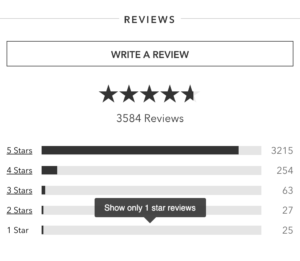
Finally, consider displaying the most helpful positive review alongside the most helpful negative review. Again, this is a great way to help shoppers easily identify the worst case scenario – and find the products that best fit their needs. Plus, as we mentioned earlier, there’s actually a 120.6% conversion lift among shoppers who expand the negative review in a “compare and contrast” display like this one from our friends at Ulta.
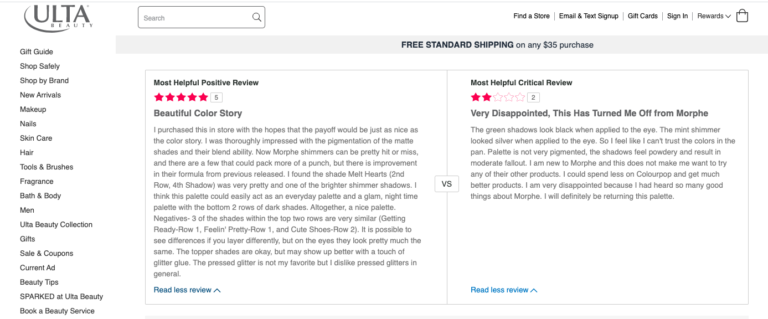
2. Respond to Negative Reviews
When you get a negative review, don’t just cross your fingers and hope it’ll quickly get covered up by positive reviews. Instead, face the review head-on by responding to it.
When you respond to a negative review, you have the opportunity to turn a bad situation around and salvage a relationship with your customer. If you’re able to fix the issue, the shopper is likely to buy from you again. What’s more, your response will show future shoppers that you value your customers and are committed to helping them resolve their issues. And that’ll give these new customers the confidence they need to make a purchase.
Remember: when it comes to responding to negative reviews, time is of the essence. If a customer is left hanging, they’ll only get more upset.
In addition, avoid using a generic, canned response — and don’t get defensive. Instead, personalize your response by using the shopper’s name and address the specific issues raised in the negative review.
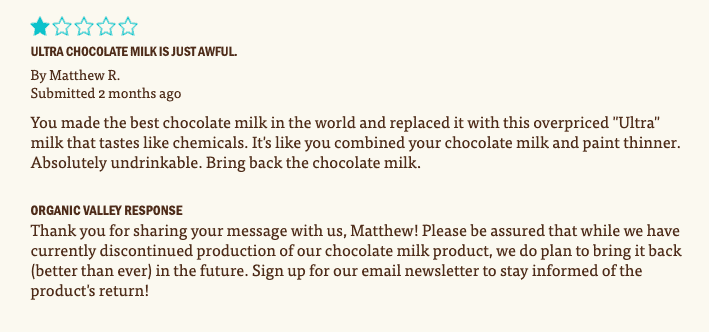
Finally, take things offline when needed. Sometimes you’ll need more details from the shopper in order to resolve their issue.
But be sure to post a public response too, as it’ll let the customer (and future shoppers) know you’re taking action. Research from our friends at 1440 found that 73% of consumers would overlook a negative review if the brand posted a thoughtful response.
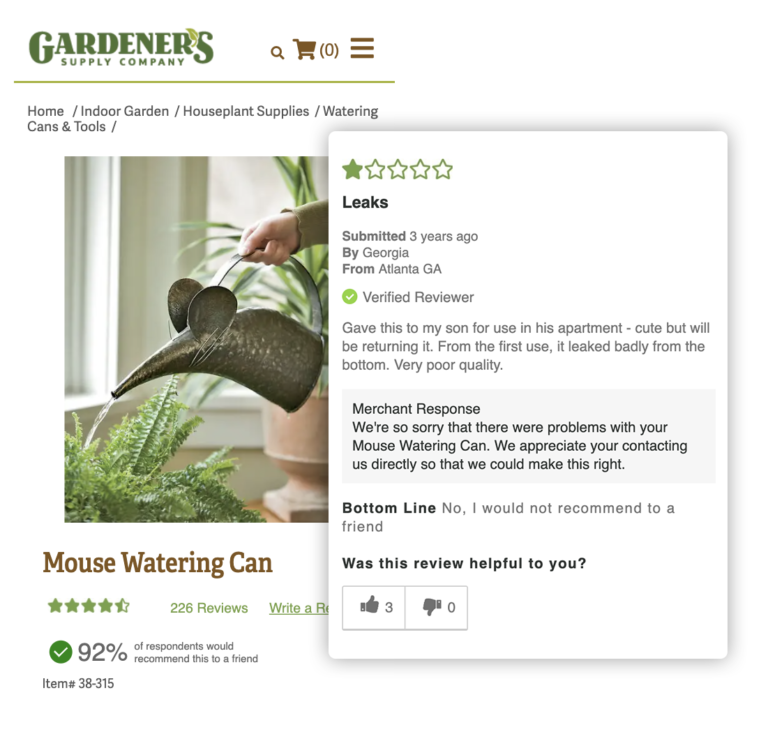
3. Analyze Negative Reviews to Identify Actionable Insights
In some cases, a negative review might mention an isolated issue. For example, a product might be damaged in transit.
But in other cases, a negative review can point to a larger issue that needs to be addressed. For example, one of our customers noticed several negative reviews for a watch that mentioned a broken clasp. They rectified the problem and their ratings subsequently improved.
Be sure you’re regularly analyzing your review content to gauge sentiment and identify issues early on. Then, use the insights you uncover to improve your products or messaging/marketing of those products or whatever else the data says needs adjusting.
With the right tool, you can also benchmark against your competitors. Compare by product rating, sentiment, key themes and so on by product, brand, and product category. This is critical insight to improving overall strategic direction and performance.
Sharing & Syndication
Creating buyer confidence at scale is critical to growing your business. A best-in-class ecommerce strategy will therefore nearly always leverage ratings and reviews as a critical mechanism to “meet shoppers where they are”.
Sharing and syndicating ratings and reviews content to different channels across the internet is a common tactic to scale brand credibility.
Ratings and Reviews as a Customer Acquisition Mechanism
Sharing and syndicating your ratings and reviews content serves one main purpose: expanding your reach.
Why is this so important? It exposes the value of your products to new audiences, which means it’s critical to customer acquisition.
In an ideal world, you’d create a great product, price it appropriately, build an awesome website and product page and then sit back and watch the sales come in. But that’s unrealistic. You need to be findable across a range of digital channels. We explore a few in this chapter.
But first, here’s a brief definition of what we mean by syndication in the context of ratings and reviews.
Ratings and Reviews Syndication, Defined
How exactly does syndication work? Essentially, syndication is when one business shares some form of user-generated content — such as a review, question, photo or video — with another business.
For example, let’s say a shopper submits a review via a brand’s site. The brand displays the review on its own website. The exact same review is then shared with the brand’s chosen retailer partners, and these companies display the review on their ecommerce sites, too.
For example, this shopper submitted a review on hormelfoods.com for bacon.
This review is displayed on Hormel’s website — and is shared with Target.com for display on the appropriate product page, extending the value of this specific review.
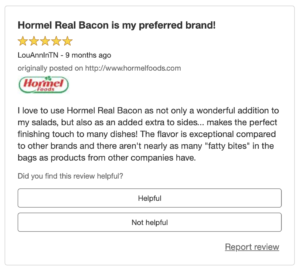
A badge is displayed as part of the review on Target.com, letting shoppers know the review was originally posted on hormelfoods.com.
The result: you are more likely to get noticed by shoppers who otherwise wouldn’t otherwise have known about your product or – quite possibly – your brand.
Improve your SEO ranking
Retailer sites aren’t the only place where sharing of ratings and reviews content can enhance customer acquisition potential.
Our research found that 35% of consumers start their shopping journey on Google or another search engine. Showing up there in a strong way is therefore critical.
Organic SEO
Search engines love fresh content. You don’t want to be constantly refreshing your website copy when the product or value proposition hasn’t changed just to improve your rankings.
A steady stream of new, relevant review content enables you to fulfill this key need. It is also typically keyword rich.
A strong review generation program therefore helps your product pages rank higher – which means more traffic on your site and more shoppers being exposed to your products (we talked about loads of ways you can maximize review volumes in Chapter 2).
Questions & Answers, a form of user-generated content which we explore in depth later, is also great for this purpose.
Paid Search Advertising
Search ads are another great way to reach new shoppers – and they’re even more effective when they include star ratings.
Be sure to syndicate your product star ratings to Google. That way, stars will appear in your ads — and you will further optimize inbound traffic to your product pages.
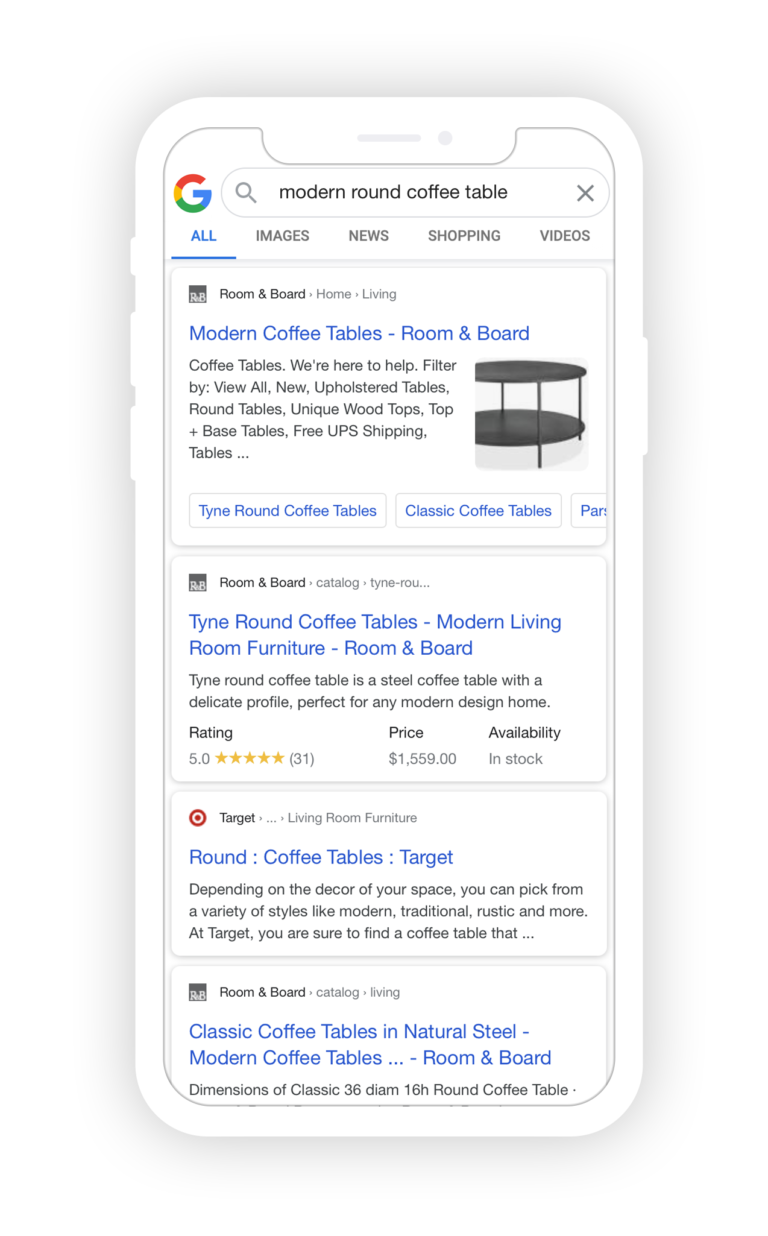
Google Seller Ratings
Google Seller Ratings is a Google Ads extension that displays a rating between one and five stars that shows up on search ads.
It’s an automated extension that is calculated by aggregating customer reviews from various sources that Google trusts. The resulting rating is then displayed within the body of the ad.
If you’ve ever typed into Google’s search bar, you’ve seen Google Seller Ratings.
It is the star rating that displays underneath the URL on Google ads.
While Seller Ratings are most often used by ecommerce companies, any company with a digital presence can use Google Seller Ratings (Note: Seller Ratings are for the entire site, not individual products).

If they are not already, Seller Ratings should be a critical part of your digital strategy. Why? According to Google, they can increase the click-through rates (CTR) of your ads by up to 10%.
This is super important because a higher CTR means a higher quality score — which reduces your CPC (cost per click) and improves your ad rank.
Bottom line: Seller Ratings optimize the performance of your Google Ads. More click throughs, more eyeballs on your site and – in turn – more sales from “greenfield” customers. Which makes complete sense. Your Seller Ratings are determined by a cumulative and aggregated volume of trusted customer reviews. They are a direct reflection of the experiences your customers have had while dealing with your business. This provides social proof for your brand right on Google search results pages, increasing shoppers’ trust in your business and giving them the confidence they need to click through to your site.
So ensure you are maximizing your customer acquisition potential by syndicating your ratings in this way (check out our blog on the topic for technical directions).
Ratings & Reviews on Amazon
Every brand knows about the importance of Amazon as a sales channel. In fact, nearly half of ALL product searches start on Amazon nowadays.
Our research found that 95% of consumers read reviews on Amazon. So if you sell your products on Amazon, you’ve got to make sure you have plenty of ratings and reviews content on your product pages.
One simple way to do that is to allow your shoppers to share the reviews they’ve written on your website to your Amazon product pages (ask your ratings and reviews vendor if they have a feature that allows this).
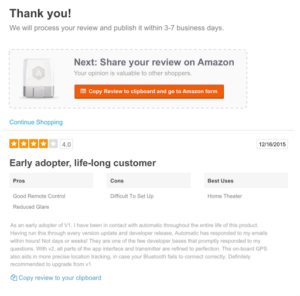
In doing so, you cultivate buyer confidence among shoppers who may not even previously known you existed.
Showcase UGC on Amazon Product Pages
Product reviews are actually a top reason consumers shop on Amazon. So think of creative ways to put this content front and center on your Amazon product pages.
One way to do that is to create an image that includes the text of a product review. Then, upload it alongside your other product images.
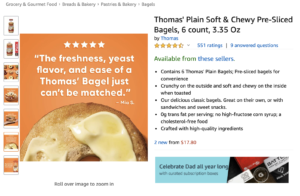
You can also feature user-generated visual content alongside your professionally shot photos and videos to give shoppers a better idea of what your products look like being used by “real” people.
Ratings & Reviews on big box retail sites
Many brands sell their products through retailer sites like Target, Walmart and others – as well as through vertical specific platforms like Ulta, Zappos and so on. And many consumers (93%, according to a PowerReviews survey) say they read reviews on these retailer sites.
If you sell your products through retailer sites make it a priority to give consumers the content they need to make confident purchase decisions.
Again, these are critical opportunities to acquire new previously untapped customers. So don’t miss this opportunity to provide a great first impression.
Syndicate Your Content to Retailer Partners
Typically, a shopper will write a review on the same website where they purchased a product. That means only customers who shop on your website will see this content.
But when you share your ratings and reviews from your own ecommerce site to your product pages on retailer sites, your reach obviously increases significantly.
For example, this review for a Melissa & Doug toy was originally written on the company’s eCommerce site, but it also appears on the product page on Target.com.
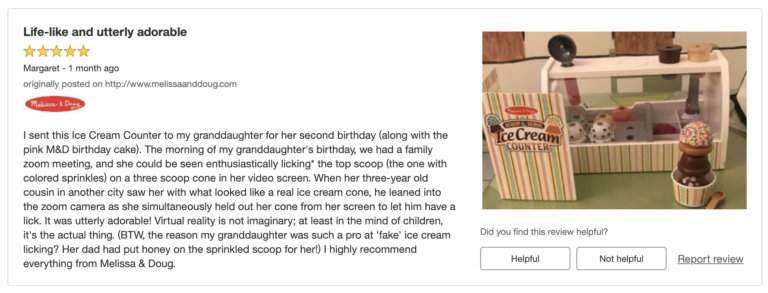
Because of this, shoppers can access the same confidence-building content – regardless of the channel they choose to shop for your products. In doing so, you maximize the value of the content you receive.
Activating Ratings & Reviews Syndication
So you’re fully bought into ratings and reviews syndication being something you should be doing. But how do you activate it?
The short answer: it’s enabled by your ratings and reviews technology vendor. You’ll need to talk to your preferred supplier to understand where they can get your ratings and reviews content to (PowerReviews has an extensive network).
As well as reach, accuracy is super important. Check whichever vendor you choose to work with accurately syndicates and effectively moderates content across the web.
If you’re wondering what’s the worst that could happen, here is an example of poorly-moderated syndication from Walmart’s website. The reviews contain obscenities and are mainly focused on the availability of the product rather than the product itself.
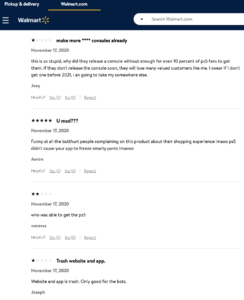
Yikes. This content should not have been published.

Ratings & Reviews as an SEO tool
Ratings and Reviews are a known SEO aid. The obvious benefit of this is traffic. And, as we mentioned in Chapter 1, average rating and review volume have a significant impact on page views. Much of this is the result of this information being displayed on search engines, throughout ecommerce sites and so on.
However, there is a technical SEO aspect that helps with actual rankings within organic search results. In this chapter we explore this in more detail and provide the guidance you need to ensure you, well, optimize for Search Engine Optimization
1. UGC is good for SEO
First off, we’re a Ratings and Reviews company and we know all about the importance of UGC from an SEO perspective.
The top search results always feature product pages with lots of reviews and a good rating. That’s because Google knows people are looking for the best product, and reviews and ratings help Google determine that.
But reviews are just one aspect of user-generated content, or UGC. There’s also Q&A and user-submitted images and videos. Together, all three forms of UGC are essential to product SEO for a few key reasons:
- UGC provides additional content for the search engines to gobble up. The more content Google has, the better their understanding of your site.
- That content is often keyword-rich. Customers include all sorts of key phrases in their reviews, more than you could ever include in a snappy product description.
- The content is being generated on a regular basis, signaling to Google that your page is still relevant to people searching for these keywords.
Crocs features all three UGC elements on their product pages, with an interactive photo gallery, and a searchable Q&A and Reviews section.
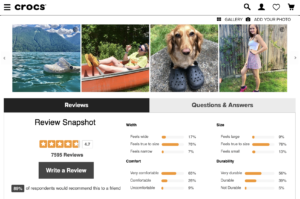
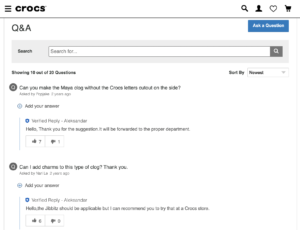
Ulta Beauty’s Reviews section includes clickable filters that make it easy for shoppers to hone in on reviews from people like them.These filters also highlight keywords that are relevant to Google, helping Google connect the dots that this product is good for someone with “sensitive eyes” or anyone looking for a “long lasting” eyebrow pencil.
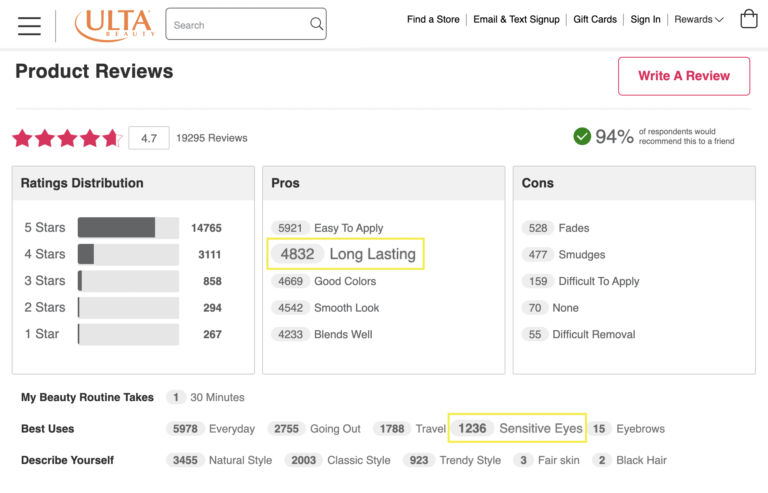
If you dig into the reviews, you’ll notice plenty more keywords. Take a look at how many we highlighted in this one:
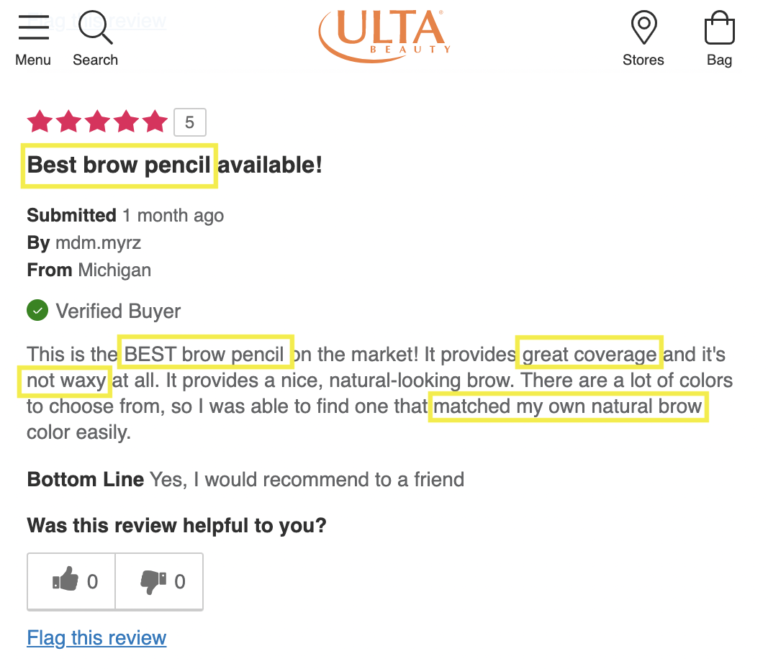
It’s no wonder a recent study found that having keywords in your reviews is one of the top ranking factors for product pages!
2. Use keywords in all the right places
Keywords are the foundation of SEO. Whether it’s “waterproof hiking jacket” or “color safe shampoo,” keywords are the words people use during discovery and it’s important to use them when describing your products.
If you want to increase your visibility in search engines, you’ve got to include keywords in all the key places (see what we did there?) on your product page. Your customers will already take care of keywords for you in your product reviews. Where else can you include them?
- Your title tag
- Your meta description
- Your H1
- Product description
Title tag
Your title tag appears alongside your Google search result in Google. It lives in your site code, so you’ll never see it unless you go to Google. You can fit about 55-60 characters of text in your title tag.
Many retailers simply copy and paste their product name, but this is a chance to speak directly to what searchers are looking for. iRobot does it best, with a combination of their product name, and the keyword “best robot mop”:

Meta description
Your meta description is the two lines of text that appear beneath your title tag in the Google search results. Like your title tag, it lives in your site code, not on the front-end of your product page.
Together, these two elements serve as a virtual billboard — advertising your product to people in the search results. Will your billboard encourage people to click, or to scroll on by? Add keywords, and they’re more likely to click.
It’s common for Google to auto-generate their own meta description using text on the page. Still, it’s a best practice to write your own so you have more control over how your brand appears in the search results. You can include up to 160 characters.
Vistaprint knows that people use a variety of keywords to describe their products, from “custom address stickers” to “return address labels.” They include them all in their title tag and meta description:
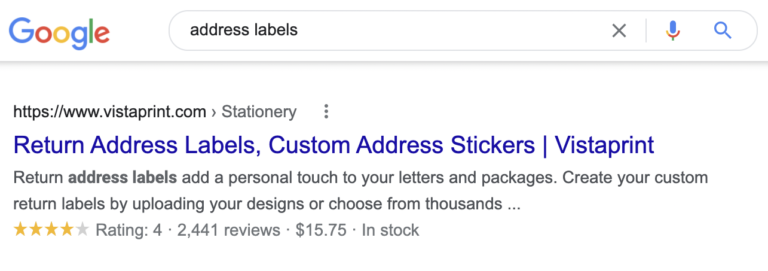
H1 tag
On the page itself, you probably have a big bold heading that puts your product name in bold. This is your h1 tag, and it’s one more area where you can incorporate a keyword.
For example, by adding the word “golf,” Bonobos is able to help Google differentiate between this performance polo and their other performance polos when people are searching for golf polo shirts.
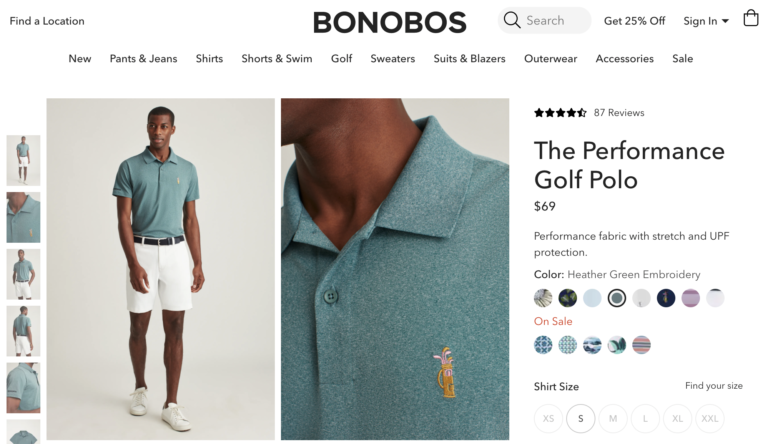
Product description
Finally, you can include keywords in the biggest piece of text on your product page: the product description. When writing your product descriptions, keep in mind the pain points people are looking for your product to solve. They may be searching for those very same things in Google!
In their product description, Canyon Bakehouse makes sure to include important keywords a person on a gluten-free diet may be looking for, like “certified gluten-free” and “100% whole grains,” or a bread they can use to make “toast” or “sandwiches.”

- Open up Google Search Console, and navigate to the Performance report. By default, the report is set to “Queries” at the bottom.
- Toggle over to the Pages tab, and click on an individual page.
- Then, you can toggle back to Queries to view the specific keywords that page is ranking for.
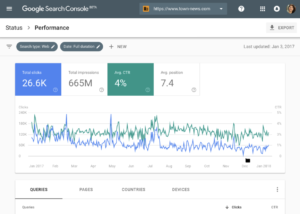
Of course, the Google Search Console report only tells you the keywords you’re currently ranking for. To discover keywords before they start trending in Google, you can look to your review analytics!
All PowerReviews customers using our Ratings & Reviews product with the Review Search feature enabled,now have access to Review Search Reporting. With this tool, you can see the specific keywords customers are entering in when they search through your reviews.
For the clothing retailer below, it’s clear that their customers seriously want to know whether this product is waterproof. Search terms like “waterproof,” “water,” “rain,” and “water resistant” dominate the top search results:
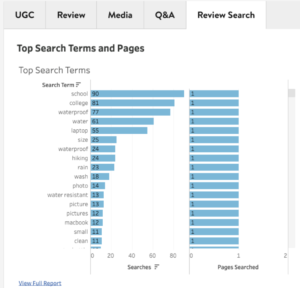
The fact that customers are typing these words into the review search box may indicate that they’re not adequately addressed in the rest of the product page. Thanks to these insights, the retailer can now take action to incorporate waterproof-related keywords into the product page for a SEO boost.
3. Mark up your images
Images speak louder than words. Nowhere is that statement more true than in the world of eCommerce. In fact, according to our recent study 80% of consumers find photos from other customers more valuable than photos from brands or retailers. Shoppers want to see photos of your product from all angles, in action, and in a lifestyle setting.
Now, search engines like Google can’t “see” images (yet), but you can tell them what’s in your image, via a little thing called alt text. Like your title tag and meta description, alt text lives in your site code, where search engines can read it to gather more context. (People who are visually impaired also rely on alt text, as their screen readers read it aloud to describe what’s in an image.)
It’s easy to copy and paste the product name or SKU into the alt text field. It’s also a serious waste of a SEO opportunity. By adding descriptive alt text, you not only make your site more accessible to more people, but you also increase your chances of ranking for the right keywords — and for showing up in Google image search!
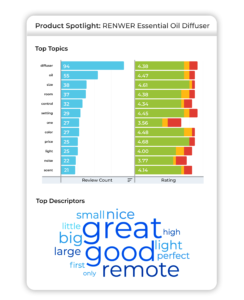
Where can you find the keywords to add to your image alt text? Look at your reviews! Your customers do a fantastic job describing your products using the words other customers use. What phrases come up again and again? Things like “desk chair for kitchen office” or “favorite hot yoga shorts” would be perfect additions for your alt text. PowerReviews customers using our UGC Analytics solution can see the tops words and phrases customers use in their reviews.
Search engines read captions, too. If it makes sense, consider adding them to your images like Room & Board does:
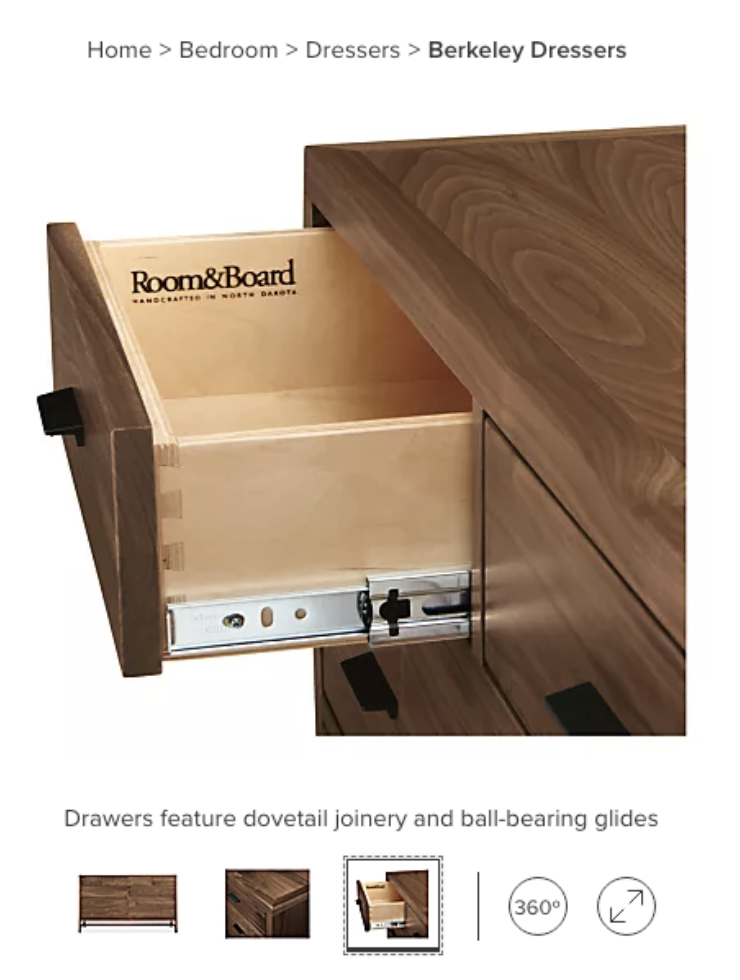
Remember to markup other images on your page beyond the product gallery. For example, The North Face has alt text for the two icons on their product page: “our most sustainable product” and “recycled content.” Adding alt text to these images may encourage Google to show their product when people are searching for sustainable clothing.
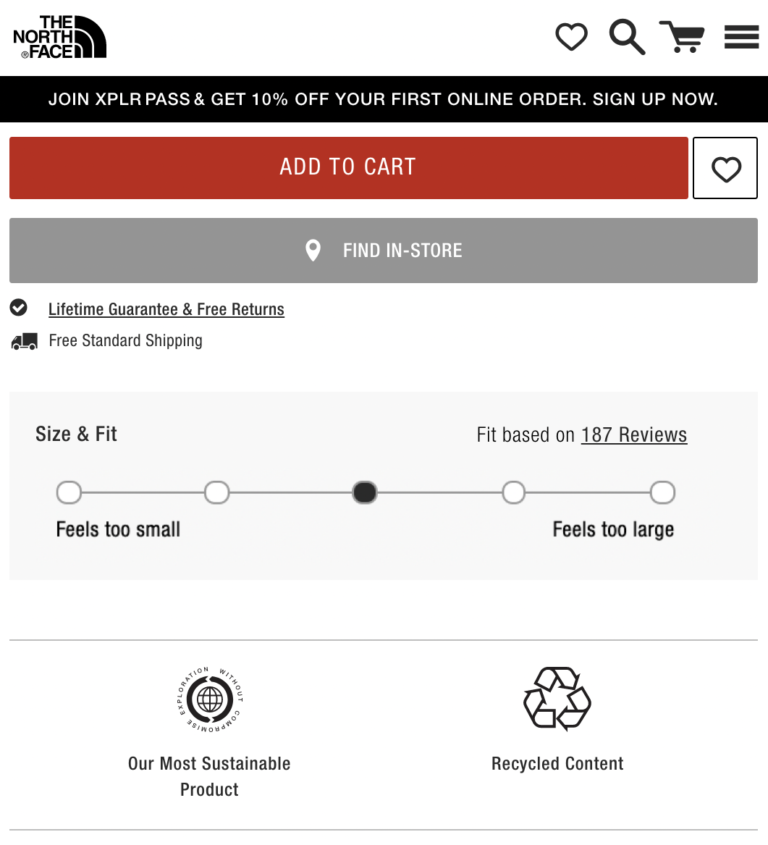
4. Use a clear URL structure
There’s one more thing that shows up in the search results: your URL.
URL structure is an afterthought for many brands, with the developers left to do whatever feels most logical to them. However, a clean, clear URL structure can make the difference between Google crawling your web pages with ease… or getting lost somewhere along the way.
You want to avoid URLs that look like this:
www.yourbrand.com/us/shop/products/123/product-catalog/xty-1222
Whew, that’s stressful Looking at that URL, I have no idea what the page is offering. I can tell that it’s an ecommerce site, but that’s about it.
SEO-friendly URL structures, on the other hand, look something like this:
www.yourbrand.com/products/category-name
www.yourbrand.com/products/category-name/sub-category-name
www.yourbrand.com/products/category-name/sub-category-name/product-name
As you can see, there’s a clear hierarchy to this hypothetical website. These URLs say, “Hey, Google. We are a retailer and we list products on our website. You can find them via these category, sub-category, or individual product pages.”
Depending on the size of your catalog, you may not need multiple levels to your URL structure. For example, Clif Bar has one level. Look at these simple, keyword-rich URLs:
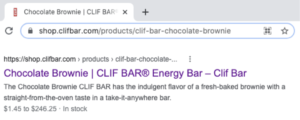
When you have a large product catalog, though, it becomes really helpful to have the different levels, as you can see in this example from Ace Hardware:
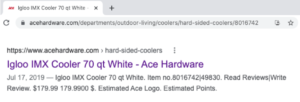
When you have a clear URL structure like this, Google will often display breadcrumbs with your search result. In the Ace Hardware example, that’s the “hard-sided-coolers” above the title tag. That breadcrumb information confirms to potential customers that they a) have the type of cooler they’re looking for and b) have enough of a selection for it to warrant its own category. That’s the kind of information that encourages more clicks and better SEO!
Beyond having a clear structure, you can boost your product page SEO with a SEO-first internal linking strategy. Link to your bestsellers in blog posts, and link to related items or product categories in carousels on your product pages. This improves the discoverability of these products, and gives Google additional semantic meaning about the relationship between these products.
For example, on the product page for their Advanced Night Repair Serum, Estee Lauder links to related products that speak to the same pain points, like their Advanced Night Repair Eye cream.
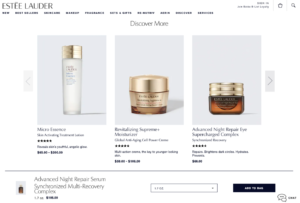
Also keep an eye out for what other products customers mention in their reviews. For example, let’s say you’re an outdoor clothing retailer. Do reviewers regularly mention one of your jackets in their reviews of your hiking boots or hiking pants? Feature that jacket in your Related Products carousel.
5. Implement schema markup
Think back to the last time you were shopping online. Have you ever noticed how the search results for products look different than normal results? For example, they often display star ratings, price, and in-stock information.
Once you start to look for them, you’ll notice these stars show up all over Google:

This extra information, especially the stars, is called rich snippets. Rich snippets stand out to shoppers browsing the Google search results. Rich snippets also expand the size of your search result. Either way, searchers are more likely to click through when they see them.
To enable rich snippets, you need to add schema markup to your website. Schema is code that speaks the search engine’s language and tells them key information about your product, like its price, availability, ratings, and more. To improve your product page SEO, consider adding these schemas to your product pages:
If you’re a PowerReviews customer, good news! We already take care of this for you. Our Review Display comes with schema markup built in.
Image & Video
Today’s shoppers depend on visual content — including photos and videos — to make informed purchase decisions. In fact, 100% of shoppers search for photos or videos prior to making a purchase at least occasionally. And 50% always do so.
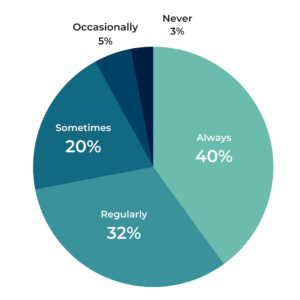
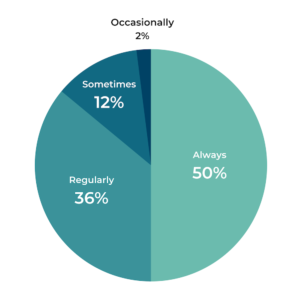
Indeed, visual content has never been more important. In the midst of the Covid pandemic, more consumers are shopping online. Photos and videos help these online shoppers find the products that best fit their needs — even when they can’t access their options in person.

Professional Photos and Videos Alone Won’t Cut it
Consumers have a big appetite for visual content. But not just any photos or videos will fit their need.
You probably already capture beautiful, stylized photos and videos of your products. That professional content certainly has a role to play, but it’s no longer enough. That’s because 99%of consumers specifically seek out photos and videos from others like them before making a purchase – up from 88% in 2016. In addition, 77% always or regularly seek out this content.
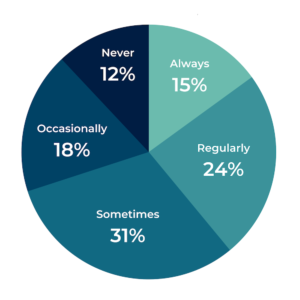
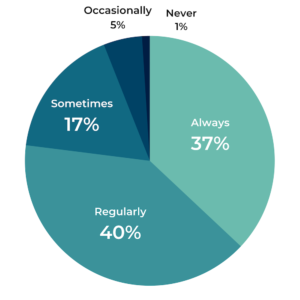
User-generated visual content is authentic — and shoppers trust it. In fact, 65% of shoppers indicate user-generated imagery is more authentic and “real” than brand-created imagery. What’s more, this imagery allows shoppers to understand what a product looks like “out in the wild,” being used by someone like them. And that helps them make better purchase decisions.
User-Generated Imagery Boosts Sales
Shoppers depend on photos and videos from others like them. And brands and retailers that collect and display this content are rewarded.
Based on data across our customer base, we’ve found that when a visitor interacts with user-generated photos or videos on a product page, there’s a 91.4% lift in conversion.
Here’s the bottom line: if you’re not collecting and displaying user-generated imagery, you’re losing customers to brands that are.
In fact, a third of Gen Z shoppers and 21% of Millennials report they’re less likely to purchase a product if they can’t find photos or videos of the product from other customers.
User-Generated Photos and Videos Fuel Smart Purchase Decisions
Collecting and displaying visual content from your customers is an important way to help future shoppers make informed purchase decisions. Why should you care? Because when shoppers make informed purchase decisions, they’re more likely to be satisfied when their products arrive in the mail. And that means they’ll also be more likely to:
- Keep the product. That’s one less return for you to worry about.
- Write positive reviews. That content will help future shoppers make smart purchase decisions — and boost your conversion rate.
- Be a repeat customer. That’s great news, because it’s cheaper to nurture an existing customer than to acquire a new one.
Customer Imagery Influences Purchase Behavior
User-generated visual content fuels informed purchase decisions in a number of key ways. Let’s take a closer look.
Visual Content Builds Trust
Today’s shoppers want to buy from brands they trust. In fact, research from Edelman found that 81% of consumers must be able to trust a brand before making a purchase.
Collecting and displaying photos and videos from your shoppers is one way to earn that trust.
In order to boost sales, brands post sleek, glossy photos that show off their products in the best light. But consumers post realistic photos that show products in real situations — and they have nothing to gain by doing so. And other consumers trust this content.
Research tells us that 80% of consumers find photos from other consumers more valuable than visual content from brands and retailers. What’s more, 42% say that the presence of user-submitted photos and videos boosts their trust in the product or brand.
When you display user-generated visual content, you’re showing future shoppers you have nothing to hide. That’s an important way to let them know you’re a brand they can trust.
Visual Content Sets Realistic Expectations
User-generated visual content allows shoppers to see what your products look like in real life being used by real people. That means there will be fewer surprises when the item arrives.
What’s more, when you display user-generated photos and videos, shoppers can better understand elements of your product that might not be captured in your professional photos. For example, imagine a consumer is shopping for a dining table. They come across this model, which looks promising and is described as narrow.
The measurements are listed in the product details, but then they scroll to the user-generated images and see several photos of the table in different kitchens and dining rooms. The scale is way too big for a small apartment, so they search for something that’s a better fit.
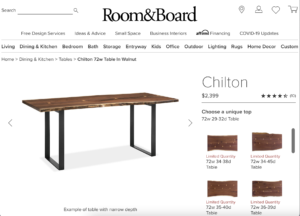
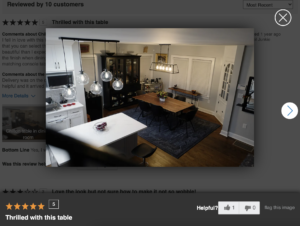
Visual Content Excites and Inspires Shoppers
Seeing photos and videos from other customers gets shoppers excited to try a product. For example, our friends at Canyon Bakehouse sell gluten-free bakery products. Of course, they include a professionally shot image on each of their product pages. But let’s be honest: a photo of a bag of plain bagels isn’t very inspiring.
Enter the power of user-generated visual content. The company encourages customers to share photos of the dishes they’ve made using their products. These photos help future shoppers understand all of the great dishes they can make with the bagels — and that gets them excited to purchase the product. Avocado bagel, anyone?
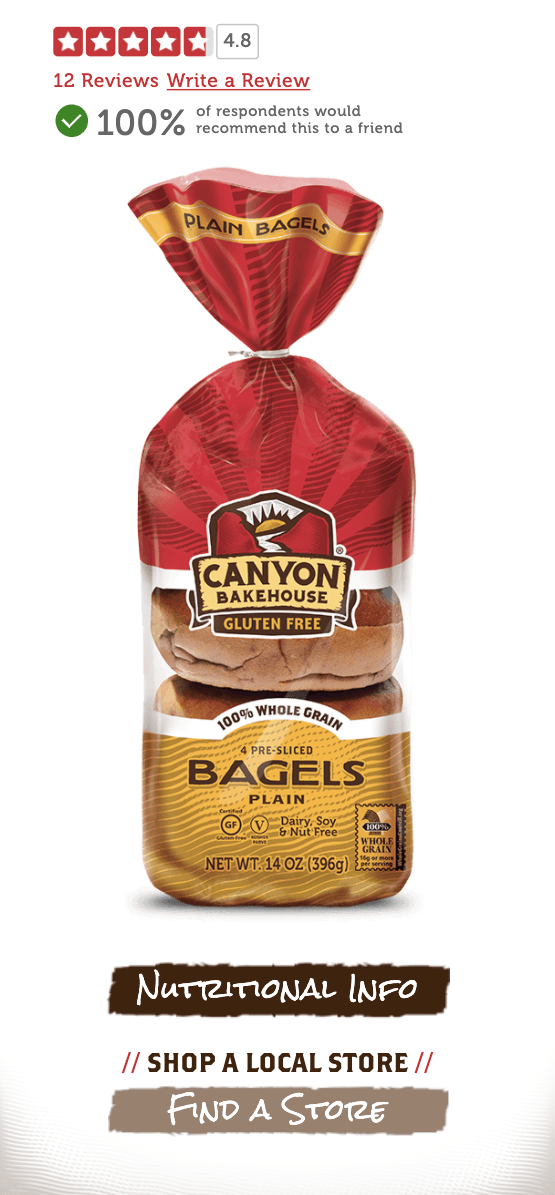
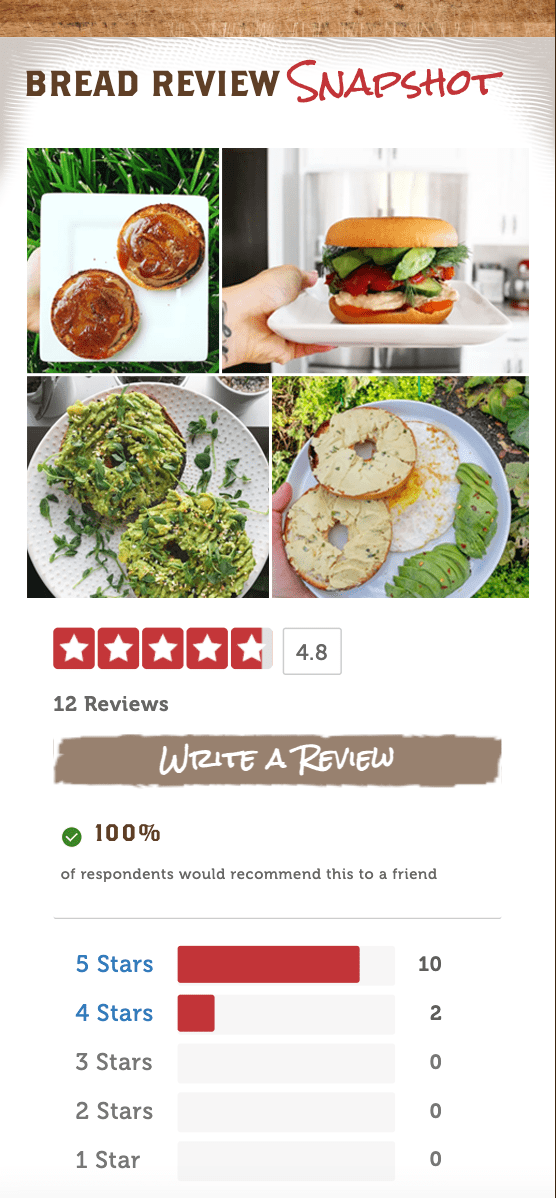
User-generated visual content can also inspire shoppers to add additional items to their shopping baskets — thus increasing your sales. For example, a shopper might be eying this Soren chair from our friends at Room & Board.
They click around the product page and find photos submitted by shoppers who purchased the chair. They especially love how one customer paired the chairs with other items, so they start exploring those items too.
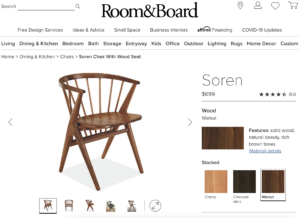

Visual Content Helps Shoppers See What Products Looks Like on Different Types of People
A product like a vacuum cleaner looks the same no matter who buys it. But apparel and cosmetic products look different on different people. For example, a pair of jeans worn by a 6 foot tall model won’t look the same when they’re worn by a shopper who’s a foot shorter.
User-generated visual content helps apparel and cosmetic shoppers better understand how a product looks on different kinds of people. Shoppers can find photos and videos submitted by people with similar characteristics to them. And that way, they can identify the products that’ll work best for their unique needs.
For example, let’s say a consumer is shopping for eyeshadow from Juvia’s Place. They can see how a particular eyeshadow looks on shoppers with similar skin types and tones. And by doing so, they can find an option that’ll likely work for them.

Or maybe a customer is shopping for a sweater from Athleta. But the profesional photos show the product on a slender model, and the shopper has a more athletic build. That shopper can scroll through the customer-submitted images to get a better idea of how the sweater looks on someone with a similar body type to theirs.

How to Maximize the Impact of User-Generated Imagery
We’ve explored the important role visual content from shoppers plays in the purchase journey. But what can you do to see the biggest impact from this type of content?
Let’s explore proven best practices that can help you effectively collect, display and analyze visual content — and drive bigger business results.
Generating More User-Generated Imagery
In order to see an impact from visual content, you’ve got to collect plenty of it. Let’s take a look at a few ways to make that happen.

Make it Easy for Shoppers to Natively Submit Imagery
If it’s complicated or time consuming to submit photos and videos, shoppers probably won’t do it. So make sure the entire process is simple.
Shoppers should be able to submit photos and videos to your website directly from their desktop, mobile device or social media accounts.
Request Images via Follow-Up Email
Many shoppers are happy to share the photos and videos they take. But oftentimes, they won’t do so without being prompted.
Be sure to send post purchase emails to your shoppers, explicitly asking them to share photos and videos of the products they’ve recently purchased. It might seem simple, but it’s incredibly effective.
Here’s an example from our friends at Crocs. The post purchase email is short, simple and straight to the point.

Prioritize Image Collection
Oftentimes, photo and video collection is an afterthought. Brands ask for photos and videos — but not until a shopper has already written a review. Here’s the thing: if a customer spends time and effort writing a review, they’re likely to skip right over the visual content submission component altogether.
Instead, ask your shoppers to share imagery and videos before providing a review. And consider making the review portion optional. It’ll help you generate more content — quickly.
Here’s an example of a submission form that puts the ask for visual content first. After the shopper has submitted a photo or video, they’re asked to submit a review, too. But the review component isn’t required.
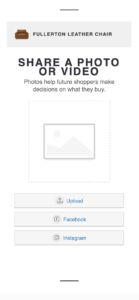
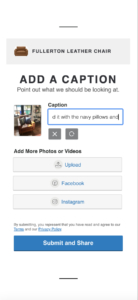
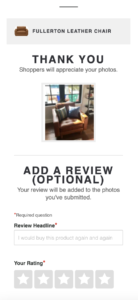
Request Visual Content on Your Homepage
Another great way to generate more visual content from your shoppers is to ask for it — right on the homepage of your website. After all, this is probably one of the most visited pages on your website.
Our friends at Janie and Jack display a beautiful, eye-catching carousel of customer-generated imagery on their homepage — along with a button shoppers can click to to add their own photos.

Those who click the button are taken to a simple form that allows them to upload a photo from their computer or mobile device — or from one of their social media profiles. When they do, their image is added to the image gallery.
Curate Visual Content from Social Media
Up until this point, we’ve been focused on ways to generate more visual content natively. But there’s another simple way to get more user-generated imagery on your website: leveraging the content that’s already being posted by your customers on social media.
As an example, check out all the beautiful photos that have recently been posted, tagging our friends at Shopper’s Drug Mart. This is a treasure trove of authentic imagery the company can leverage to inspire future shoppers — while boosting site engagement and conversion.
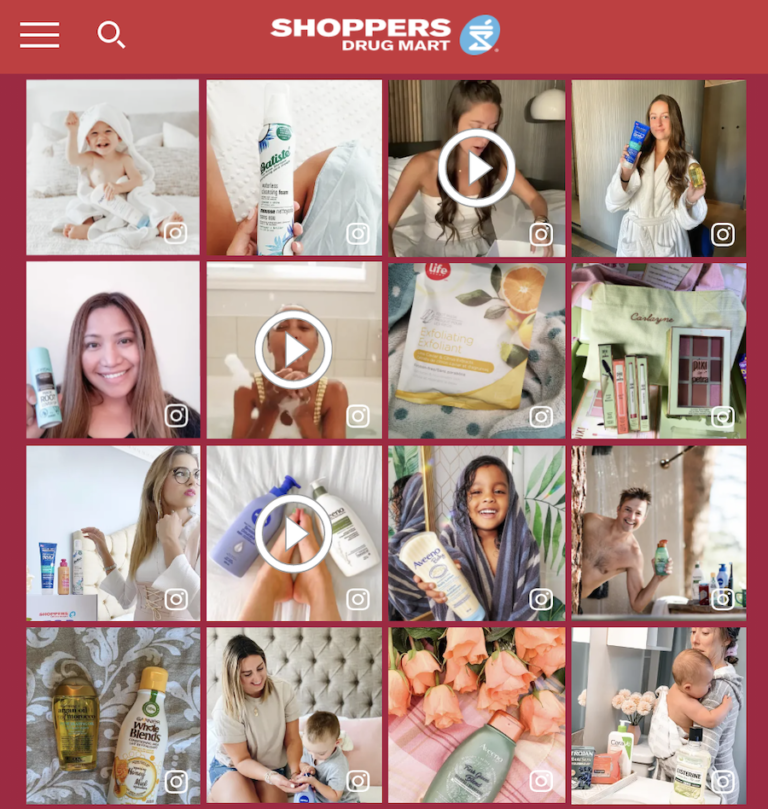
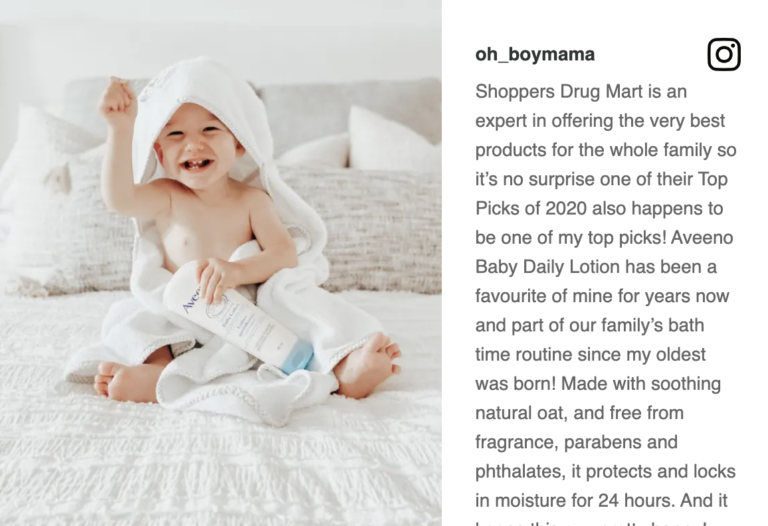
How does it work? Essentially, curating visual content from social media involves a few steps:
- Setting up your campaign, which involves choosing a hashtag, solidifying your legal messaging and terms and promoting your campaign.
- Continuously mining social media for photos and videos you’re tagged in.
- Securing permission to use your shoppers’ photos and videos.
- Repurposing the content on your website and other marketing initiatives.
It sounds simple, but when done right, it’s incredibly effective. PowerReviews customers that curate visual content from social media capture 221% more images and videos than those that don’t.

Amplify the Reach of Your User-Generated Visual Content
You’ve started to collect photos and videos from your shoppers both natively and from social media. Now, it’s time to do something with that content.
Let’s take a look at some proven best practices for getting your user-generated visual content in front of more shoppers.
Prominently Display Content on Product Pages
Perhaps the most obvious place to display your user-generated visual content is on your product pages. After all, when a shopper is researching a product, this content can give them the boost of confidence they need to convert.
So be sure to prominently showcase user generated imagery — both natively submitted and curated from Instagram — in a gallery on your product pages. Here’s an example of a gallery our friends at Gardener’s Supply Company display on a product page for one of their popular watering cans.

Another option is to display your customer-generated content at the top of your product page — right alongside your own professional images and videos.
Here’s an example from dutchbulbs.com. Visitors to this product page can find user-generated visual content right under the glossy brand-provided images. When the visitor clicks on “buyer images & videos,” they’re taken to a scrolling gallery of photos and videos submitted by other shoppers.
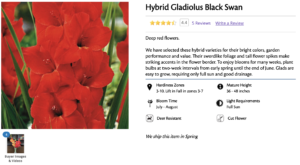
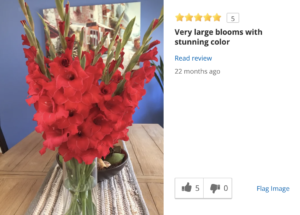
Showcase Visual Content from Shoppers Throughout Your Website
User-generated imagery inspires shoppers — and increases the chances that they’ll convert. So look for other opportunities to showcase this content — beyond the product page.
A great way to do that is to display a shoppable visual carousel on your category pages and your homepage that features content from your shoppers.
For example, when a shopper lands on the homepage for WEBS yarn, they’re greeted by an image carousel, featuring visual content from WEBS customers.
These are typically photos of projects customers have made with WEBS products. When a visitor clicks on one of these images, they can see the WEBS products that were used to create the item in the photo — along with a link to purchase the product.
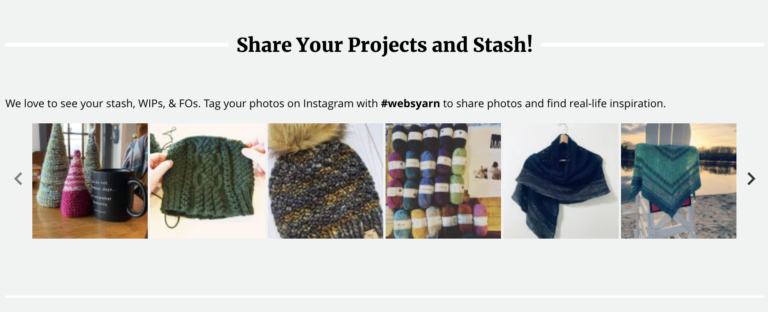
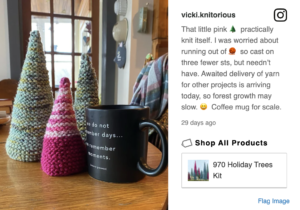
Enhance Other Marketing Materials with User-Generated Imagery
When it comes to displaying the user-generated imagery you collect, don’t limit yourself to your own website. There are plenty of other ways to repurpose this content in your marketing initiatives.
In fact, the possibilities are nearly endless.
Consider including customer-submitted visual content in your digital marketing initiatives. For example, add a user-generated photo to your email campaigns and organic and paid Instagram posts.
This content will capture your audience’s attention and help you earn their trust. And ideally, they’ll be intrigued enough to click through to the product details page to learn more (and find even more visual content from others like them.

There may be opportunities to enhance your traditional marketing initiatives with user-generated imagery, too. For example, consider showcasing a shopper image in your print ads, catalogs or in-store signage. If you leverage outdoor advertising, take a cue from Apple. The company often runs billboards that feature photos taken by customers on their Apple devices.

- Display
- Retargeting
- Organic social media posts
- Paid social media posts
- Catalogs
- Print ads
- In-store signage
- TV commercials
- Outdoor advertising
Analyze User-Generated Imagery to Optimize Performance
You’ve started collecting and displaying photos and videos from your shoppers. But the work isn’t over yet.
Instead, it’s critical to continuously measure performance and identify opportunities to increase the impact of the content you collect. Let’s explore some ways to do that.
Understand the ROI of Your Visual Content
You spend time and effort collecting and displaying visual content from other shoppers. So it’s important to understand the impact this content has on sales.
Be sure you regularly assess performance metrics, including:
- How a specific carousel performs on a specific page type
- Whether a certain image style has more impact than others
- Whether images collected from social media or those collected natively have a bigger impact
Then, use that information to drive improvements to your user-generated visual content program.
Check out chapter 11 for more on how to analyze ratings and reviews, and other user-generated content.
Questions & Answers
Questions & Answers (Q&A) is a natural accompaniment for ratings and reviews content.
More importantly, it’s also extremely powerful when it comes to driving results for brands. But it’s underutilized. Too many brands aren’t taking advantage of this type of UGC, even though it’s super helpful for shoppers — and super profitable for brands.
No matter how you slice it, the stats all agree: Q&A is the most impactful type of UGC on consumer outcomes. Research found that 99% of consumers read Q&A at least occasionally. And our analysis found that there’s a 194.1% conversion lift among visitors who interact with Q&A (up from 157.1% a year previously).
Why? Q&A has become an essential resource for consumers who are now shopping solely online. They can’t touch, test, or feel products before they buy. They can’t hold it in their hands or talk to one of your in-store sales associates.
But they still have questions that need to be answered before being confident enough to purchase.
So any best practice ratings and reviews or user-generated content strategy should absolutely include Q&A as a core component.
What Is Q&A?
Q&A allows prospective customers to, you guessed it, ask questions about the products they’re interested in. Previous shoppers and your own brand experts typically provide the responses.
This content is displayed prominently on product pages. Here’s an example.
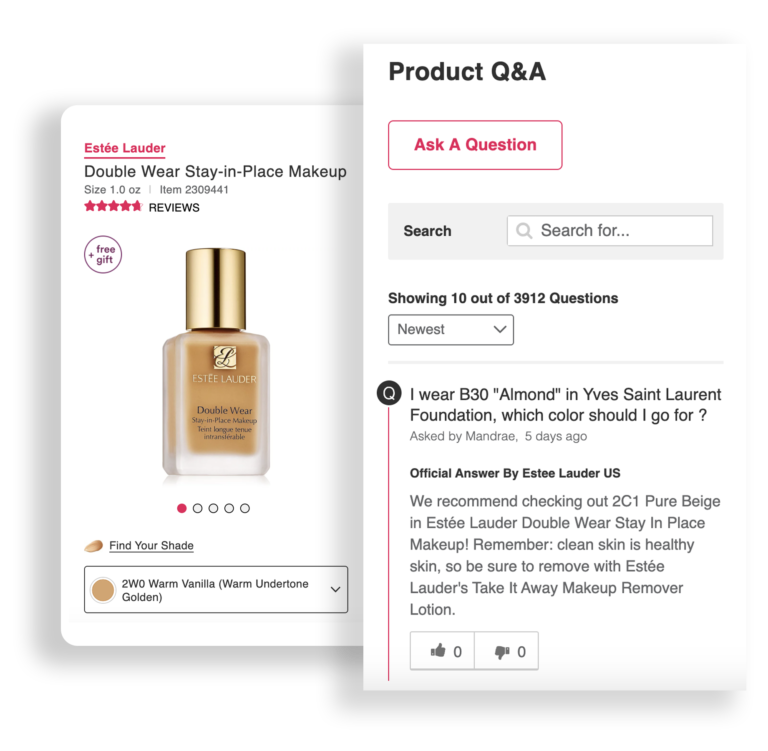
This is an outstanding mechanism for quickly answering customers’ purchase-blocking questions. In doing so, it increases conversions and drives traffic to your product pages.
Why Use Q&A?
No matter how detailed your product description is, some shoppers will still have additional questions they need answered before they’re comfortable enough to buy. And if they can’t get an answer, they’re likely to forgo the purchase.
In fact, 24% of shoppers are less likely to purchase a product if there isn’t a Q&A section on the product page. This number is even higher – 33% – among Gen Z shoppers.
Similarly, 55% of U.S. online adults are likely to abandon their online purchase if they cannot find a quick answer to their question, according to Forrester.
Question and answer content on your product pages is intended to address this issue.
As well as driving more conversions at the consideration phase in the journey, Q&A also drives customer acquisition. How? It has serious SEO benefits.
Consistently filling your product pages with fresh, keyword-rich content enhances your search rankings and drives more traffic to your site.
“Because a customer who submits a question is already engaged, if we can give them the answer they want in a timely fashion, they usually buy the shoe,” shared Tim Lakin, Ecommerce Merchandising Manager at Skechers. “We were able to boost our rankings in Google’s organic search for the keyword ‘shoes’ to be on the first page of results.”
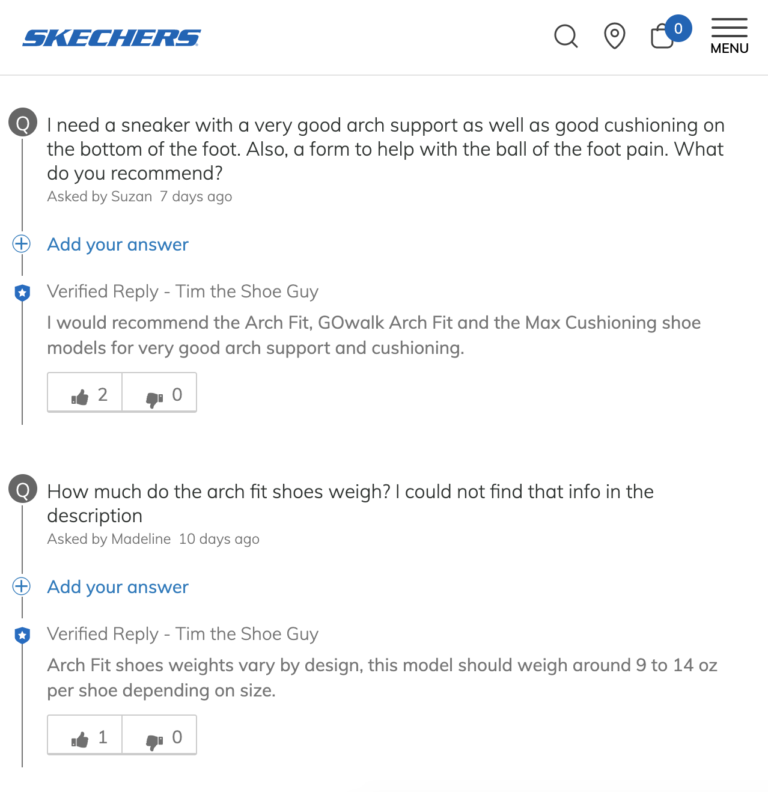
In addition, Q&A helps you identify any recurring questions that shoppers are asking. You can then adjust your product descriptions or messaging accordingly.
Maybe consumers keep asking about the size of the bottle of lotion. As a result, you then add sizing information in the product description to avoid people having to ask those questions. In doing so, you remove a common barrier to purchase.
And last but certainly not least, Q&A has undeniable community-building power. Offering your biggest fans the opportunity to become content creators on your own site – while providing them with a direct communication channel to your business – deepens their relationship with your brand.
For shoppers, Q&A also of course provides extremely authentic validation of your products. As in any industry, having real customers address prospective customer questions is about as convincing as it gets.
Best Practices for Collecting Q&A Content
The first step is to add Q&A to your site. But before you do, you need internal commitment to the process.
Q&A can be immensely powerful in driving desired outcomes. But only if customer questions are actually answered. Multiple unanswered questions is way worse than not providing the opportunity in the first place.
Assuming you have the processes and structures in place to support a Q&A program, you should aim to cover some basic bases to get it off the ground.
Assemble your Q&A team
Dedicate some of your internal staff so you can respond to questions quickly. The faster, the better.
If possible, have multiple brand experts available to answer questions. This alleviates the burden on any one person, and relieves customer service reps who may already be stretched thin.
How to get started
Your first step is creating questions. Whenever you add Q&A to your site, or whenever you launch a new product, add the top questions you expect customers to have, along with answers.
You can analyze your existing review content to see if common questions come up, and pre-seed based on that. Check in with your customer service team, too. They may have additional ideas for Q&A.
Beyond that, it’s meant to be an organic process. The whole point is to address genuine concerns from genuine customers. So simply giving them the opportunity to ask by activating Q&A on your site is key.
You could of course run an email campaign to try to expedite the process. But the best content will come organically.
Start small
Not sure about capacity? Don’t launch Q&A sitewide at first. Launch it on your best-selling products. This will provide an immediate sense of its likely impact.
It’ll also give you a baseline for the volume and types of questions you’ll get. You can adjust your bandwidth accordingly as you expand Q&A to other product pages.
Have a system for routing questions
Questions asked on your site can go to different queues based on the type of inquiry. You can keep it simple and route all questions to a general queue, or you can route specific questions to different kinds of people.
For example, you will for sure want questions about shipping to go to a subject matter expert. But you may choose to have product-specific questions directed to a previous buyer.
You could also consider routing questions to previous buyers first, and then to brand experts if they haven’t been answered within a given period of time.
Commit to responding within specified time period
Skechers commit to answering questions submitted via Q&A within three hours. You should aspire to implement similar internal SLAs. The quicker you answer questions, the more responsive you appear to consumers and the more likely the original shopper who asked the question is to buy. Of note, our research found that nearly a quarter of shoppers expect a response to a question posed via Q&A to come within four hours.
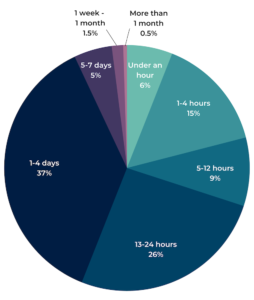
Link to related products in your response
Sometimes the customer may ask about an item that’s been discontinued, or complementary products. Make it easy for them to add more to their cart by linking to the other products in your answer.
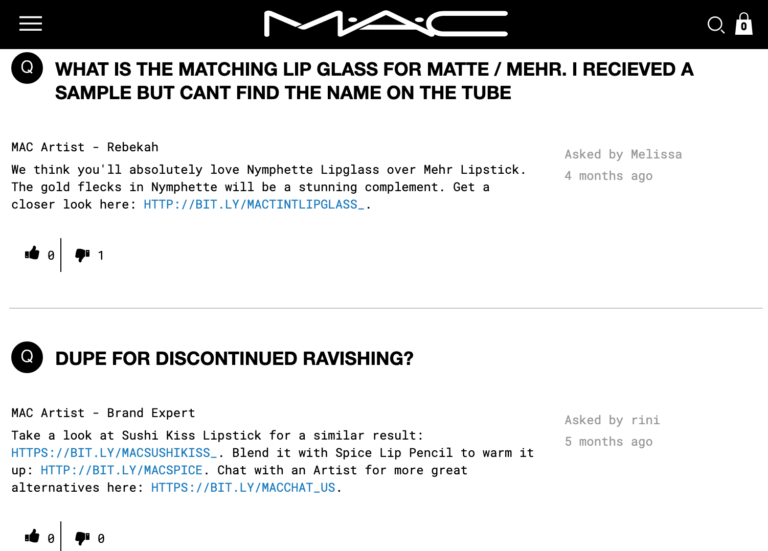
Answer every question
Nutrisystem is committed to answering 100% of their shopper-submitted questions. “Not only does it provide a better shopping experience for shoppers, but it also helps us reduce operational expenses,” shared Kristina Cerminara, Manager of Online Optimization for Nutrisystem.
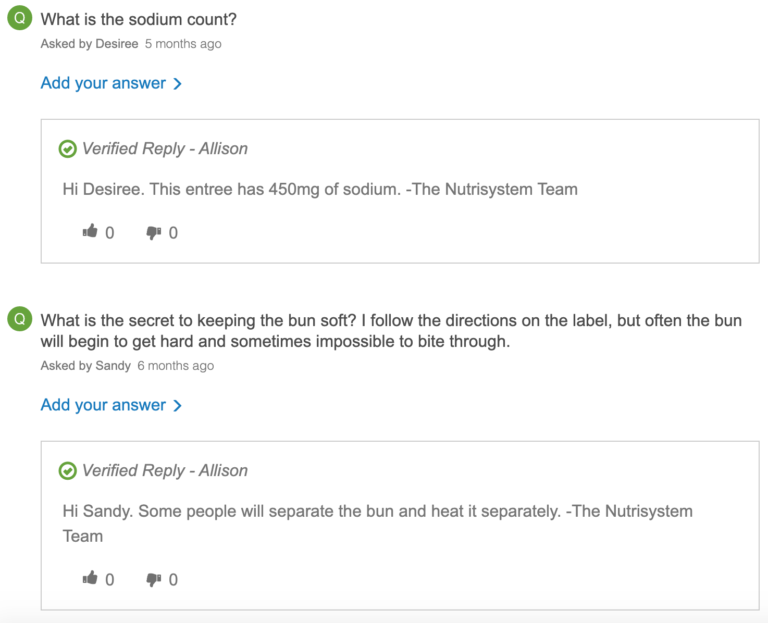
Also encourage answers from your customers
As we mentioned before, letting other customers respond offers your busy customer service team some relief, while allowing shoppers to hear from people like them.
Plus, 94% of shoppers value answers from verified buyers who have purchased and used the product in question. In comparison, 45% value answers from the brand or retailer selling the product.
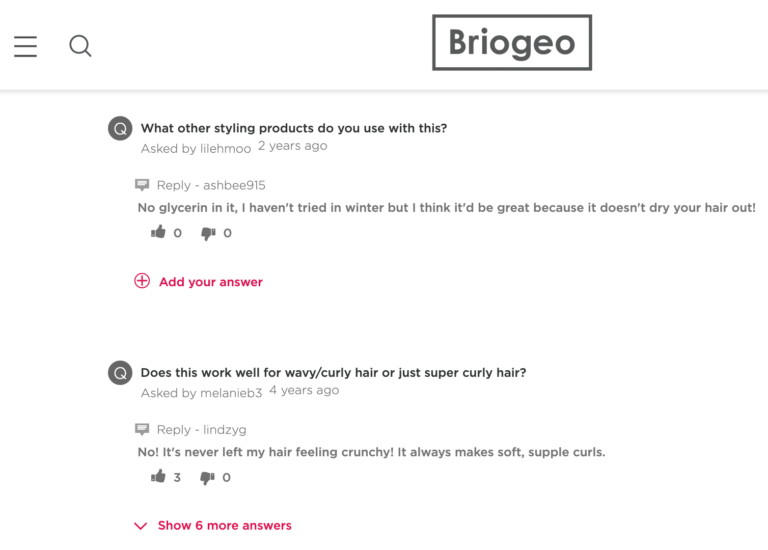
Notify shoppers when their question has been answered
We like to call these answer emails, and customers love them. For brands like Skechers, answer emails boast an 80% open rate and a 51% conversion rate.
Are you a retailer?
Give your brands an opportunity to respond and interact directly with customers via Q&A on your product pages.
This increases shopper’s trust in the answers, making them more likely to convert. It also helps build a community on your site, as you have shoppers, your retailer brand, and the brands you sell connecting with each other.
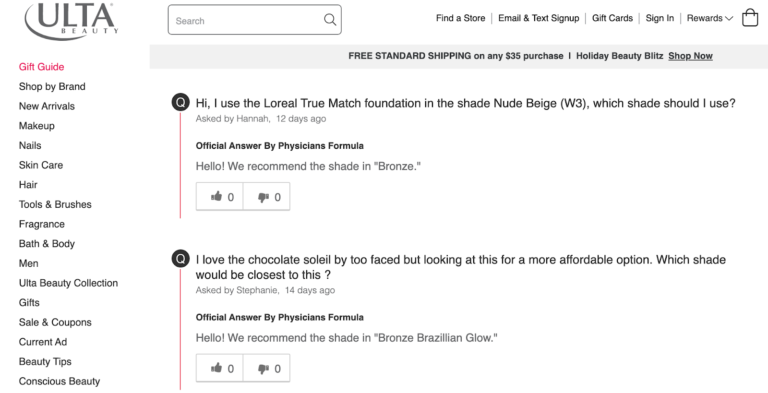
Best Practices for Displaying Q&A Content
When it comes to displaying Q&A content on your product pages, we always recommend some basic tips to get started.
Never lose sight of the objective of Q&A: it’s to provide critical validation and encouragement at the moment of truth.
Get the Basics Right
- Customize the look and feel of your Q&A so it’s on-brand and matches the color and font you use in the rest of your product pages.
- Strategically position Q&A content on the page: Q&A increases overall page flexibility to appeal to different types of consumer by placing UGC in multiple locations.
- Present this Q&A content in an easy-to-follow and bulleted list so shoppers can find information they’re looking for quickly.
Moderate Q&A effectively
Shoppers could ask questions about the wrong product, curse, or include personal information you don’t want to display. You want your Q&A to be valuable, accurate, and authentic. So make sure you have the appropriate moderation processes in place to ensure it hits the mark.
Ensure the answer provided is relevant to the question asked and is for the correct product etc.
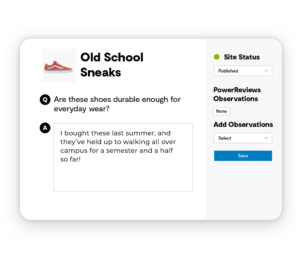
Identify your answers
Brands can allow different people to answer questions, from staff experts to verified purchasers. Show who’s responding to build trust with potential shoppers.
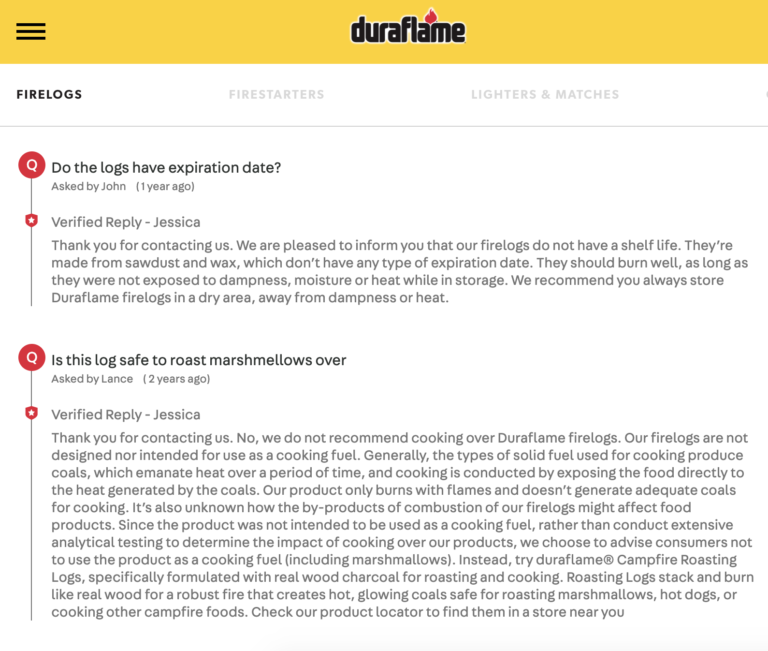
Make your Q&A easy to navigate
As with Ratings and Reviews display, add a search box and filter functionality so shoppers can search terms to see if their question has previously been asked. This becomes especially important as Q&A volume grows.
Analyze: Review Program Optimization
That brings us to the final two chapters of our Guide: leveraging the data incorporated within your ratings and reviews to drive meaningful business improvement.
Let’s start with Review Program Optimization: understanding the impact of your reviews program on revenue and adapting accordingly.
Review Collection Metrics to Analyze and Optimize
1. Overall Review Coverage
Review coverage describes how many of your products have at least one review.
Simply interacting with ratings and reviews lifts conversion by 120.3%, so you want to have reviews for all of your products. Plus, 80% of consumers say they’re less likely to buy a given product if it has no reviews, including 44% who say they simply will not buy a product without reviews.
Email is one of the most effective ways to consistently generate new reviews, so implement a post-purchase email campaign to follow up with customers after every purchase. To ensure new products launch with reviews, run a sampling campaign.
2. Review Coverage by Product
Review coverage by product describes the average number of reviews you have per product.
Review volume is important to consumers, with 79% of consumers “always” or “regularly” considering it when reading reviews. There is a direct, linear relationship between the number of reviews a product has, and the conversion lift it experiences. Over half (55%) of consumers say a product must have at least 25 reviews for them to feel comfortable making a purchase.
Review your analytics to see which products fall below your average review coverage. Then spin up dedicated campaigns to boost review numbers for those products.
3. Review Recency
Review recency refers to how old your most recent product reviews are.
Review recency may be even more important than review volume, especially when purchasing a new product or brand. 64% of consumers say they would be more likely to buy a product with fewer, more recent reviews than one with a large volume of reviews older than 3 months. How recent is recent enough? Roughly half of consumers prefer to see reviews written within the last month.
Send post-purchase emails at the right time. We recommend 7 days later for seasonal products, 14 days for perishable and soft goods, and 21 days for hard products. This way, the product is still fresh in their minds, but the consumer has had sufficient time to provide a thoughtful review.
4. Review Length
Review length refers to the character count of your reviews.
Consumers overwhelmingly find longer reviews to be more helpful because they contain richer detail and more relevant information. They also tend to contain more keywords, which gives your SEO a nice boost. Our research shows that reviews of 500 characters or more have the largest impact on conversion rate.
Add a character counter to your review form. Inspire shoppers to keep writing with encouraging phrases like “Keep going!” and a green progress bar.
5. Reviews by Source
This captures the sources through which you have collected reviews, such as email, social, SMS, or organic traffic.
It’s important to know which channels are your top-performing for review collection, so you can focus your efforts in the places that generate the most reviews. By the same token, if you notice that one channel is underperforming, you can look into it and see what you can do to improve review collection.
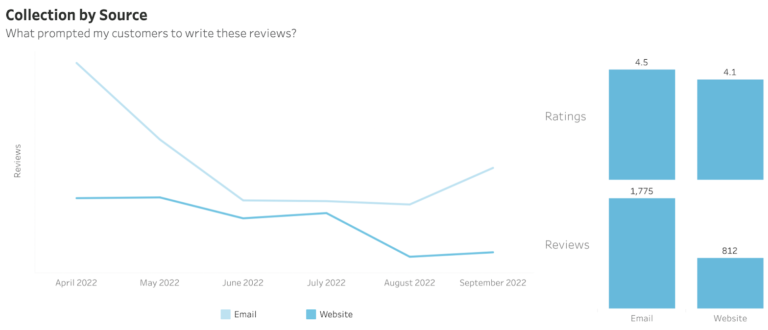
Keep an eye out for trends. Do certain channels drive more positive or more negative reviews? Do some channels, such as text, generate shorter reviews? Consider optimizing your Write-A-Review form or provide yes/no questions they can answer.
6. Reviews by Incentive
This describes the incentive programs you use to collect reviews, such as loyalty points, sampling, or sweepstakes.
Nearly three-quarters (73%) of consumers say they need an incentive to be motivated to write a review. The top incentives include receiving a product for free or before it’s available to the public, or earning discounts or loyalty points with a store or brand. It’s good to track the success of your different incentive campaigns so you can determine which type of incentive is most persuasive to your particular customer set.
Pay attention to how different incentive campaigns affect your review generation and ratings. If one is particularly successful, you may want to regularly run that type of incentive program throughout the year.
7. Review Form Submission Rate
This captures how many reviewers actually complete their review, out of how many started writing a review.
In many ways, the usefulness of your reviews hinges on the success of your Write-a-Review form. Analyzing your form submission rate can reveal potential issues, such as whether the form doesn’t work as well on mobile devices or for certain products.
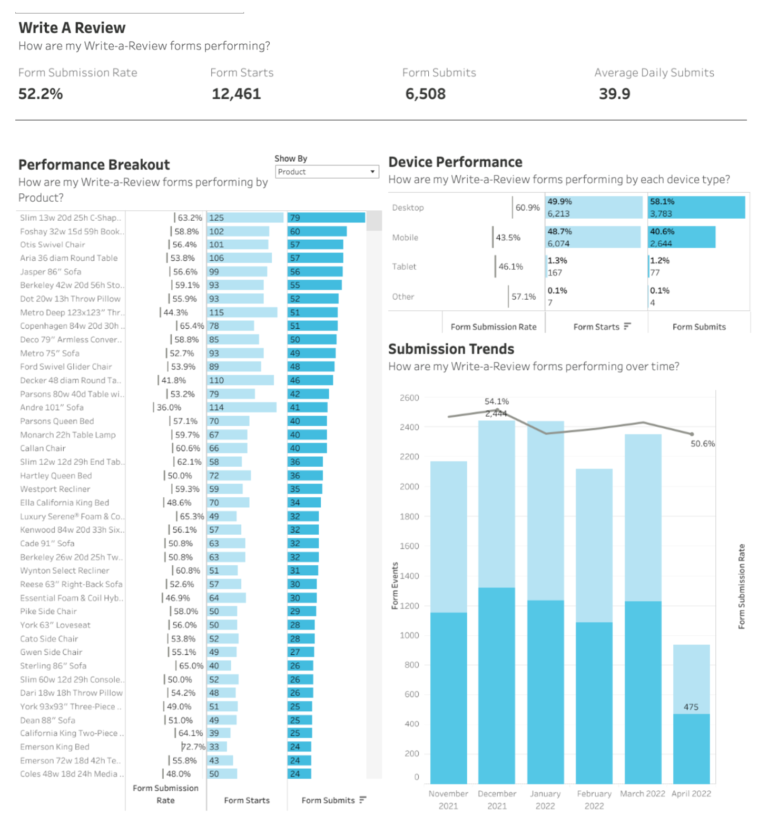
Keep an eye on your review form submission rate. If it suddenly drops on a certain day, or for one type of device, something may be broken. If the review submission rate is much lower on certain products, it may be that some of the questions feel less relevant to that product. You can also experiment with a shorter review form — or making more questions optional — to increase your submission rate.
8. Review Questions
This captures the response rate for individual questions on your review form.
To make their reviews more helpful to customers, many brands and retailers opt to add optional questions to their review form, beyond the standard star rating and blank text box. This is something we always encourage as it improves review quality – which shoppers value highly. However, you want to ensure you are asking the right questions. One way to tell is by seeing the average response rate for these questions, and the average star rating that corresponds with each one.
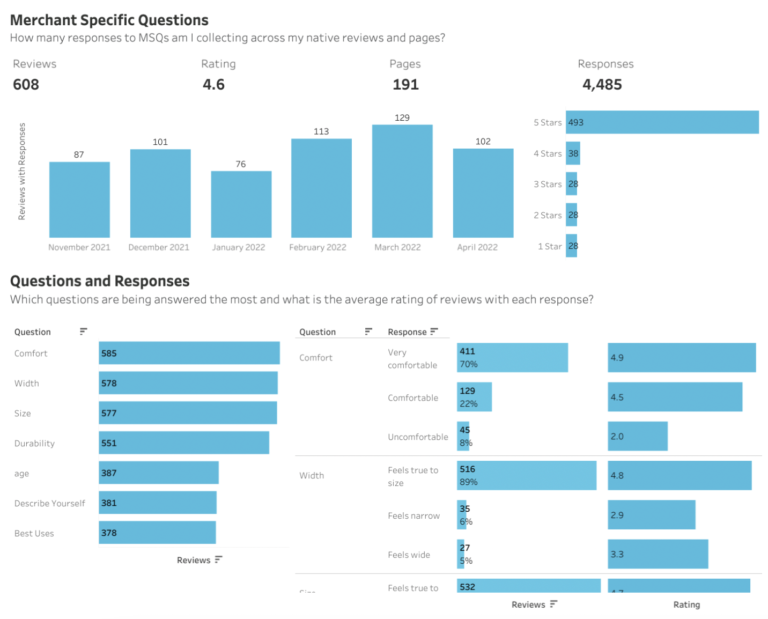
Pay attention to trends with your review questions. If certain MSQs correlate with lower star ratings, that may indicate a product quality issue you need to deal with to improve your ratings — or you may just need to rephrase that MSQ. If you have a hunch you have too many questions on your review form, consider removing some of the less-answered MSQs and see how that impacts your review submission rate.
9. Review Observations
Review observations are rules you set that automatically prevent some content from being published, such as reviews containing profanity or personally identifiable information (PII).
An important part of review content moderation is preventing profanity, PII, and other problematic content from getting published. However, sometimes a reviewer includes some of this content by mistake, like PII — and that can be easily fixed by improving the instructions on your review form.
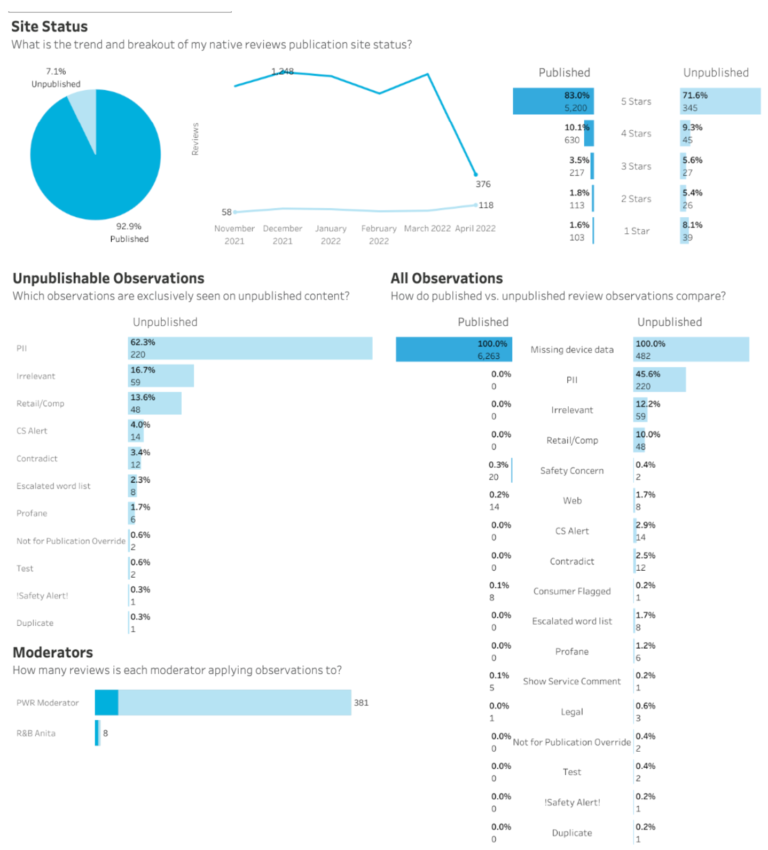
Pay attention to which observations show up often. If you see a lot of PII appearing in your unpublished reviews, consider updating your review form instructions and reminding people not to include PII like their name or location.
10. Review Trends
Review trends describe trends in your native review collection, such as how your star rating, review collection, and review length are trending over time.
Having a bird’s-eye view of how your review collection is going can help you identify potential issues or opportunities. For example, does your review collection soar or slump during certain times of the year?
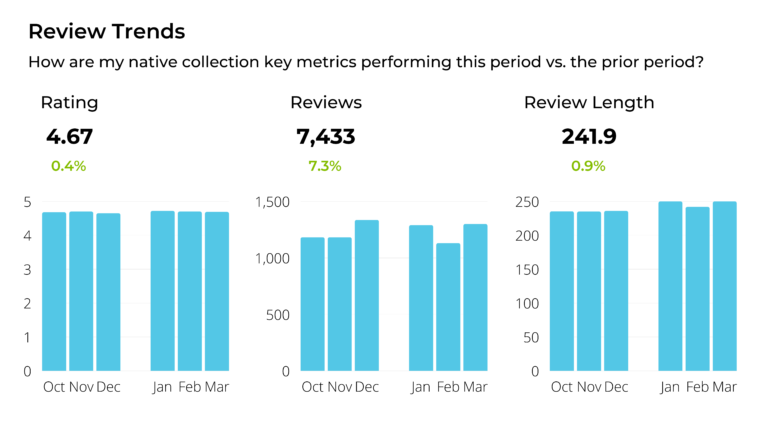
Stay ahead of negative reviews by responding to changes in review trends. If your rating goes down, read the reviews to understand why. If you notice a dip in review length, update your character counter. If you identify slow periods, proactively run a sweepstakes or sampling campaign during that time of year.
Review Display Metrics to Analyze and Optimize
For all your review collection efforts to pay off, it’s important that brands and retailers also consider how they are displaying those reviews to maximum impact. Below, we review ten review display metrics that can provide key insights into your customers’ shopping behavior, and what you can be doing to increase their chances of conversion when they arrive on your product page.
1. Review Snippet Interaction
The review snippet is the star rating and review count displayed at the top of a product page, which customers can click to be taken down to the full Review Display.
There is a 164.3% conversion lift among consumers who click the review snippet, up from a 129.4% lift in 2020.
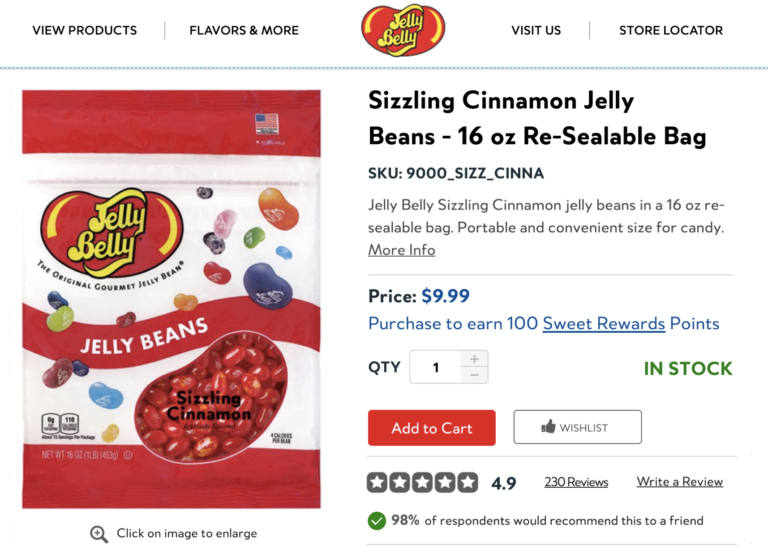
Ensure that your review snippet is located above the fold, at the top of the product page. This prominent positioning ensures that those who want to explore your reviews can do so quickly. Also ensure your review snippet stands out, with brightly colored stars and a clear star rating.
2. Review Interactor Conversion Rate
Review interactors are the people who interact with your Review Display, such as by clicking to read a review, sorting the reviews, or taking some other action.
People who interact with reviews convert at a rate 128% higher than those who don’t — in other words, simply interacting with reviews can boost conversion, regardless of the content. However, watching your review interactor conversion rate can also help you spot key trends. For example, if your review interactor conversion rate starts trending downwards, that may signal an opportunity to improve a product description, implement new product features, or otherwise take action to ensure your products are meeting customer expectations.
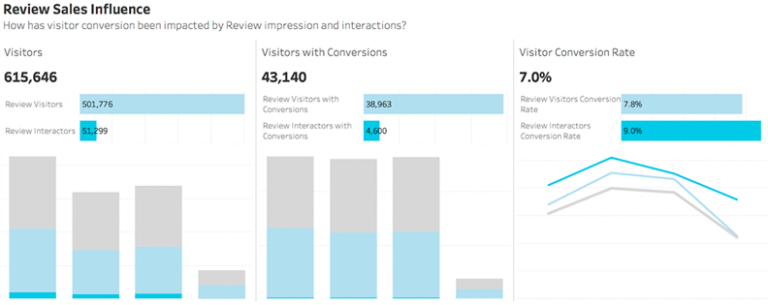
Design your Review Display so that it invites interaction. Encourage customers to vote whether a review is helpful or not. Add clickable filters for common tags (such as pros, cons, or best use case). Include a search bar so they can search for specific keywords.
3. Average Star Rating
This is the average rating for a product, based on all the reviews it has received.
As we deep dived into in Chapter 1, products with ratings between 4.75 and 4.99 stars have the highest on-page conversion rates.
Consumers are actually suspicious of products with perfect 5-star ratings, which convert at about the same rate as products with 3.0 – 3.49 stars.

Regularly requesting ratings and reviews via post-purchase emails is the best way to maintain a positive rating. To improve a low star rating, listen to the feedback your customers provide in their reviews. Once you’ve made improvements, generate new positive reviews quickly through a sweepstakes or sampling campaign.
4. Reviews per Product
This describes the average number of reviews you have per product.
Review volume is important to consumers, with 79% of consumers “always” or “regularly” considering it when reading reviews. And, the more reviews a product has, the higher the conversion lift it experiences. In an ideal world, 65% of consumers would like a product to have more than 50 reviews, including 43% who think it should have over 100.
When shoppers visit your website, you want them to encounter a review count that makes them feel confident buying your product. Put review collection on auto-pilot with a post-purchase email campaign. Optimize your emails by allowing customers to review multiple products at once, from the body of the email, and always send at least two review requests.
5. Helpful Votes
Helpful voting allows a shopper to mark a review as helpful or not, usually with a thumbs up or down sign.
Our research shows that helpful voting is the type of review interaction that has the largest impact on conversion. There’s a 414.3% lift in conversion among visitors who click the thumbs up icon. By monitoring which reviews your shopper finds more or less helpful, you can discover new opportunities to improve your product page. Shoppers may respond positively to product photos from real customers, inspiring you to add a UGC image gallery on your product page. Or, you may find that the most helpful review answers a common question you failed to address in your product description.
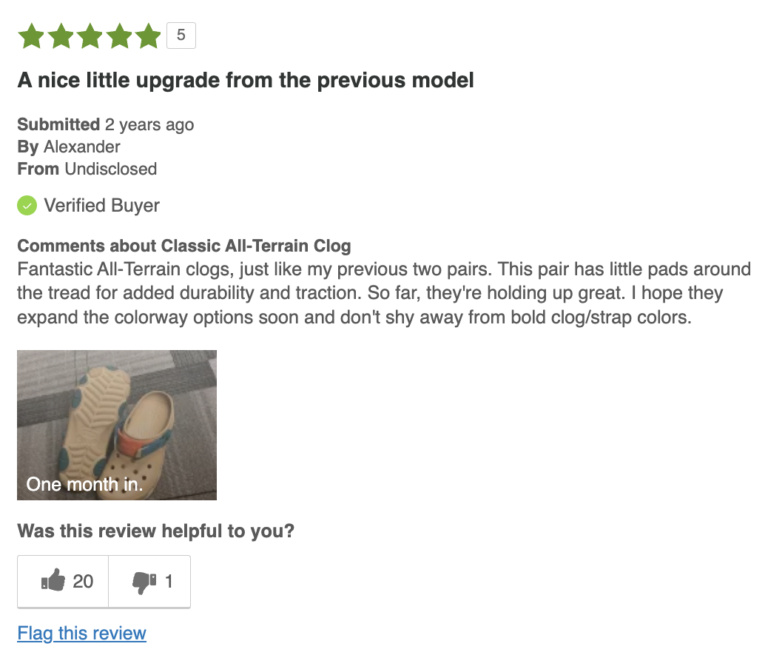
If you don’t already have helpful voting enabled on your product reviews, start by enabling it. Then, check in on the most and least helpful reviews. What are your customers reacting to?
6. Top Search Terms
Many brands and retailers offer a review search function on their Review Display, so customers can hone in on exactly the reviews they’re interested in. Your top search terms include the most common keywords your customers look up when searching through your reviews.
There is a 260.7% lift in conversion among visitors who interact with the review search feature.

Regularly reviewing your top search terms helps you stay in touch with your customers’ top pain points, which you can use to improve your product marketing. For example, you may find that customers are looking for a specific use case related to a product, such as whether a backpack can fit a “macbook” or “laptop,” that you haven’t addressed in the rest of the product page.
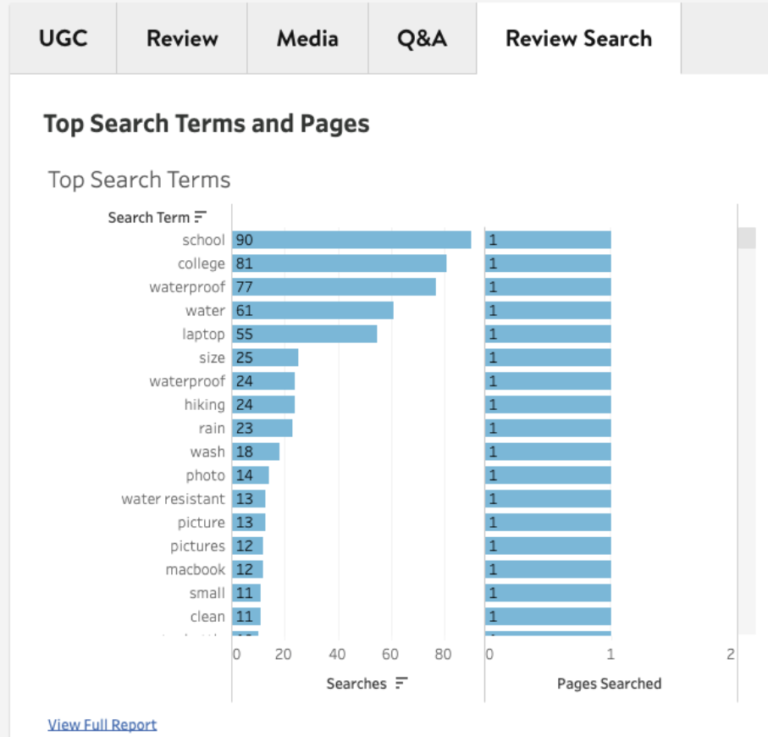
7. Review Filter Interaction
Star filters describe how many people click to filter your reviews by a specific rating, such as 5 stars, while filter tags describe how many people click on specific filters you’ve set for a product, such as “feels true to size.”
Clicking on either of these filters increases the conversion lift of shoppers — by 89.3% in the case of filter stars and 78.6% in the case of filter tags — making them essential elements to include in your Review Display.
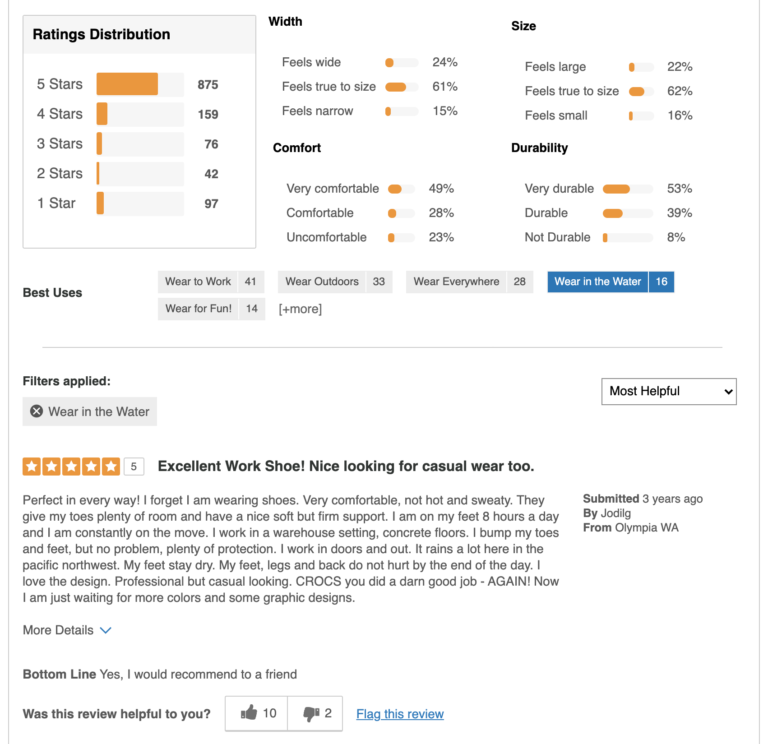
Keep an eye on which filters are clicked most often. Be open to experimenting with new filters to ensure you are making your Review Display as helpful as possible. For example, you may want to update some of your pros, cons, or best use cases with some of the top search terms you find in your review reporting.
8. Most Liked Reviews
Some brands and retailers display a product’s most liked positive review alongside its most liked negative review one, in what we call a review face-off.
Displaying your most liked positive and negative reviews at the top of your Review Display helps shoppers quickly determine the best case and worst case scenarios of a given product. When shoppers click to read the entirety of either of these reviews — positive or negative — the product experiences a conversion lift between 114.3% to 128.6%.

Because these two reviews enjoy such a prominent position on your product page, it’s a good idea to be aware of their content. Plus, both offer insights into the kind of information your shoppers find to be most relevant when making a purchase decision, which may inspire other areas of your product marketing.
9. Review Sort Interaction
This describes how often people click on your review dropdown menu to sort your reviews by sorting options you select, such as Most Recent, Most Helpful, or Top Rated.
There is a 114.3% lift in conversion among shoppers who click to sort reviews, so it’s worthwhile to have this feature enabled. Our research shows that the three types of review sorting behavior that have the highest impact on conversion are Most Recent, Highest Rated, and Most Helpful.
It’s good to keep an eye on your customers’ preferred sorting behavior. Based on what you find, you may change the default sort option to the one they select most often. Alternatively, you may find ways to make those other types of reviews more easily accessible, such as including a filter tag for reviews containing images.
10. Merchant Specific Questions (MSQs)
Merchant Specific Questions, or MSQs, describe the optional questions many brands and retailers add to their review form. These can range from questions about size and fit to demographic information.
Seeing which of these questions are more popular with your customers — and their corresponding star rating — can inform your product marketing efforts.

To make your Review Display more helpful, consider adding filter tags based on the most popular questions. If certain questions correlate with more negative ratings, such as “feels wide,” consider updating your product description.
Web/Retailer Presence (SEO) Metrics to Analyze and Optimize
Factors like review volumes and average rating of course improve traffic volumes. But – in addition – there are some incredibly meaningful nuggets of information you can extract from your review content to further boost SEO and – in turn – eyeballs on your product pages.
Beyond these immediate benefits, analyzing your UGC can also yield valuable insights into how to improve your SEO even further. Insights like:
- What keywords are we missing from our product pages?
- How do we add more keyword-rich content to our product pages?
- How do we improve our rankings on other retailers, like Amazon?
Having the answers to these questions — and taking action on them — can make a huge difference in how you show up in the search engines, and how many shoppers you convert.
Here are seven metrics to focus on.
1. Top Review Search Terms
The Review Search Report reveals the most popular search terms consumers are entering into the search box on your Review Display.
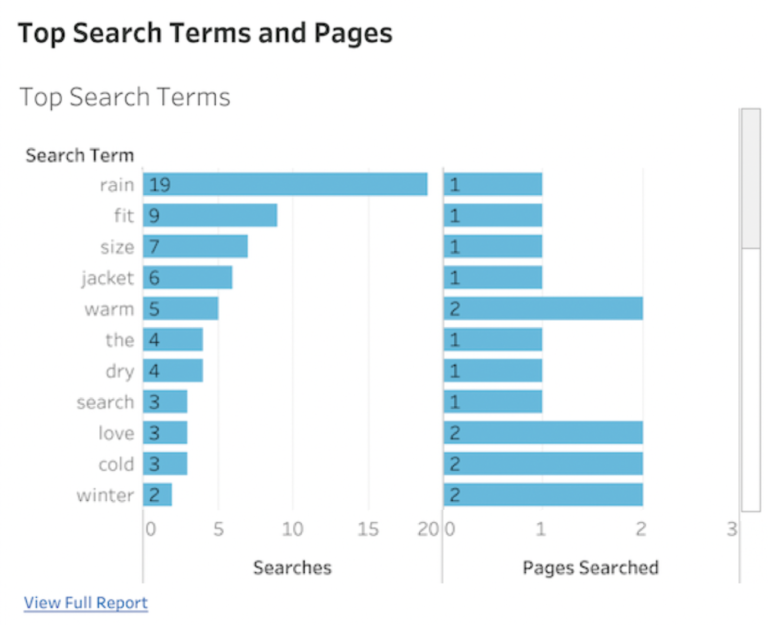
These search terms represent key details that shoppers want to know — some of which may currently be missing from your product description. Adding this information to your product display pages can help shoppers find the information they’re looking for faster. These search terms may spark ideas for product improvement as well.
Regularly review the top search terms and ensure you’re addressing these keywords throughout your product display page to improve your rankings in Google.
2. Products With Zero or Few Reviews
These are products with either no reviews or a low review count.
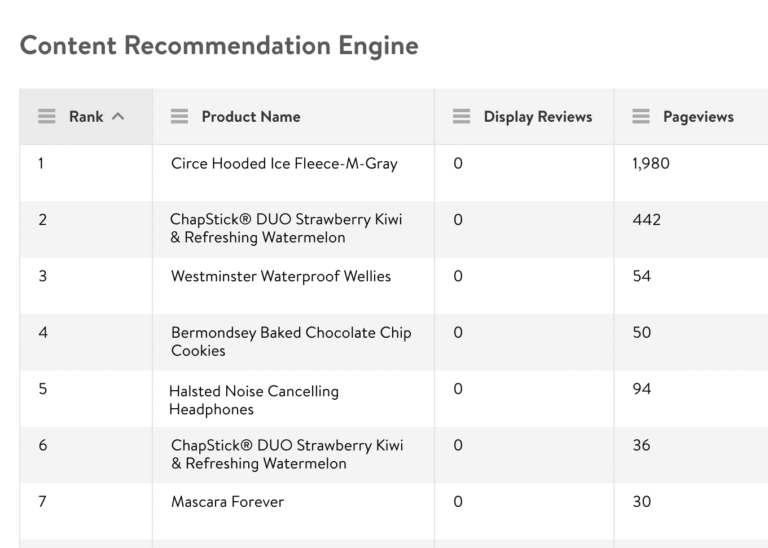
Adding just one review to a product page with zero reviews can lift conversion by 52.2%. Increase that to more than ten reviews, and the conversion rate lifts by 102.9%. Plus - as we already outlined above - Google searchers are considerably less likely to click on a search result that has zero reviews. Pages that have zero or few reviews not only have a tougher time converting customers, but ranking well in Google and catching shopper attention on retailer sites.
Products with zero or few reviews are prime candidates for a dedicated review generation initiative.
3. Review Coverage
Review coverage describes how many of your product pages have at least 1 review. The closer this is to 100%, the better.
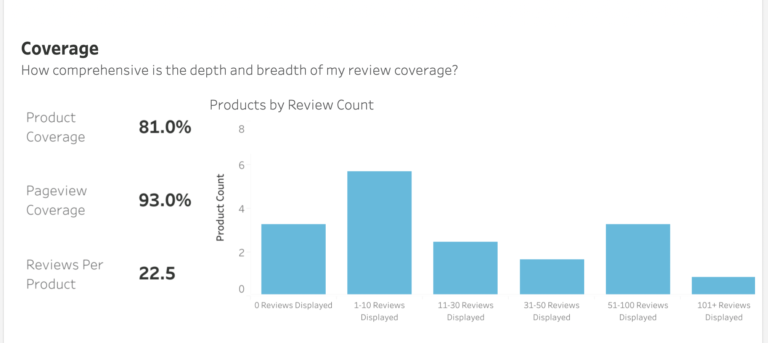
80% of consumers say they’re less likely to buy a given product if it has no reviews. The amount of content on a product page can heavily influence not only the trust a customer has in the product and their likelihood to convert, but also the search engine ranking of the page.
Generate new reviews consistently with a post-purchase email campaigns. As new reviews come in, keep an eye on the top search terms to see what words you can add to your page to grab Google’s attention.
4. Review Sentiment
Sentiment describes how consumers feel about your products, be it positive or negative.
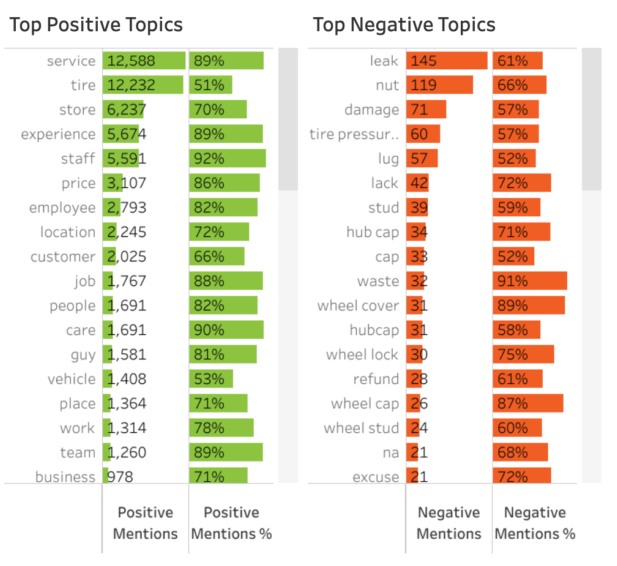
By diving into review sentiment analysis, you can gain insights into what's most important to your customers, and what they love or hate about your products. With that information on hand, you can take action to improve sentiment, conversions, and more.
Consider how people talk about your product to determine the language you should include in product descriptions. For example, features associated with positive sentiment may deserve a more prominent spot in your product description and highlights. On the flip side, if shoppers frequently complain about a particular feature, that may be an opportunity for a product improvement.
5. Q&A Coverage
Q&A coverage describes the amount of Questions & Answers content you have across your site and on each of your product pages.
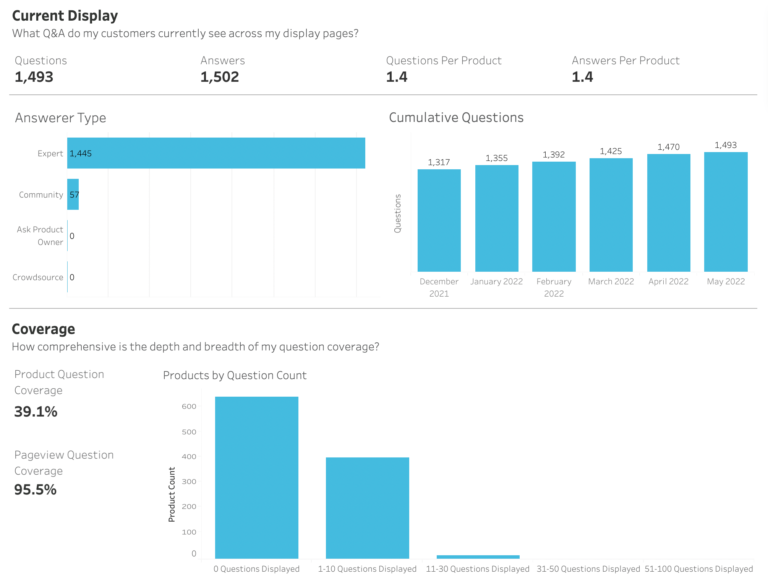
With a stunning 194.2% lift in conversion among visitors who interact with it, Q&A is the most powerful form of UGC. Q&A can answer questions that aren’t covered in your product description, or that perhaps you didn’t realize your customers were asking. Plus, more Q&A means more keyword-rich content for Google on your product pages, which can help boost your visibility in the search engines.
Users aren’t the only people who can submit Q&A; brands can, too. Launch all new products with at least a few seed questions to fill out this space, encourage interaction, and provide more content to Google.
6. Syndication Performance
Syndication performance provides an overview of the review content you share to your retail partners, and the impact those syndicated reviews have on specific partners’ websites.
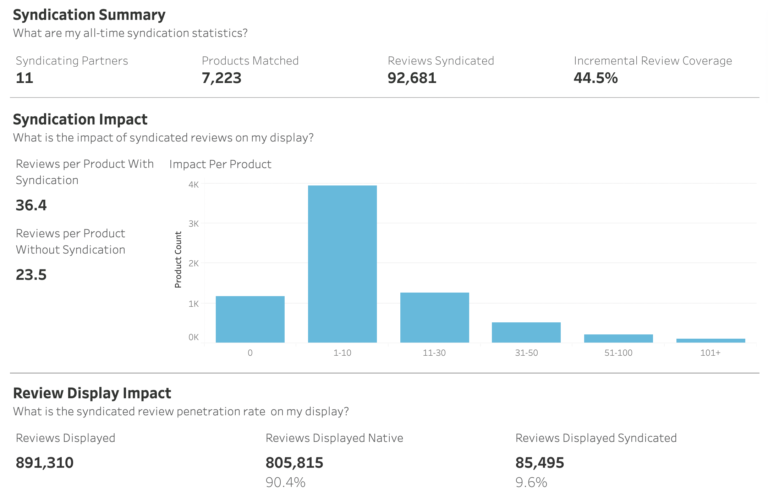
Syndicating your reviews helps to lift conversions for your products on retail partner websites. It also improves the rankings of those product pages in the search results, improving overall visibility for your brand.
By reviewing your syndication performance, you can see which partners are struggling with review coverage, and spin up a dedicated sampling or sweepstakes campaign to generate more reviews for that partner.
7. Share to Amazon Report
At PowerReviews, shoppers can publish the reviews they submit to your site to Amazon with the click of a button. This report shows key metrics related to your Amazon reviews, including the total number of Amazon reviews for your products and the percentage of reviews shared from your site to Amazon, so you can understand how many customers are using this feature.
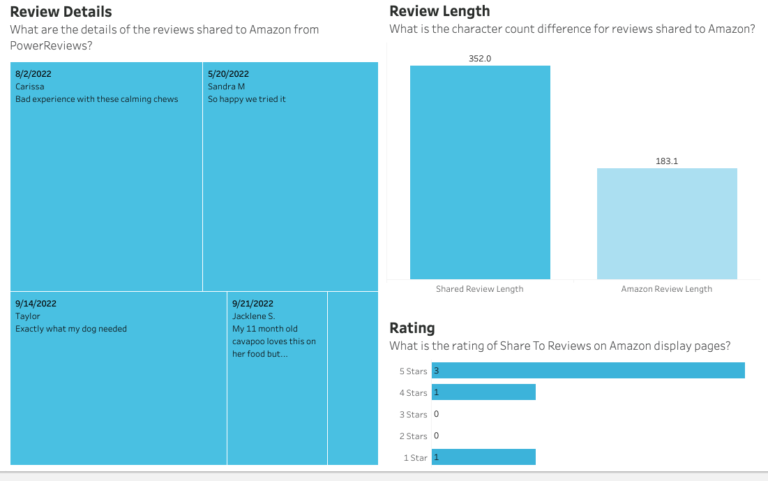
Taking a look at the Review Length and Review details within the report can show you the quality of reviews you collect on your own site versus organically on Amazon. Review length is something consumers care about, with nearly 70% regularly seeking out longer, more detailed reviews.
If your Amazon reviews tend to be shorter than the ones collected on your own website, enabling the Share to Amazon feature can improve your presence on Amazon.
Analyze: Product Optimization
Today, many businesses spend millions of dollars on research projects all aimed at getting to the heart of what their customers are thinking.
Survey programs, customer focus groups, and so on are seriously expensive and often not especially effective.
This is because they generally yield feedback that’s pretty generic. And that makes it hard for them to take any meaningful action.
But UGC is different. You can very directly map specific feedback to specific products and the feedback you receive is meaningful and actionable. It’s also publicly available, meaning you can compare and benchmark your own performance against competitors.
As a result, the most sophisticated UGC programs leverage review data to drive product enhancements. Product Experience Improvement – leveraging the product intelligence contained within your reviews to enhance your products in meaningful ways for consumers and shoppers.
All this means it’s context-rich and – as a result – very actionable. More generic feedback simply cannot provide the same guidance that is as direct.
Product Insights You Can Extract from Your Review Content
Over the past few years, an unprecedented number of consumers have switched brands or retailers, and nearly 80% of consumers plan to continue exploring their options moving forward.
With customer loyalty at an all-time low, competition is steeper than ever. To thrive in today’s crowded ecommerce environment, brands must have a deep understanding of their target customer, and how well they are meeting their needs.
Fortunately, reviews – when analyzed in the appropriate manner – contain a lot of the information you need to understand and improve your products. Here are the seven top insights you can glean:
1. Discover how customers feel about your products
Let’s start with the most obvious benefit: understanding how your customers feel about your products. You can see the top words and phrases customers use when describing your product, and the associated sentiment. This information is crucial for understanding the voice of your consumer (which has applications throughout your marketing efforts). It can also help you discover the quirks of your products that create positive sentiment.
For example, we can see that adjectives like comfortable and versatile are highly associated with positive sentiment for this hypothetical shoe. While words like durable and casual also tend to have positive sentiment, those words also appear in reviews with negative sentiment — suggesting perhaps that consumers may disagree on whether the shoe really is durable, or some may view the casual style as a positive while others view it as a negative.
1. Discover how customers feel about your products
1. Discover how customers feel about your products
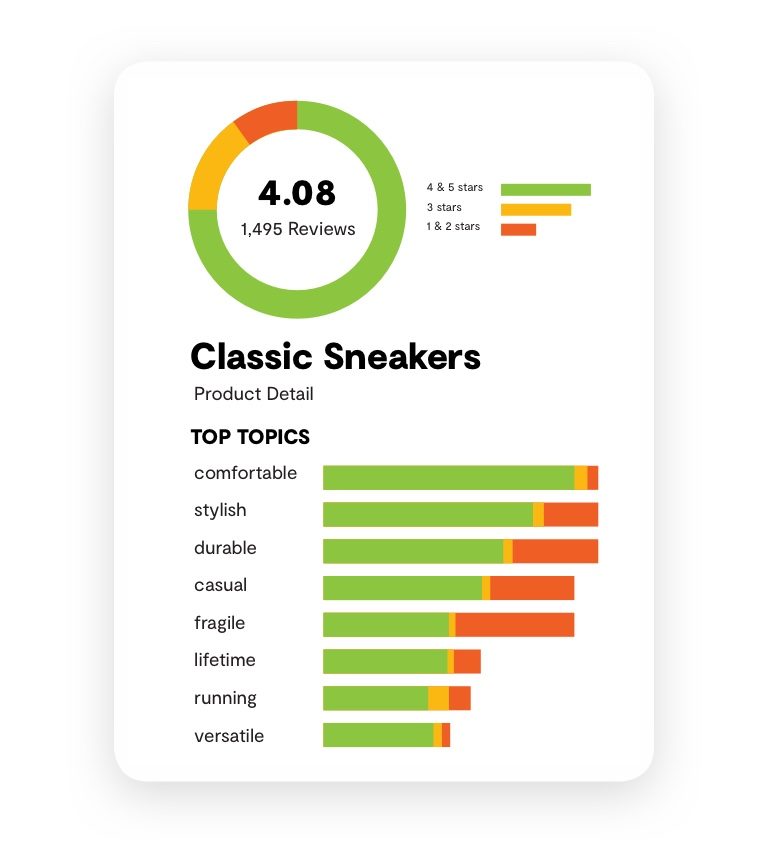
2. Hone in on the right keywords for SEO and Google advertising
Knowing the words your consumers use can also help you reach them more effectively in the search results. Are you targeting the right keywords in Google Ads, based on how your customers search for products like yours? Does your product description tell the best story for SEO? Product Sentiment Analytics can help you find out.
In the example below, we see that customers positively refer to a product as a dog treat, chew, supplement and vitamin, even though the product itself may be described as a supplement. By adding those additional descriptors into the product description — and targeting them in Google Ads — the brand can reach more potential customers.
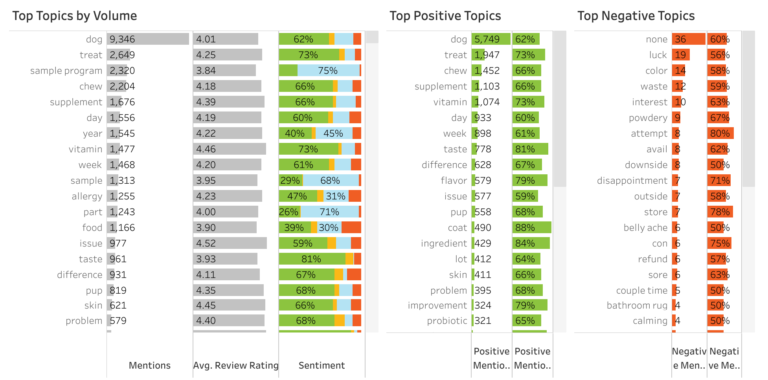
3. Highlight the products and features your customers like most
In addition to boosting your SEO efforts, review content can point you toward key features you should highlight throughout your marketing.
For example, take the review below. If phrases like “arch support” and “treadmill” frequently show up in rave reviews for a pair of shoes, it may be worth incorporating those benefits in your marketing for that product, such as showing a person running on a treadmill in a Facebook post or a YouTube ad.
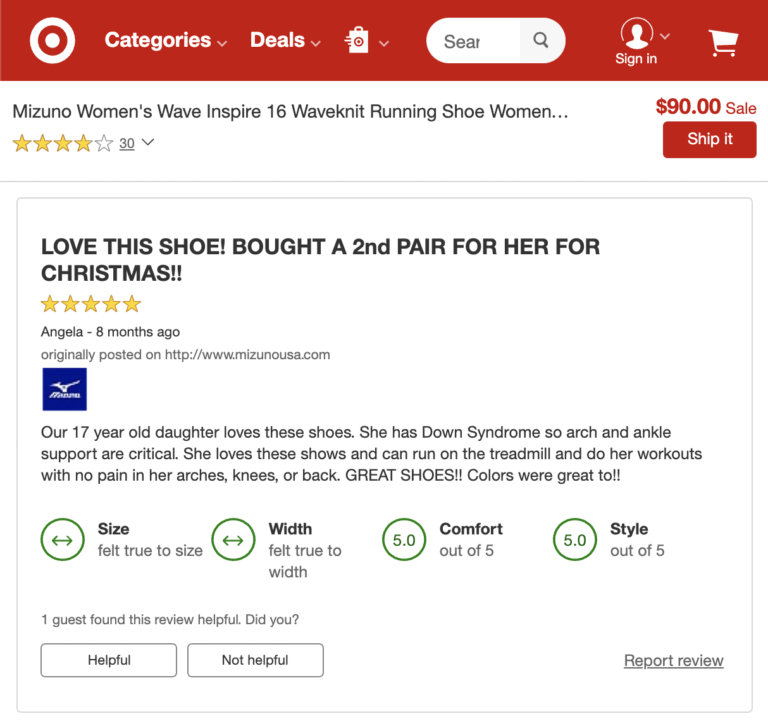
Need more inspiration for how to promote a particular feature customers love about your products? Our Product Sentiment Analytics tool lets you dig even deeper. In the example below, customers generally speak positively about the product’s material.
By clicking on the word material, you can see the top descriptors associated with that word. This product has a flattering fit and makes people feel great and beautiful. Those are great points to include in your product description and marketing!
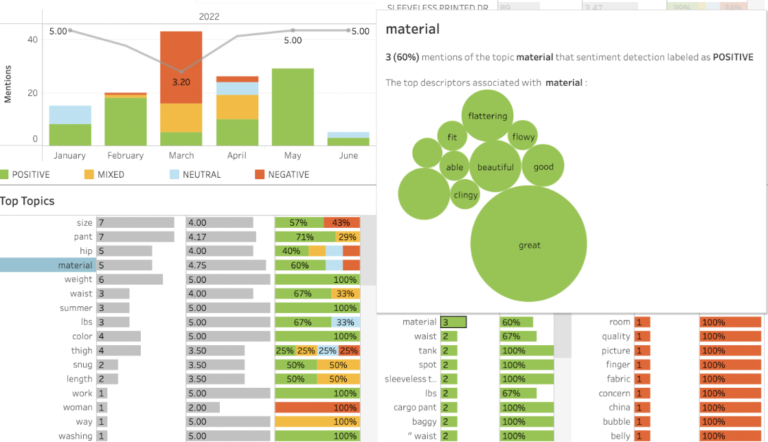
4. Use top descriptors to focus on your next product innovation
Reviews can be treasure troves of product feedback. Mine them, and you’ll find ideas to spark your next product enhancement.
Going back to our dog treats example, it looks like some consumers have issues with the color and the powdery texture. Those are two insights you can take back to the product development team to see if version 2.0 of the dog treats can better meet your customers’ needs.

5. Identify and resolve issues before they get worse
Speaking of customer complaints, negative sentiment can be a veritable “canary in the coal mine” for your brand. A good start: tracking changes in sentiment over time. If you notice dips in sentiment or an increase in negative sentiment, look into it. Did something change with your manufacturing process?
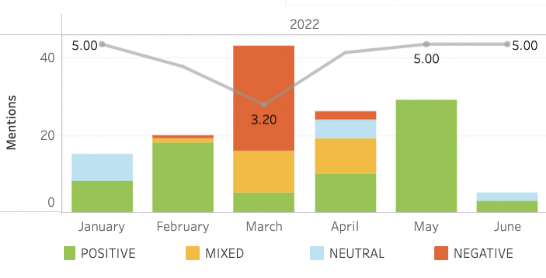
Are sales for an item lower than expected? It’s possible your customers found a flaw that needs to be addressed. Take a look at the top descriptors associated with negative sentiment to hone in on the issue.
By the same token, you can also use this report to see if sentiment improves after you’ve implemented a product improvement.
6. Launch new products with success
There’s always a bit of guesswork involved when it comes to marketing a new product. Sure, it’s educated guesswork, likely based on user research or what you know works for similar products. But still, you don’t know 100% how a new product will resonate with consumers.
Sampling campaigns are a commonly used tactic to boost review volumes and gain consumer buy-in to new products. Measuring the sentiment of these reviews enables you to adjust your go-to-market strategy to make the subsequent launch more successful, answering questions like:
- What are our customers’ favorite features about this product?
- What words and phrases should we use when talking about this product?
- Are there any issues we should fix before launching the product nationwide?
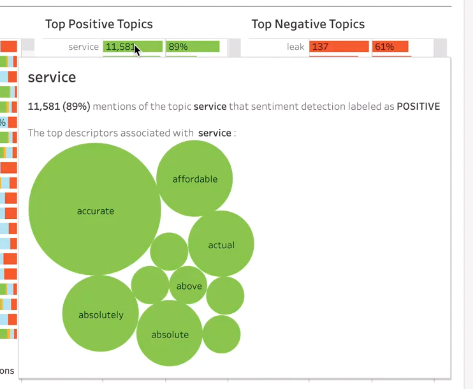
7. Compare sentiment across products, categories, and brands
Also use review data to compare and contrast customer sentiment across your various brands, categories, and products.
Let’s say your company sells tires. Your newest tire, Product D, seems to be struggling but you’re not sure why. So, you compare it against three of your best-selling tires. In your Product Sentiment Analytics, you notice that Product D has more negative sentiment around experience than your other tire products.
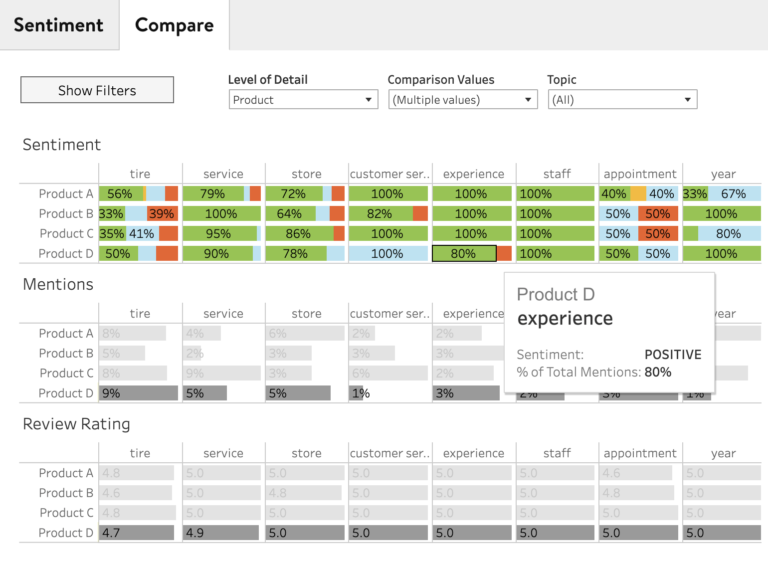
This may signal an area where you may need to make a change. You can investigate further to see whether the reviews that mention a negative experience with Product D are talking about your customer service, the installation experience, or an experience driving out on the road — and make improvements accordingly.
Competitor and Benchmark Insights You Can Extract from Your Review Content
When it comes to UGC, there are a lot of industry benchmarks out there — from what’s considered an ideal star rating to the number of reviews customers expect to see (in fact, we extensively cover those benchmarks here).
Knowing the industry benchmarks is an essential first step. To take your UGC strategy even further, however, you need insights into your particular niche. What other brands are your customers considering? How do consumers feel about their products in comparison to yours? Do your competitors have more reviews than you, or higher ratings?
To boil it down: how exactly do you compare on the digital shelf – be this on search engines, retail channels and so on – to your competitors?
Having the answers to these questions — and taking action on them — is the only way to truly stand out. Fortunately, customer product reviews contain the information to help you find these answers.
Read on as we share seven key metrics to watch to better understand your competitor’s product performance and brand health.
1. Brand Health Score
This provides an overall score of Brand Health, out of 100, based on five weighted factors: review volume, review rating, review length, review recency, and reviews per product.
Knowing your Brand Health Score gives you a quick, bird’s-eye view of the review footprint of your brand.
To improve your Brand Health Score, increase review collection across the board, paying special attention to products with fewer reviews and lower ratings. Implement a review meter and prompt questions to encourage people to write longer reviews.
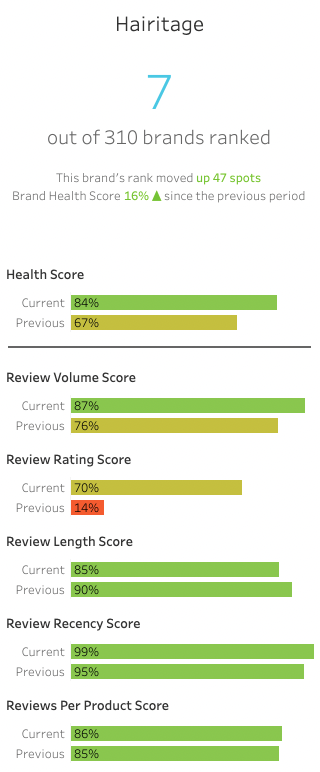
2. Brand Health Rank
This report shows you where your brand ranks among your competition, based on Brand Health Score. You can also see how your Brand Health has changed over time.
Understanding how your brand ranks among your competition can help you pinpoint where and how your competitors are outperforming you. You can see if they have increased review collection, for instance, or improved their star ratings.
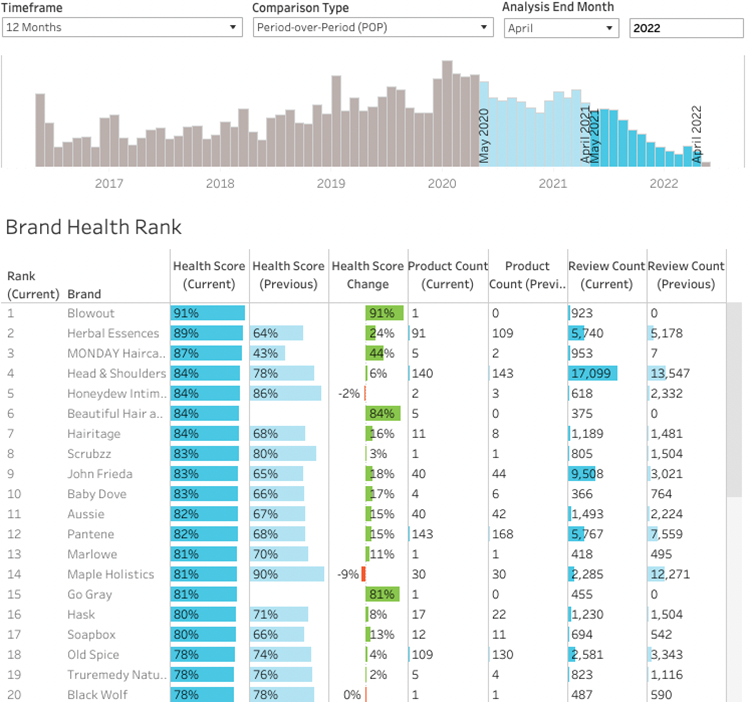
Research the competitors who are ranking above you. Consider them a source of inspiration for improving your own UGC strategy. How are they collecting and displaying reviews? What tactics can you adopt to take them on and ultimately usurp them?
3. Review Count
This is the total number of reviews a brand has across all of its products.
Review volume is a key consideration for consumers, and can be the deciding factor in whether a consumer purchases from you or a competitor. If two products have the same star rating, 64% of consumers say that they are more likely to purchase the product with more reviews.

In the Brand Health Rank report, you can see how many reviews you have compared to your competitors. Run a sweepstakes or sampling campaign to generate new reviews quickly and beat out the competition.
4. Key Themes
These shows you the number of mentions, review rating, and sentiment around custom themes important to your business, such as packaging or price.
This type of sentiment analysis shows you at a glance how customers feel about important aspects of your brand, such as product quality or price. You can analyze key themes for your brand as well as your competitors, giving you insights into areas you can improve and opportunities to stand out.

If you notice a high number of negative reviews related to a theme, dig into the reviews to understand what your customers are complaining about, and take action to remedy those complaints.
Alternatively, you may notice all of your competitors share negative sentiment in a particular area, such as packaging. If you develop and launch a next-level packaging experience, that could become a key differentiator for your brand.
5. Top Topics
These are the top words people use in their reviews around a specific topic, organized by positive vs. negative sentiment.
When you have a lot of reviews, it can be challenging to review them all in depth. The Top Topics Report does the heavy lifting for you, enabling you to zero in on the top words people are using in their reviews in relation to a specific topic, such as customer service, price, or size. You can view the Top Topics for your brand as well as your competitors, providing insight into what they are doing well or not so well.

Review your Top Negative Topics to understand what you need to prioritize fixing first. Then, review your competitors who rate positively around those topics, or look at your Top Positive Topics, to brainstorm ideas for a solution.
6. Average Review Rating
This is the average star rating among all the reviews for a product or brand.
By reviewing your competitor’s average star rating — or by dialing down to their average star rating by product — you can get a sense of how consumers feel about your product compared to the competition.
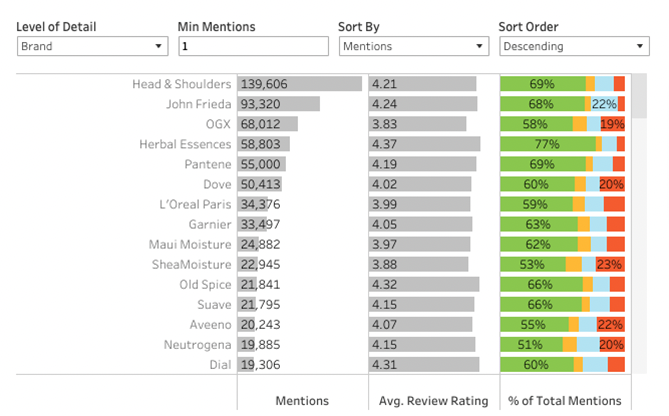
To improve or maintain a positive review rating, regularly request reviews via a post-purchase email campaign. To improve a negative rating, review the common issues and work to address them. Then, once you’ve implemented improvements, spin up new reviews with a sweepstakes or sampling campaign.
7. Product Sentiment by Retailer
The Retailer Product Sentiment report offers all the above competitor analytics — review count, star ratings, and sentiment — on a retailer-by-retailer basis. It's focused on UPC/SKU as opposed to category to provide the most meaningful product comparisons.
This report reveals how your customers really feel about your brand and products, on any marketplace where your products are sold online. With this report at your disposal, you can uncover why a product isn’t selling as well on a particular retailer, or what attributes of your products drive negative reviews.
Brands can also use this report to build a story at a retailer around why a certain product may bring in more incremental revenue to the category based on consumer sentiment.
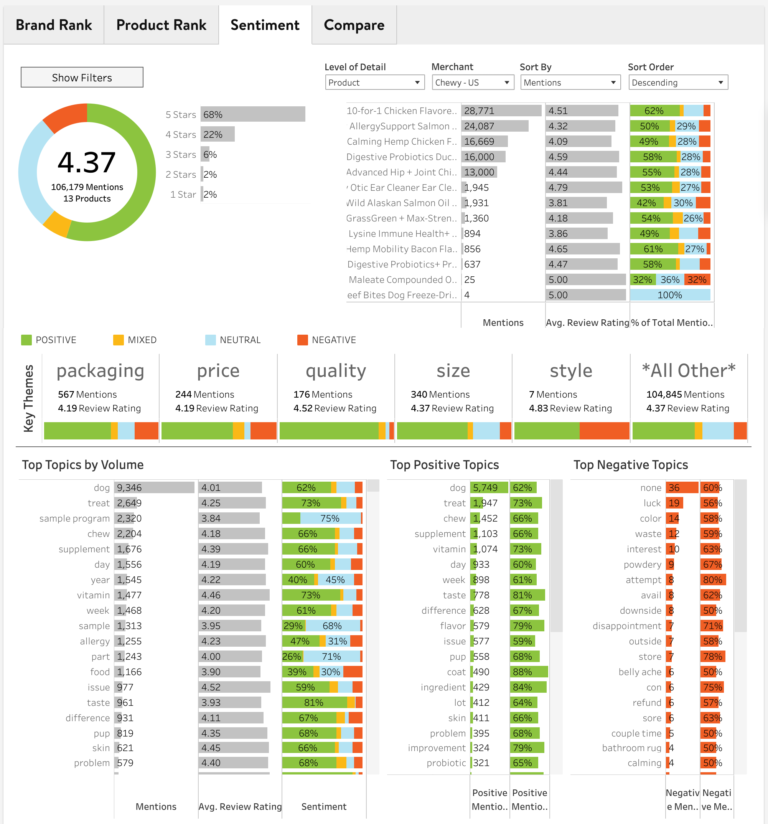
Watch out for red flags (negative sentiment) around key topics or themes. Address those issues, and then run a dedicated review campaign for that retailer to improve your star rating.
This report can also be a useful tool when building your product development or marketing strategy. For example, the Key Themes section shows where more positive and negative sentiment is being bucketed. Your marketing and sales teams can then use this information to guide which product features they choose to focus on, based on how their sentiment compares at the retailer level.
Quick tips for Ratings & Reviews in 2023
This guide is intended to provide you with all the direction you need to run a successful, productive and – most importantly – revenue-generating ratings and reviews program in 2023.
There is a lot of information to digest: there are a ton of elements involved in ratings and reviews after all.
But here are four key areas you should absolutely be focusing on this year:
The data is clear: consumers want longer reviews and more of them. And if you’re able to provide them, you will drive more traffic, conversions and sales. There are tons of things you can be doing to generate high quality content in bigger volumes (check out chapter 2). Our list may seem overwhelming. If so, focus on two or three of our tips and grow from there.
Ratings and Reviews content is a proven conversion booster and traffic magnet. But there are specific enhancements you can make to your displays to maximize its impact. There are also plenty of ways you can incorporate it throughout the rest of your marketing activity to improve its effectiveness (as we demonstrate in depth in chapter 4). Experiment with these in 2023 – and modify depending on what the interaction data tells you – to increase the value of your Ratings and Reviews program.
There’s a lot to do to maximize the value of your Ratings and Reviews content. But all this activity should form part of a broader user-generated content program. Q&A is the single most impactful type of UGC on conversion rates (more than Ratings & Reviews) so you’re hurting yourself if you don’t build it into your overall strategy (see chapter 10). User-generated video and imagery (aka visual media) also makes a huge difference to ecommerce performance (see chapter 9). So you should be looking to incorporate this too.
Perhaps obvious, but worth saying nonetheless: data and analytics should underpin your entire approach and program. The first step is understanding and sizing the impact of all the different elements of your UGC program on conversion and optimizing accordingly (Chapter 11). The second is leveraging your Ratings & Reviews content as a form of customer intelligence (as we outline at length in chapter 12). It’s cost effective, context-rich, actionable and it provides exceptional benchmarking potential.
The most progressive companies will increasingly leverage Ratings and Reviews content to propel business growth – not just in terms of conversion and sales impact but also in terms of providing critical strategic direction.


